

Culinary tourism: The growth of food tourism around the world
Disclaimer: Some posts on Tourism Teacher may contain affiliate links. If you appreciate this content, you can show your support by making a purchase through these links or by buying me a coffee . Thank you for your support!
Culinary tourism is a popular type of tourism throughout the world, but what exactly is culinary tourism? Is it different from food tourism? Why is culinary tourism important? And where are the best places to travel for culinary tourism? Read on to find out…
What is culinary tourism?
Importance of food tourism, culinary tourism activities, culinary tourism in bangkok, culinary tourism in tokyo, culinary tourism in honolulu, culinary tourism in durban, culinary tourism in new orleans, culinary tourism in istanbul, culinary tourism in paris, culinary tourism marrakesh, culinary tourism in mumbai, culinary tourism in miami, culinary tourism rio de janeiro, culinary tourism in beijing, food tourism- further reading.
Culinary tourism, also often referred to as food tourism, is all about exploring food as a form of tourism. Whether that be eating, cooking, baking, attending a drinks festival or visiting a farmers market – all of these come under the concept of culinary tourism. It’s something you don’t even really need to travel to do. Heading to your nearest big city or even the next town over, specifically to eat at a certain restaurant, classes as food tourism! And food tourism has taken a new twist since the COVID pandemic too, when many people would cook or eat a variety of different foods from around the world in attempt to bring an element of travel to their own home! Who said you need to travel far to be a culinary tourist, huh?
Food tourism is a vitally important component of the travel and tourism industry as a whole. When booking a trip, people tend to consider a variety of factors – and food is high on the list of priorities. The World Food Travel Association says that money spent on food and drink while travelling accounts for 15-35% of all tourism spending. Culinary tourism is important in that it generates so much money for local economies.

Culinary tourism is also an important branch of tourism in that it can promote local businesses, as well as help to shine a light on different cuisines. For so many cultures, their cuisine is a huge part of who they are. Culinary tourism helps to celebrate this, by attracting interested tourists who are keen to try something new and share it with the world. In this way, it definitely helps to boost community pride and is a great example of cultural tourism .
This type of tourism is also important to tourists. It provides a chance to try new foods and flavours, and discover new cultures through their taste buds. Visitors who engage in food tourism come away with new recipes to try, new foods to introduce their friends to, and memories that they will always associate with their sense of taste.
There are many activities which come under the remit of culinary tourism, or food tourism. I mentioned some above, but let’s take a closer look.
- Eating and drinking out: going to restaurants, cafes, bars, pubs, tea shops and so on. These are all examples of culinary tourism.
- Food/beverage tours: you can book onto organised food and drink tours when visiting a new city. These are run by guides who will take you to various foodie spots throughout the city – usually small businesses – to try local delicacies.
- Farmers markets: visiting a farmers market at the weekend to buy fresh produce is seen as a form of food tourism.
- Cooking classes: another activity you can get involved with on your travels is a cooking or baking class. You’ll often make, again, a local delicacy whether that be pierogi in Poland or pasta in Italy . Tasting sessions: brewery tours and vineyard visits (and other similar excursions) where you get to take a look at how something is made and then try it for yourself are another form of culinary tourism.
Best cities for food tourism
Most cities, major or otherwise, have excellent examples of food tourism. In fact – this goes right down to tiny towns and villages, some of which have incredible restaurants or bars that are real hidden gems. Below you’ll find some of the world’s best cities for culinary tourism, however, with examples of the sort of thing you can do there!

Thai food is some of the best food around, and Bangkok has a lot of restaurants suited to all budgets. Eating out in Bangkok is a brilliant example of culinary tourism. One of the best things you can do here is try the local street food! Wang Lang Market is one of the most popular places for street food, with fresh food filling the lanes from snacks to full-on meals. Silom Soi 20 is another great spot in central Bangkok, perfect for the morning.
Looking for somewhere really unique to eat in Bangkok? Head to Cabbages and Condoms , a themed cafe decorated with (you guessed it) condoms. The restaurant say they were ‘conceptualized in part to promote better understanding and acceptance of family planning and to generate income to support various development activities of the Population and Community Development Association (PDA)’.

Tokyo is a very popular city, and one of the best ways to experience food tourism here is to book onto a food tour. Tokyo Retro Bites is a fantastic one, giving you a feel of old-style Tokyo at the quaint Yanaka Market. This is a walking tour which includes drinks and 5 snacks, lasting 2 hours. It starts at 11.30am meaning it’s a great chance to have lunch somewhere a bit different!

This beautiful Hawaiian city has so many fun places to eat (and drink!) while visiting. One of the best things to do in terms of culinary tourism is to eat somewhere you wouldn’t be able to eat at home – and try new flavours or dishes. Honolulu is the perfect place to do this. Some interesting eateries include:
- Lava Tube – based in Waikiki, this 60s-kitsch style bar offers pina coladas served in giant pineapples, $5 Mai Tais, delicious food and plenty of fun decor.
- Suzy Wong’s Hideaway – this is described as a ‘dive bar with class’ and is a great bar to visit to watch sports games.
- MW Restaurant – this is a really famous and creative place to eat in Honolulu – the mochi-crusted Kona Kanpachi comes highly recommended and helped shoot the chef, Wade Ueoka, to fame.

Hailed as the world’s best food city, a list of places for food tourists to visit has to include Durban in South Africa . Bunny Chow is a local delicacy that you cannot miss while visiting Durban. It is now available elsewhere, but the original is usually the best so be sure to try some while in the city. The dish is half a loaf of bread hollowed out and filled with curry – delicious. This article shares 5 fantastic spots to get Bunny Chow in Durban !

As one of the culinary capitals of the US, New Orleans is incredibly popular with foodies. The city is a hotspot for food tourism, thanks to the various cultural roots here: Cajun, Creole and French. There is a whole range of tastes to try. You could spend your time here *just* eating and still not scratch the surface when it comes to the amazing restaurants, cafes and eateries in NOLA. Some foods you have to try include:
- Po’boys: fried shrimp, generally, but sometimes beef or other seafood – served on a fresh crusty roll.
- Gumbo : this is a stew, again usually containing seafood, alongside bell peppers, onion and celery.
- Crawfish etouffee: a French crawfish stew served over rice.
- Muffuletta: a Silician-American sandwich served on a specific type of bread.
- Side note, you can do a haunted pub crawl in NOLA . Would you?!

Being split across two continents, it is no surprise that Istanbul as a city has a huge range of delicious food-related activities. From kebabs sold on the street to 5 star restaurants serving the finest hummus, Istanbul is a fantastic destination for food tourism. Book onto the ‘Two Markets, Two Continents’ tour – you’ll visit two markets, as the name suggests, on the two continents. The tour includes a Bosphorus ferry crossing between the two districts of Karaköy (Europe) and Kadiköy (Asia). You’ll enjoy breakfast, tea and coffee, meze, dessert and so much more during this 6.5 hour tour .

The city of love – and the city of bakeries! Fresh baguettes, simple croissants, delicious eclairs… the list goes on. There are so many of them dotted around, whether you want something to grab and snack on while you head to the Eiffel Tower or if you want a sit down brunch, you’ll find one that suits you perfectly.
And that’s not all. Paris, also famous for its snails, soups and frogs legs, has so many fine dining opportunities. You’ll be spoilt for choice in terms of Michelin star restaurants: Boutary, ASPIC, 114 Fauborg and so many more. There are also some fantastic food tours in Paris . If you have the cash to splash out, fine dining in Paris is a brilliant culinary tourism activity…

Moroccan food is delicious. And you can try making it yourself during a cooking class in Marrakech ! Visit a traditional souk and try your hand at some tasty recipes – you never know, you might have a hidden talent. Some tours even include shopping for ingredients, so you can visit a traditional market too; these are a sensory dream with so many smells, colours, sounds and sights.

India is another country where street food is king. Mumbai has plenty to offer, and one culinary tourism activity you can do is to spend an afternoon trying as many dishes as possible while simply wandering through the city. If you’ve never tried a vada pav before, this is the place to do so: it’s essentially deep fried mashed potato in a bun with various chutneys, and it is exquisite. Many people are surprised to learn that one of the most popular British foods – chicken tikka masala is not commonly found in India, but fear not, there are many other dishes that are just as goods or if not better!

Miami is known for its food – and Cuban food is a big deal here. Take a traditional Cuban cooking class , or head to one of the many, many Cuban restaurants here . There is something for every budget, and your tastebuds will certainly thank you. It is also close to Key West, a wonderful place to visit for a day or two. They’re big on sea food here, and walking tours which incorporate seafood are high on the list of recommended things to do in beautiful Key West.

You cannot go to Rio and not try cahaça. This is Brazilian brandy made from sugar canes, and it is a big deal over here. Culinary tourism isn’t limited to food – it includes drink too, so head to one of Rio’s many bars and try a caipirinha. You can even book an organised pub crawl , which includes free shots and drinks, around the city. This is perfect if you want to explore at night knowing you’ll be safe and always have transport on hand.

Peking duck is the highlight of Beijing food. Quanjuede is world-famous for its Peking duck, and it’s not too expensive. There are branches worldwide now, though, and much of culinary tourism is about experiencing something you won’t be able to elsewhere. Speak to the locals when you’re there and ask where their favourite place is for Peking duck. That way you’ll know you are supporting a great local business; as mentioned, food tourism is great for boosting the economy this way!
If you have enjoyed this article about culinary tourism, or food tourism, then I am sure that you will love these too!
- What is pilgrimage tourism and why is it important?
- What is red tourism and why is it growing so fast?
- Overtourism explained: What is it and why is it so bad?
- Enclave tourism: A simple explanation
Liked this article? Click to share!
Food Tourism: What It Means And Why It Matters

Kristen Fleming holds a Master of Science in Nutrition. Over her 8 years of experience in dietetics, she has made significant contributions in clinical, community, and editorial settings. With 2 years as a clinical dietitian in an inpatient setting, 2 years in community health education, and 4 years of editorial experience focusing on nutrition and health-related content, Kristen's expertise is multifaceted.
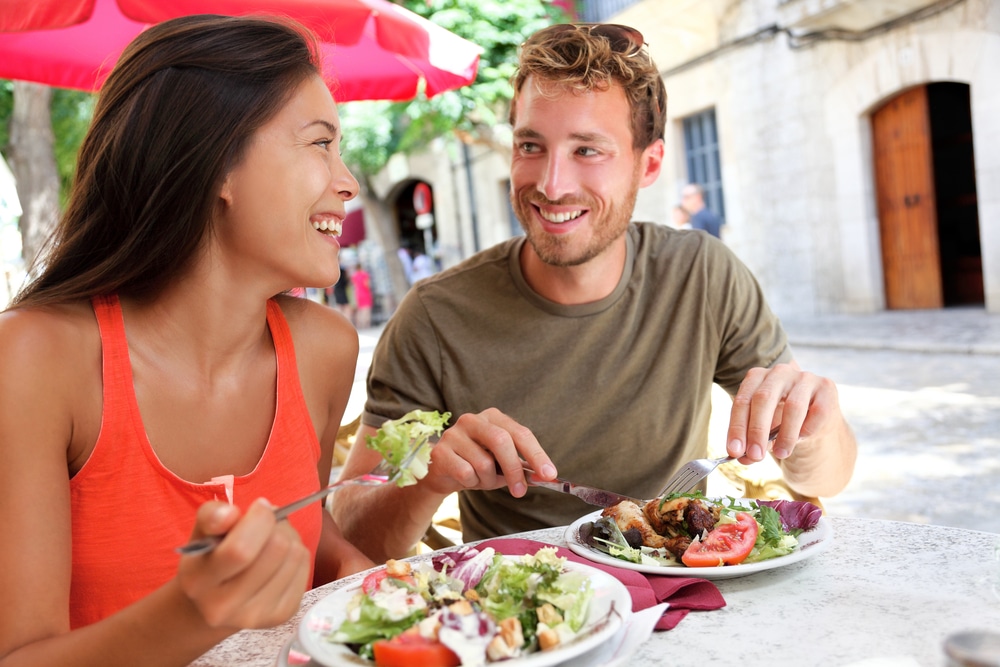
Food. Many love to eat it, some love to cook it, and others simply love to talk about it. It is no secret that food plays a significant role in our lives. And while we all have our own unique relationship with food, there is one thing that we can all agree on – food is an experience .
Food tourism is the act of traveling for the purpose of experiencing food. This can be anything from going on a wine tour to visiting a local farmer’s market. Food tourism has become a popular way to travel in recent years as it provides people with an opportunity to connect with the local culture through food.
Would you be interested in learning more about food tourism? Keep reading to find out what it is, why it matters, and some tips on how to get the most out of your food tourism experience.
What Is The Meaning Of Food Tourism?
Travelers often seek out destinations that offer them a chance to sample the local cuisine. This type of tourism is known as food tourism. It’s also called culinary tourism or gastronomy tourism.
Food tourism can take many different forms. It can be as simple as trying a new dish while on vacation, or it can involve planning an entire trip around visiting different restaurants and food festivals ( 8 ).
Some people even choose to study culinary tourism, which is a field that combines the elements of anthropology, sociology, and economics to understand how food can be used as a tool for cultural exchange ( 2 ).
No matter how you define it, food tourism is a growing trend all over the world. And it’s not just about trying new foods – it’s about understanding the culture and history behind them.

What Are The Characteristics Of Food Tourism?
Food tourism includes any type of travel that revolves around experiencing food ( 6 ) ( 7 ). This can range from eating street food in Thailand to taking a cooking class in Italy.
Some of the most common activities associated with food tourism are:
Visiting Local Markets
Local markets are a great way to get a feel for the local cuisine. They also offer an opportunity to buy fresh, locally-sourced ingredients.
Trying Street Food
Street food is a staple in many cultures and a great way to sample the local cuisine. It is often less expensive than sit-down restaurants and offers a more authentic experience.
Attending Food Festivals
Food festivals are a great way to try a variety of local dishes in one place. They also offer the opportunity to learn about the culture and history behind the food ( 10 ).
Taking Cooking Classes
Cooking classes are a great way to learn about the local cuisine and how to cook traditional dishes. One may learn new cooking techniques, as well as about the culture and history behind the food.
Touring Wineries And Breweries
A common misconception is that food tourism only includes food and not beverages. However, touring wineries and breweries is a great way to learn about the local culture and taste the local products.
At a winery, one can learn about the wine-making process and taste the different types of wine produced in the region.
At a brewery, one can learn about the brewing process and taste the different types of beer produced in the region.
Some regions may be known for a certain type of spirit, and you can visit distilleries for those as well.
Read More: No Carb No Sugar Diet Meal Plan: Is It Healthy For Weight Loss?

Eating At Michelin-Starred Restaurants
Fine dining is another aspect of food tourism. Michelin-starred restaurants are known for their excellent food and service.
While at it, one can also learn about the chef, the history of the restaurant, and the thought that goes into each dish.
Touring Food Factories
Food factories offer a behind-the-scenes look at how food is produced. This can be anything from a chocolate factory to a pasta factory.
Touring food factories is a great way to learn about the production process and see how the food is made.

What Are The Benefits Of Food Tourism?
Food tourism can have a positive impact on both the traveler and the destination.
Benefits For The Traveler
Food tourism is becoming increasingly popular, and with good reason.
For travelers, it ( 5 ):
- Offers the opportunity to try new foods and experience new cultures.
- Is a great way to learn about the history and culture behind the food.
- Can be a more authentic and immersive experience than other types of tourism.
- Is a great way to support local businesses and the local economy.
- Can be a great way to meet new people and make new friends.
Benefits For The Destination
Food tourism can also have a positive impact on the destination.
For destinations, food tourism:
- Can help to promote the local cuisine and culture.
- Is a great way to attract visitors and boost the local economy.
- Can help to create jobs and support local businesses ( 1 ).
- Can help to improve the image of the destination.
- Can help to preserve traditional foods and recipes.
BetterMe app is a foolproof way to go from zero to a weight loss hero in a safe and sustainable way! What are you waiting for? Start transforming your body now !
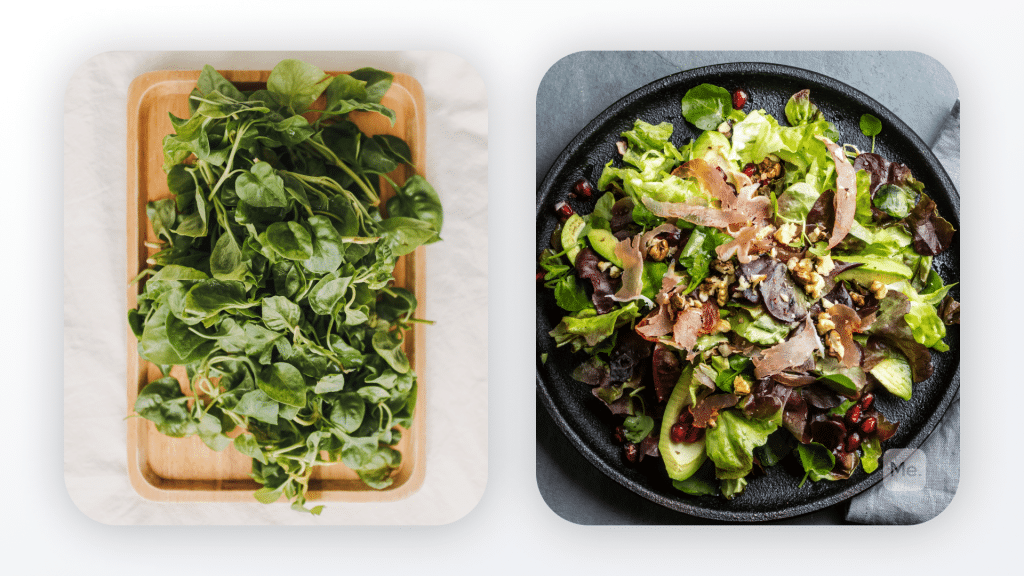
What Are The Challenges Of Food Tourism?
While food tourism can have many positive benefits, there are also some challenges that need to be considered. These include:
1. Ensuring Food Safety And Hygiene Standards Are Met
Food safety is a major concern when traveling, and food-borne illnesses can ruin a trip ( 11 ). It is important to research the restaurants and markets before eating anything .
Using your common sense and following basic hygiene rules (such as washing your hands) can also help to reduce the risk of getting sick.
2. Ensuring Food Is Ethically And Sustainably Sourced
With the rise of food tourism, there is a danger that destinations will start to mass-produce food for tourists, rather than focus on quality. This can lead to unethical and unsustainable practices , such as using forced labor or over-fishing ( 3 ) ( 4 ).
3. Managing The Impact On The Environment
Food tourism can have a negative impact on the environment if it is not managed properly. For example, if too many people visit a destination, it can lead to pollution and damage to the local ecosystem ( 9 ).
4. Ensuring Fair Working Conditions For Those Involved In The Food Industry
The food industry is often characterized by low pay and long hours. This can be a problem for those working in the industry, as they may not be able to earn a decent wage or have enough time to rest.
5. Addressing The Issues Of Food Waste And Overconsumption
Food tourism often involves trying new and different foods . However, this can lead to food waste if people do not finish their meals or if they order more than they can eat.
It is important to be aware of the issue of food waste and to try to minimize it where possible.

Where Is Food Tourism Most Popular?
Food tourism is particularly popular in countries with strong culinary traditions. Below are several examples of such destinations, along with a description of what they offer food tourists .
Porto (Portugal)
Porto is known for its port wine, which is produced in the surrounding Douro Valley. The city also has a number of traditional restaurants serving Portuguese cuisines such as bacalhau (codfish) dishes and francesinha (a sandwich with meat, cheese, and ham).
Lisbon (Portugal)
Lisbon is another Portuguese city with a strong culinary tradition . The city is known for its seafood, as well as for pastries such as the Pasteis de Belem (a type of custard tart).
Palermo (Italy)
Palermo is the capital of Sicily, an island with a rich culinary tradition. The city is known for its street food, which includes dishes such as arancini (fried rice balls) and panelle (fried chickpea fritters).
Vientiane (Laos)
Vientiane is the capital of Laos, and its cuisine reflects the influence of both Thai and Vietnamese cuisine. The city is known for dishes such as laab (a type of meat salad) and khao soi (a noodle soup).
San Sebastian (Spain)
San Sebastian is a Basque city located in northern Spain. The city is known for its pintxos (small plates) and for Basque dishes such as txakoli (a type of white wine) and cod with pil-pil sauce.
Paris (France)
Paris is one of the most popular food tourism destinations in the world. The city is known for its fine dining, as well as for its more casual bistros and cafes.
Paris is also home to a number of markets, such as the famous Les Halles market, where food tourists can sample a variety of French specialties.
Read More: What Is The Ideal Ketosis Level For Weight Loss? How To Monitor Ketones

New York City (USA)
New York City is another popular food tourism destination. The city offers a wide range of cuisines, from traditional American dishes to the cuisine of its many immigrant communities.
New York is also home to a number of famous restaurants, such as the Russian Tea Room and the Rainbow Room.
Tokyo (Japan)
Tokyo is a city with a rich culinary tradition. The city is known for its sushi and ramen, as well as for its more traditional dishes such as tempura and yakitori. Tokyo is also home to a number of Michelin-starred restaurants, making it a popular destination for food tourists.
Tips For Food Tourism
If you’re interested in trying out different cuisines while traveling, there are a few things you can do to make the most of your food tourism experience.
Do Some Research Before You Go
Read up on the cuisine of the place you’re visiting, and try to find out what dishes are particularly popular. This will help you narrow down your options and make sure you don’t miss out on any must-try dishes.
Don’t Be Afraid To Ask For Recommendations
When you’re in a new city, ask the locals where they like to eat. They’ll be able to point you in the direction of some great places to try.

Be Open To New Experiences
When you’re trying out new cuisine, don’t be afraid to experiment. You might find that you like something that you never would have thought to try before.
Respect Local Customs And Traditions
When you’re traveling, it’s important to remember that not everyone does things the same way as you do. Be respectful of local customs and traditions, and try not to offend anyone.
Enjoy Yourself!
Food tourism should be about enjoying new experiences and trying new things. So relax, and enjoy the ride.
The Bottom Line
Food tourism is a growing trend, and there are many destinations around the world that offer something for everyone. Whether you’re looking for fine dining or street food, it’s sure there’s a place that will suit your taste.
DISCLAIMER:
This article is intended for general informational purposes only and does not address individual circumstances. It is not a substitute for professional advice or help and should not be relied on to make decisions of any kind. Any action you take upon the information presented in this article is strictly at your own risk and responsibility!
- A study on the importance of Food Tourism and its impact on Creating Career 2017 (2017, researchgate.net)
- Culinary Tourism (2014, link.springer.com)
- Darker still: Present-day slavery in hospitality and tourism services (2013, researchgate.net)
- Disentangling tourism impacts on small-scale fishing pressure (2022, sciencedirect.com)
- Food and tourism synergies: perspectives on consumption, production, and destination development (2017, tandfonline.com)
- Foodies and Food Events (2014, tandfonline.com)
- Food tourism value: Investigating the factors that influence tourists to revisit (2019, sagepub.com)
- Global report on food tourism (2012, amazonaws.com)
- Re-evaluating the environmental impacts of tourism: does EKC exist? (2019, link.springer.com)
- Reviving Traditional Food Knowledge Through Food Festivals. The Case of the Pink Asparagus Festival in Mezzago, Italy (2020, frontiersin.org)
- The Importance of Food Safety in Travel Planning and Destination Selection (2008, tandfonline.com)
I've struggled to maintain programs…
Our Journey
It Works! This program is working for me!

Are Overnight Oats Healthy? Unlocking the Truth

7 Immunity-Boosting Soup Ideas to Ramp Up Your Health

3,100-Calorie Meal Plan: What to Eat for a Lean Bulk

Golden Milk Latte Recipe: A Natural Approach To Improve Sleep

Power Your Morning with These Delicious Protein Waffles Recipes
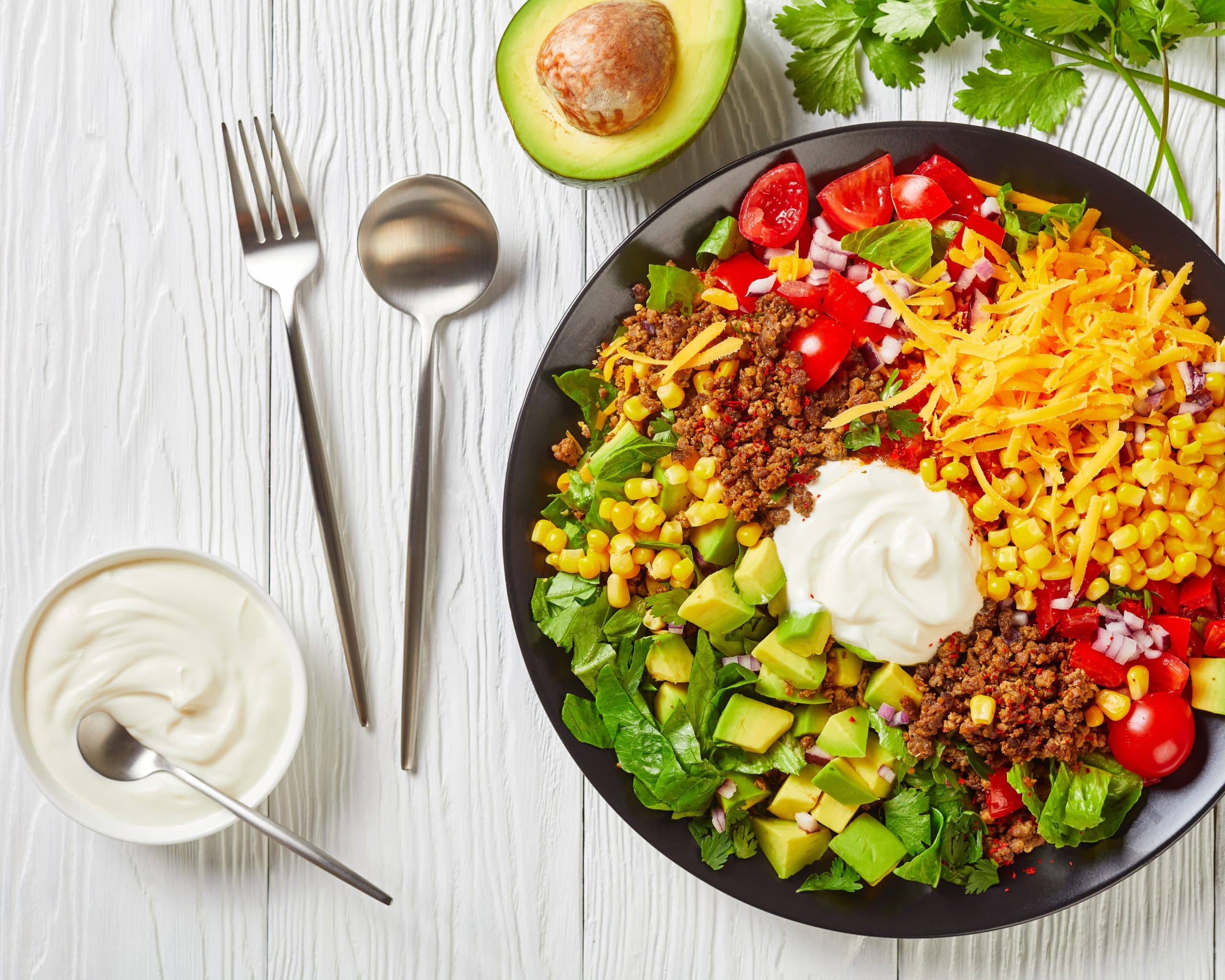
6 Low-Carb Ground Beef Recipes That Are Easy To Make

- For Business
- Terms of Service
- Subscription terms
- Privacy Policy
- Money-back Policy
- e-Privacy Settings
- Your Privacy Choices
Travel With - The Holiday Story
18 Different Types of Tourism | Globally Accepted
Last few years, tourists and their demands have frequently been changing. Also, the tourism industry is changing based on needs. This article elaborates on different types of tourism, tourists, planning, activities, products, travel , etc. It helps your travel planning as well.
Along with recreation, tourism has become one of the growing industries, and it’s the source of income for many people.
“Life is all about adventure, so pack your bags and start the tour.”

Different Types of Tourism
What is tourism.

Tourism is a process of spending time away from daily routine or home to pursue recreation, relaxation, and pleasure while using the commercial provision of services.
Tourism in a country has many benefits: it creates employment, boosts revenue, develops infrastructure, helps in cultural exchange, etc. Travel duration under tourism must be less than 12 months (a consecutive year).
So, What comes first to mind when we hear the word Tourism?
The most common thought is to pack the rucksack and travel away from day-to-day life. That means the movement of people from their usual residence to another place.
Suppose your friend’s aim for the tour might differ from yours. For example, you may travel for recreation, but he may go for business.
Classification of Tourism
According to the United Nations World Tourism Organization (UNWTO), tourism involves the movement of people in the country’s natural environment or outside the country for personal or other purposes. These different purposes classified the tourism industry in many ways.
This article lists the main tourism classifications: Domestic tourism, International tourism, Business tourism, Adventure tourism, Medical tourism, Educational tourism, etc.
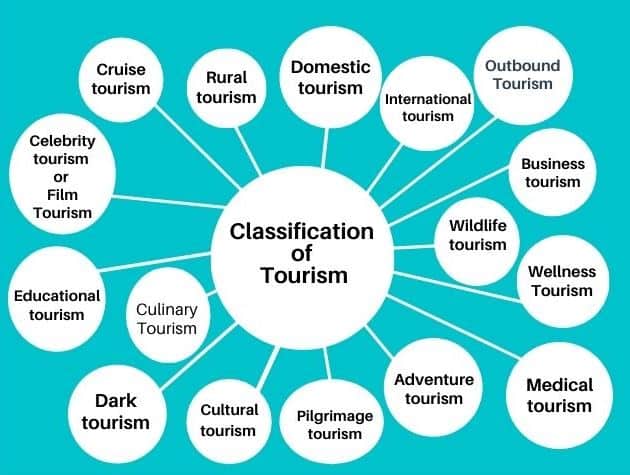
Importance of Tourism – Why is tourism important?
Tourism has a direct impact on any country’s economy. The role of tourism in economic development is important. A vast amount of job possibilities can develop through public relations in tourism. Knowing another state/country’s taste culture is a great filling from a traveler’s perspective.
Mainly how many types of tourism are there
Mainly three types of tourism are found in any country. The classes are domestic tourism, International tourism, and outbound tourism. But nowadays, many types of tourism newly evolved.
18 Different Types of Tourism
The various types of tourism are developed nowadays and become popular; they are:-
- Domestic tourism
- International tourism
- Outbound tourism
- Business tourism
- Adventure tourism
- Wildlife tourism
- Medical tourism
- Wellness tourism
- Pilgrimage and spiritual tourism
- Cultural tourism
- Dark tourism
- Culinary tourism
- Celebrity tourism or Film tourism
- Educational tourism
- Cruise tourism
- Rural tourism
- Beach tourism
- Space tourism
Let’s discuss how many flavors and categories of tourism can be found in any country and accepted globally.
1. Domestic Tourism
Domestic tourism involves traveling in one’s own country, and tourists don’t cross international borders or entry points. Domestic tourism is used to minimize poverty, enhance infrastructure, and boost the economy’s growth and generation of employment.
2. International Tourism
Travel outside your country needs a visa and passport; called International tourism. For example, if you want to explore The UK from Sri Lanka, you need documents to enter another country.
Read How to Listen to Music on a Plane
3. Outbound Tourism
This tourism defines a tourist traveling for a holiday to a different country, like your residents in Bali and traveling to Barcelona . It is an example of outbound Tourism.
4. Business Tourism
This tourist travels to meetings, officially gets together for conferences, etc.
Business tourism plays a vital role in the tourism sector. Sometimes, people stay out of their typical environment for more than a year for business purposes and spend their vacations there.
General activities related to business tourism include attending meetings, officially getting together, conferences, seminars, visiting exhibitions and trade fairs, etc. This tourism levels up the purchasing power.

5. Adventure Tourism
Adventure tourism is a person’s travel from one place to another to seek fresh adventures and activities. This form of tourism is most famous among young tourists and people who like to explore remote areas. It encourages us to leave our comfort zone by undertaking activities like hiking , rafting, climbing, diving, etc.
Adventure tourism is increasing day by day. You could also try whitewater rafting, the Ladakh tour, the Kedarnath tour, Port Blair, and Andaman and Nicobar tour for the adventure.

6. Wildlife Tourism
Wildlife tourism is people’s travel to different places to observe and interact with wildlife, flora, and fauna in their natural habitat. Safaris, visiting the animal rescue center, swimming with dolphins, etc., are examples of wildlife tourism.
Because of exotic species of wildlife, this tourism became recognized. The Sariska Wildlife or Hyde Park Sanctuary , Keoladeo Gana National Park, and Corbett National Park are renowned for wildlife tourism. The Great Barrier Reef is also famous in Australia.

7. Medical Tourism
Many people travel for treatment, and several medical institutes cure foreign patients. Thailand has recorded 6000,000 new patients every year. Malaysia also treated over 100,00 tourists in 2005. 45% of foreign tourists come to Chennai for medical treatment.

8. Wellness Tourism
Wellness tourism has been a significant part of tourism since ancient times. This tourism mainly attracts those tourists who want to regain their health. Wellness tourism will help you to get rid of mental and health stress.
Tourists recover their health issues through physical, spiritual, or psychological activities. All around the world, plenty of destinations are popular for improving health.
Examples include Mexico Temazcal Beach Resort Spa, Caribbean wellness cruise, California weight loss and detox retreats, Colorado Hiking and Mountain Yoga retreat, and China Hot Spring Resorts TCM.
Ayurveda, Yoga , Meditation, Panchakarma, and Rejuvenation Therapy are the oldest Therapy of treatments to improve health and the best way to develop wellness tourism.

9. Pilgrimage and Spiritual Tourism
Pilgrimage or spiritual tourism is when a person journeys to other places for spiritual or religious reasons.
Spiritual tourism helps support local cultural activities and handicrafts, generating employment and revenue. Trips to Jerusalem, Bodh Gaya , Hajj, etc., are pilgrimage or spiritual tourism.
This tour has been famous for ages, but It’s popular among older people mainly. Vaishno Devi, Golden Temple, Char Dham, and Mathura Vrindavan are some places famous for Pilgrimage tours.
10. Cultural Tourism
Cultural tourism is a person’s journey to learn and participate in local festivals, rituals, and cultural activities of other places. It’s more than a commercial activity.
This form of tourism helps spread aboriginal communities’ culture, traditions, diversity, and richness to the rest of the world.
Visit the historical sites and the artistic features of that country too. Famous cultural tourism places are:-
- India – Durga puja in Kolkata , Temples at Banaras, Jaipur, known as the pink city Palace in Rajasthan. Forts and monuments in Delhi, Agra, UP.
- UK – Tower of London, The British Museum, Big Ben, London Durga puja , etc.
- Kenya – The main attraction is the dance of the Maasai tribe.
- Morocco – The main attractions are the Olive Festival and Honey Festival.
- Jordan – The main attraction- is Jerash, famous for Roman architecture Petra, the red-rose curved rock city and one of the seven world wonders, and Shoubak with its Montreal Crusader Castle.
- Greece – The main attraction- is the Lion Gate of Mycenae.
- Turkey – the main attraction- Sultan Ahmed. Mosque, House of the Virgin Mary.
- Vietnam – The main attraction- is Sapa Market.
- Ireland tour – Cliffs of Moher, Dublin, Killarney National Park, etc.

11. Dark Tourism
Dark tourism, Black tourism, or grief tourism are related to people’s travel to historical places involved with tragedy and death. Since 2016, dark tourism has significantly increased (over 1200%). Chornobyl, cemeteries, Ground Zero, historical museums, and Auschwitz are popular dark tourism destinations.
It is referred to as mourning tourism. Dark tourism involves visiting those places and sites that have witnessed the greatest tragedies in history. Besides this history of human suffering and bloodshed, these locations are famous for their historical value.
So, those sites that carry potent pesticides have become popular tourist destinations and attract many tourists yearly.
Like Famous sites In Japan, Hiroshima & Nagasaki bombing locations, Ground Zero, New York, USA . The War Remnants Museum, Ho Chi Minh City, Vietnam; Auschwitz concentration camp, Auschwitz, Germany; Tuol Sleng Genocide Museum, Phnom Penh, Cambodia, etc.

12. Culinary Tourism
Culinary or food tourism involves tasting and experiencing local and traditional food in a specific country, region, city/town/village.
It is significant that besides accommodation and infrastructure. Here, food is one of the prime components. Therefore, lots of tours are organized here to experience the culinary culture.
Today, with the overall growth of this sector, tourism has expanded and developed to the next level.
Every year, Different states of India organize food festivals at different times in different states. Thousands of people from abroad join this festival to enjoy traditional food.
Everyone knows India is called “The land of spices.” And every state has unique kinds of food culture. Today, it is a significant part of tourism.
Culinary Tourism includes where people visit certain regions like California, Napa Valley, Catalonia, USA, and Spain) to enjoy foreign wines.
Famous Destinations : London, France, Beijing, Mexico, Italy, etc.

13. Celebrity Tourism or Film Tourism
Celebrities are the primary source of attraction for celebrity or film tourism. In this form of tourism, tourists visit places where a celebrity currently lives or has lived. Management organizations use celebrity tourism to promote a place or attraction.
Although no celebrities are present, only you can see the entire studio. Many Destination Management organizations (DMOs) use celebrity tourism to promote destinations as an attraction.
Popular celebrity tourism destinations are – Hollywood, Harry Potter Studios, Ramoji Film City India, Cannes Film Festival, Hong Kong, and Madame Tussauds.

14. Educational Tourism
Educational tourism is a new pattern of tourism that comprises learning new things. It’s the journey a person takes to leave his hometown or country for educational or learning purposes. Educational tourism is famous in Japan, Australia, the UK, etc.
An educational tourist can be away from his hometown for many days. Education and learning are the key reasons for their travels, and it is learning knowledge from historical places, cultural and social events, and understanding a language.
It’s used as a tool to complement education by gathering travel experience. Many educational institutes combine these trends in primary schools and are compulsory in higher education.
15. Cruise Tourism
Holidays based partially or wholly on a cruise ship are considered cruise tourism. It provides tourists with a multi-centered holiday experience. Cruise ships (like small yachts, big ships, etc.) take people on a tour of oceans, fjords, or rivers.
Throughout their trip, tourists can enjoy time at various destinations. The Mediterranean, Caribbean, Arctic, Antarctica, etc., are famous destinations. It’s the newest and fastest-growing part of the world’s tourism industry.
The world’s famous coastline and inland waterways have the potential to develop cruise and houseboat tourism like Quark Expeditions, OZ Cruising, and A-ROSA River Cruises.
India has many types of tourist cruises. Soon, India will be including Ocean Cruise, River Cruises, and Lake Cruises.
View this post on Instagram A post shared by ⚓️ Iglu Cruise (@iglucruise)
16. Rural Tourism
There are many forms of tourism, and It’s divided into many parts. In this category, a tourist spends leisure time in rural areas or villages. Visitors can make a plan to visit the rural area for some days or a couple of months.
Especially Solo travelers can visit those places to enjoy their lonely time. They join all the local activities that happen in this village.
Rural tourism is included in a ‘country holiday’ where tourists spend much of their leisure time. Thus, they taste the recreational activities in the rural environment.
Like Farming in Rural Punjab, The Spiti Valley Rural Tourism, Sundarban and Jodhpur Village Life, Bhubandanga West Bengal, and Community Tourism in Kutch.
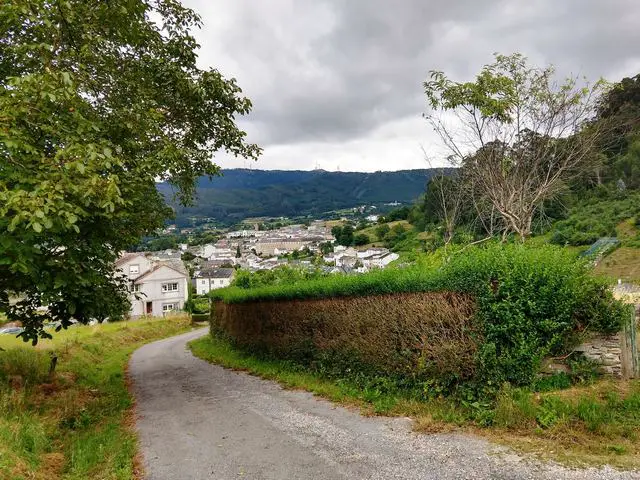
17. Beach Tourism
Beach tourism is how a beach plays a major element in the holiday, and it’s the most modern form and the staple of tourism.
In beach tourism, tourists travel to a beach for leisure, recreation, or business purposes. People who like the clear blue sight of a beach undertake this journey.
Popular Beach Destinations: The Maldives, Seychelles, Turks And Caicos, French Polynesia, Africa , Queensland, Australia, Philippines, Thailand, Bali In Indonesia, Lakshadweep, Goa, Puri, etc.
Why is Beach Tourism important?
- Beach tourism has brought about many economic benefits.
- It has led to the building of many attractions, resorts, etc.
- Beach resorts help in meeting the increase in intra-regional demand and domestic demand.
- This type of tourism creates numerous employment opportunities.

Negative Impacts of Beach Tourism
- It leads to the wastage of a lot of resources and space.
- Beach tourism pollutes water and environmental resources.
- Building new berths, marinas, etc., hurts coastal and marine life.
18. Space Tourism
We have seen significant changes in the aviation industry in the last 100 years. What was once used for warfare and cargo transport is now used for traveling.
Human development has now broken all bounds to take this journey to the vast emptiness of space.
Russia has been the pioneer in this field. Soyuz spacecraft conducted its first space trip with American businessman Dennis Tito in April 2001.
It was a government spacecraft that conducted seven space expeditions within the next six years. This surge in public interest led other organizations worldwide to dive into this area.

There are different types of space tourism
Orbital Space Tourism: These flights remain within an orbit around the Earth at a speed higher than suborbital space flights. These flights orbit the world constantly for their entire stay in outer space.
Sub-orbital Space Tourism : This was the beginning of space tourism. The spacecraft launches with a substantial initial velocity that pushes it out of the Earth’s atmosphere. But this doesn’t throw it entirely out of the gravitational sphere. The power is insufficient for orbiting, so it freezes once the engines are shut off.
SpaceX C.E.O. Elon Musk proposed the prospect of lunar tourism. In 2018, he announced the ‘Dear Moon Project,’ the highly anticipated first lunar space tourism mission. They will carry out this project in 2022 with Japanese billionaire Yusaku Maezawa.
Space Tourism cost
The cost of each sub-orbital trip on the Soyuz spacecraft is reported to be 200,000-250,000 million U.S. dollars. Other trips carried out by different organizations were priced around the same margin.
Virgin Galactic recently announced that each ticket would cost 450,000 USD for the upcoming missions.
Space Tourism companies
Even though the industry is still up and coming, massive companies dominate the market. Space Adventures of Virginia, U.S.A, was the first successful space tourism company.
Elon Musk’s SpaceX, Richard Branson’s Virgin Galactic, and Amazon C.E.O. Jeff Bezos’s Blue Origin are all set to launch their space tourism business by 2022. Blue Origin recently conducted its debut flight with Jeff Bezos.
Oliver Daemen and Wally Funk were the world’s youngest and oldest men in space, respectively.
Space Tourism advantages
The universe and outer space have always been intriguing subjects for people on Earth. Yet, there were limited resources to satisfy their curiosity. The option of space tourism thus connects people with space in a unique way and solves its mystery. A more ecological advantage is the waste policy.
There is minimum pollution associated with these travels. Also, this allows a whole new sector of job opportunities for highly educated professionals and ambitious youth.
Top 13 list of space tourists
- Dennis Tito (American): April 28 – May 6, 2001
- Richard Branson
- Gennady Padalka
- Guy Laliberté
- Eytan Stibbe
- Sian Proctor
- Mark Shuttleworth (South African / British): April 25 – May 5, 2002
- Gregory Olsen (American): October 1 – October 11, 2005
- Anousheh Ansari (Iranian / American): September 18 – September 29, 2006
- Charles Simonyi (Hungarian): April 7 – April 21, 2007[8]
- Richard Garriott (American): October 12 – October 23, 2008[9]
- Sheikh Muszaphar Shukor (Malaysian): October 10 – October 23, 2007
Space Tourism in India
Space activities, in general, have been quite a staggering section in India. Last year, the government announced a policy that opens space exploration to private sectors, but hardly any company has taken action on it.
Entrepreneur Santhosh George Kulangara will be the first Indian space tourist as he booked his spot on a Virgin Galactic space flight in 2007. Hopefully, he will join Dennis Tito, Mark Shuttleworth, Gregory Olsen, and many more this year.
Forms of Tourism
- Atomic Tourism
- Beach Tourism
- Bicycle Tours
- Eco-Tourism
- Geo-Tourism
- Industrial Tourism
- Rural Tourism
- Space Tourism
- Sports Tourism
- Sustainable Tourism
- Virtual Tourism
- War Tourism
What is the main purpose of tourism?
- Economic Sustainability: It ensures the effectiveness and competitiveness of tourism destinations and enterprises. It helps continue improvement, which is beneficial in the long run.
- Local enrichment: Tourist destination prosperity is an enormous part of tourism. The tourism business continuously maximizes the economic growth of the host destination.
- Employment Standards: Tourism supported the level of wages, terms of service, and availability for all. It creates local jobs without discrimination based on gender, race, disability, or other means.
- Local management: Involve local communities and empower local people for planning and decision-making. The community and tourism management team helped to develop this.
- Community Welfare: Maintain and boost the local community’s lifestyle. They are part of social structures. But surely, this process should take place with no social humiliation or exploitation.
- Natural Integration : Maintain and improve the quality of both urban and rural landscapes. It avoids natural and visual degradation of the environment.
- Natural Integration: Maintain and improve the quality of both urban and rural landscapes. It avoids natural and visual degradation of the environment.
- Biodiversity: Another purpose of tourism is to assist in conserving wildlife and natural wildlife areas and reducing losses.
- Environmental cleanness: Besides the purpose of tourism, all tourists must reduce air, water, and land pollution and waste generation.
- Tourism is a significant part of national integration .
- Tourism always motivates tourists to understand their traditions, heritage, culture, and religion.
- Tourism’s most significant part is economic growth or the business part of the destination. It encourages local people to create handicraft items and prepares local food items, souvenirs, dresses, etc., for sale.
- Tourism is one such thing that constantly boosts the country economically.
Niche Tourism
This tourism focuses on a specific aspect of traveling. It also focuses on the consumer market segment’s interest. It makes the destination more exciting and marketable. Niche Tourism is one of the fastest-growing sectors. Niche tourism indicates a specific feature of travel.
For example, some tourists want a museum, some wish to visit old architectural monuments, buildings, palaces, etc., and some want to eat in a famous restaurant. Thus, niche Tourism shows a particular activity that is not the only focus of travel.

Types of Niche Tourism
- Macro-Niche
- Micro-Niche
What is Macro-Niche?
Macro-niche tourism can be explained as a niche with broad customer interest categories such as rural tourism, Business tourism, sports tourism, medical tourism, environmental travel, etc.
What is Micro-Niche?
It is a small group trip, such as gastronomy tourism, cycling tourism, and geo-tourism.
Niche tourism in South Africa
South Africa is an attractive destination because of the wide diversity of animal and bird species. As a result, tourism professionals found this country has considerable potential.
Advantages of Niche Tourism
- Even if niche tourism is smaller than mainstream markets, it spreads more.
- It has more potential to grow.
- It creates quality jobs that require specialized skills.
What are the different types of tourists?
When we visit a place, we find different kinds of travelers. The aim of each traveler is different. Let us discuss the types of visitors. Five types of tourists are found mostly :-
- Incentive tourists – These tourists did not plan for the tour earlier. Suppose you have been rewarded with two tickets from the office because of your performance. You and your colleagues came for the trip.
- Business tourist – This type of tourist travels for business. They will always prefer a hotel with a conference room. They don’t come to enjoy luxury, but they want the hotel to serve everything on time.
- Leisure tourist – This type of tourist comes to enjoy the vacation. They love those hotels that serve them something extra, like drinks. They choose hotels that give them comfort and luxury at their best.
- Special interest tourists – They often plan their tours very well. This tourist doesn’t need comfort but loves to do adventure.
- The Foodie tourist – This type is quite common. They wish to taste various foods in various places. The signature dishes of those areas and various kinds of foods.
Types of a Tourist Attraction
We have to keep in mind that attraction varies from person to person. For example, suppose Rahul and Sheela are traveling to Kashmir. Rahul is interested in climbing the mountains to see snowfall, whereas Sheela is excited to visit the temples in Kashmir.
Tourist attractions could be classified into the following two categories:-
- Natural attraction – If you are a nature lover, don’t miss The Valley of Flowers in Uttarakhand, Coorg, known as the ‘Scotland of India.’
- Events and heritage attractions – Goa is a place for heritage lovers. So pack your bag, take the camera, and start your journey towards Goa. I am sure you will have an unforgettable lesson in Goa’s history. Fort Aguada, Chandor, and some famous museums are places to visit.
What is Tourism Planning?
Perfect planning is always a matter of the success of any activity. Whenever we plan something and implement it, we get a better result. It’s the same with tourism. But it is neither guaranteed nor forever. It’s a process where the people’s needs are determined using the best resources, programs, and activities.
How do these tourism plans help us?
A tourism plan makes guidelines for the areas. Then, it helps the government and private sectors to develop those areas. Most importantly, we must remember a few steps involved in tourism planning.
Main types of tourism planning
- Financial planning
- To establish the objective
- Human resource planning
- Monitoring progress
- Human resource planning.
Types of Tourism Activities
There are various kinds of tourism activities. Like-
- Heritage trails
- Swimming with dolphins

Name of some international tourist organization-
- American Society of Travel Agents : Founded 1931, Headquarter- New York
- International Academy of Tourism : Founded-1951, Headquarter- Monge Carlo
- International Bureau of Social Tourism : Founded 1963, Headquarters- Brussels
- International Touring Alliance: Founded-1919, Headquarters- Europe
- World Tourism Organization : Founded 1975, Headquarter- Madrid.
Types of Tourism packages
For different categories of tourists, everybody needs a separate package. Let’s discuss the various types of Packages that are available.
1. Adventure Tourism Package
This tourism encourages people to come out of their comfort zone to feel the thrill of nature closely in life. It is found that people are taking adventure more often. It shows potential growth in recent years.
The most exotic and adventurous destinations are Ladakh, Himachal Pradesh, Kerala, Jammu, and Kashmir.
2. Wildlife Tourism Package
In every country, wildlife tourism is famous. But, if you love wildlife, you must choose the right package. This package is exclusively for wildlife lovers who love taking their snaps.
3. Medical tourism package
It has been observed that medical tourism has grown rapidly in Asia-specific countries.
4. Pilgrimage tourism package
Many foreigners visit various temples in India, Sri Lanka, and Singapur. However, the major attraction is the traditional architecture, art forms, and rituals performed.
Famous pilgrimage areas are the Meenakshi Temple, Golden Temple, Jagannath Temple, Santa Cruz Cathedral Basilica, Atala Mosque, etc. Therefore, this type of package is chosen based on your religious beliefs.

5. Eco-tourism Package
This type of tourism has become one of the fascinating travel forms. Although eco-tourism is more of a travel philosophy, it attracts many tourists. Some eco-tourism destination areas are Kerala, Galgibaga Beach, Goa, and Coorg.
6. Cultural Tourism Package
The social richness of any country draws visitors from every corner of the world to witness sheer celebrations. The cultural tour package offers you a comprehensive exploration of the different shades. Moreover, this package will bring a tourist a closer view of traditions and architecture.
Along with these, we found tourism packages like-
7. Family Tourism Package
A family tour package is designed keeping in mind the family’s needs. It gives assurance of total relaxation and fun pastimes.
The package includes adults, kids, and the elderly. This package includes sightseeing trips, tours of historical places, and adventure trips.
8. Honeymoon Tourism Package
Couples, after their marriages, take a honeymoon tour package, and it provides newlyweds with all the perquisites to make their trip memorable.
The honeymoon tourism package includes lodgings, dining, food & drinks, etc. Famous destinations for a honeymoon tour package are Maldives, Bali, Mauritius, etc.
9. Wellness Tourism Package
Traveling to other places for health and well-being takes a wellness tourism package. Tourists take this package to visit sites that provide recuperation facilities. Wellness tourism has seen a significant boost in the modern years.
Popular destinations for a wellness tourism package are Ayurveda centers, Iceland (for its spas), Bali (for yoga), etc.
10. Cruise Tourism Package
A cruise tourism package provides tourists with a journey filled with fun and recreational activities onboard and excursions onshore.
Tourists get an all-planned ship or boat trip for a specific date to a particular location at a specific price. These packages are curated as per the needs of the tourists.
What are Tourism Products?
According to the market’s needs, the customer supplies anything in the market for use/consumption, called a product.
A product can be offered in the market observation, purchase, use, or any need or demand.
A tourism product is provided to the tourist during their traveling. It mainly focuses on facilities and services designed to meet the needs.
It includes physical objects, services, personalities, places, and ideas. The above components are provided by one company or any group of companies. Tourism products can be given to tourists in a tourist destination.
Products are needed for leisure, pleasure, religious, or business purposes. These products are provided in the market at a cost.
The main reason for choosing a tourist destination is a tourism product. It gives an economic boost to the destination. So it needs to be marketed and stored in a hassle manner.
Services are designed for the visitor to fulfill their needs. Therefore, it is a combination of products. Thus, the country’s total tourism and tourist satisfaction depend on the sum of its attractions, transportation, accommodation, entertainment, etc.
Individual service providers, such as hotels, airlines, travel agencies, etc, provide every element of a tourism product. Therefore, you can analyze these products’ attractiveness, accommodation, and accessibility.
Types of Tourism Products
Attractions: It is one of the main elements. Tourists will not be encouraged to visit certain places without attractions. Attractions are the ingredients. The product determines the choice of a particular tourist to visit a specific destination.
Attractions include archaeological, cultural, and historical buildings, monuments, beach resorts, mountains, flora and fauna, national parks, trade fairs, arts and music festivals, exhibitions, games, etc. Nowadays, tourists are susceptible to changes in fashion.
Accessibility: That means by which a visitor can reach the attraction place. Tourists visit the attraction destination by different transport modes. Visitors visit his predetermined location by car, motorcycle, train , ship or boat, airplane, or cycle.
The place becomes very cheap if any destinations do not have good transport systems. Tourist centers should be located near tourist-producing markets. It is connected to a network of efficient transportation to receive the largest number of tourists.
Accommodation: Another tourism product is accommodation. It is an essential part of tourism—the tourist destination location must-have hotels, guest houses, camping, and homestay. An alternate arrangement should exist if accommodation is not possible at the central location. At least some distance away.
Hospitality: It is a major factor for a tourist destination that will develop in the future. The location’s restaurants, pubs, cafes, foods, and beverage serving style increase location attractiveness.
Natural tourism products: Our nature is beautiful and precious to us. Nature has arranged amazing things in different parts of the world, such as – hills, mountains, caves, glaciers, sea, islands, beaches, waterfalls, rivers, lakes, wildlife, deserts, etc.
The tourism product utilizes those natural gifts as a Natural tourism product, such as snow-capped mountains in Kashmir, Dudhsagar Falls in Goa, palm-fringed beaches of Goa, the wildlife of Kaziranga National Park in Assam, the Thar Desert in Jaisalmer, etc.
Read Things to do in Bainbridge Island, Seattle Washington
Human-created tourism products
Artificial tourism products are those that humans create. Human-made tourism products’ primary purpose is to attract tourists, such as Temples, Forts, palaces, museums, theme parks, etc.
The destination’s tradition and culture play a vital role in tourism. Humans maintain it to attract tourists through- classical dance – music, folk dance, paintings, handicrafts, festivals, fairs, etc.

Examples: Machu Picchu World Heritage Site, Egyptian pyramids , Taj Mahal, Red Fort in Agra, Lothal in Gujarat, Mexican pyramids, or Mesoamerican pyramids are important archaeological sites.
The Bhangra dance form of Punjab, the Kolkata Book Fair, the Durga puja in Kolkata, the Brass work of Muradabad, etc., are also included in human-made tourism products.
Tour guides are another main aspect of traveling. It is also a parameter for tourism. National and international travelers need a travel guide to discover a new place. Sometimes, national travelers may visit any tourist destination on their own.
But an international traveler always wants a good tourist guide. How do you present the location, and how much information do you provide to understand the place? It depends on a guided tour and a travel guide. This parameter upgrades the tourist destination’s level.
What are the different types of tourist destinations?
Types of tourism and types of tourist destinations may sound synonymous. However, the two have slight conceptual differences. Tourism is a broader concept, including the aspects of tourism and hospitality.
At the same time, a tourist destination is a narrower concept applying to places of tourist attraction. Based on the type of place and the causes of interest, the tourist’s destinations are:
- Coastal Destinations – Preferred mostly for the ample sunshine and salty waters lining lands adjoining the sea. Be it domestic or international coastal locations, they are great for fun and relaxation. They are favored mostly by people living in inland areas away from the sea.
- Beaches – The meeting point of land with the ocean offers a great tourist attraction. Waves hitting the shores of sandy beaches are great for tourists. In addition, new beach activities like parasailing, beach biking, etc., also attract tourists immensely.
- Island – A land in the middle of the sea or ocean on all sides is an island. Tourists are taken mainly by boat from the mainland to explore these islands. Islands standing in between a river are called riverine islands.
- Mangroves – It offers a panoramic view amidst the confluence of a river with the sea/ocean. Example: Sundarbans of India.
- Inland Destinations – Travel away from the coast is an inland destination. A variety of sub-classifications can come in under like:
Based on the type of region:
- Hill stations – Offering a surreal view from an altitude, all mountains and hills are great tourist destinations.
- Jungles – Trekking/hiking/driving through the wild greenery are great tourist attractions. Protected areas like Reserve Forests and National Park serve the twin purpose of tourism and conservation.
Based on the population structure
- Rural – For a change, get away from the fast-paced urban life to taste village life. Touring rural locations is gaining popularity because of lower population density, greener areas, and a serene environment.
- Urban – Posh urban destinations offer a pull factor for tourists to experience ultra-modern and urban life. Examples: New York, Shanghai, etc.
- Offbeat – Previously undiscovered newer locations around famous tourist spots are offbeat destinations. With lower tourist popularity, the exclusiveness of these places is retained.
Based on the type of activity
- Hiking and Camping – Places, where tourists come mostly for hiking or camping (day/night), are fast gaining popularity. These places are primarily amidst nature and come under adventure tourism.
- Preserved sites – Sites like UNESCO World Heritage sites have become popular tourist destinations. The rich natural/cultural value owes them their status.
Based on historical/religious importance
- Historical Places & Monuments – Tourists flock to places holding remnants of the past. Areas having historic architecture and events give an insight into the past culture. Examples: Taj Mahal and Jalianwallah Bagh, etc.
- Pilgrimages & Holy Shrines: Religious tourism has flourished here, making it a spiritual destination. Example: Hajj of Mecca, Bethlehem for Christians.
- Museums and buildings: Places where artifacts and remnants of historical culture are well preserved. Famous among tourists of all ages.
Based on entertainment
- Luxury destinations: Locations that only promote high-end tourism are luxury destinations. Example: Bali.
- Carnival: Annually, countries host cultural events to celebrate any occasion for a short period. When tourists travel here to enjoy themselves, it becomes a popular destination. Example: Christmas Carnival in Toronto.
- Amusement Park and Zoo: Famous for the lot is Disney Land, a great tourist destination for children. Singapore Zoo, which ushers in global tourists.
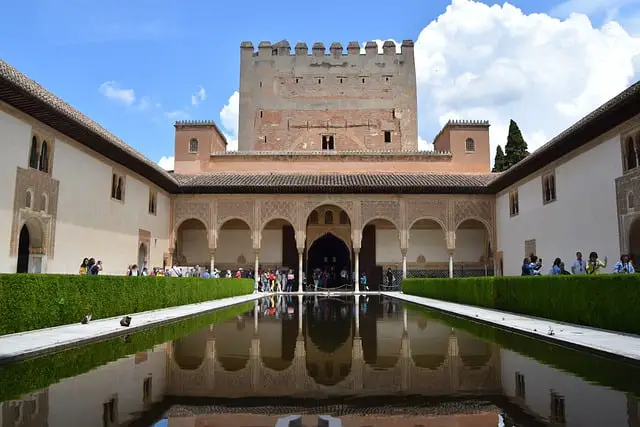
Tourism Destinations
According to UNWTO in the “World’s Top Tourism Destination,” the first four places for International tourism are France, Spain, the USA, and China.
A tourism destination is the endpoint of the journey. But, of course, we all have some goals in every field, so it’s the same with tourism.
There are various types of tourist destinations. They are as follows:-
- Centered Destination
- Based Destination
- Multi-centre Destination
- Touring Destination
- Transit Destination
Types of Tourist Attractions
- Historial attractions
- Cultural attractions
- Political significance
- The natural or scenic beauty
- Leisure travel
- Fun and Amusement
How many Types of Tourism are there in India?
There are 16 Different kinds of tourism in India , but the list may increase.
Is there anything about tourism that I’ve missed?
Over the past 75 years, the travel industry has made great strides in harmoniously uniting strangers, travelers, and locals. As a result, visits and travel are more than adventure, learning new skills, rejuvenating, and achieving perfection.
Tourism has changed from providing services like rooms, flights, and meals that people were satisfied with ten years ago. Now, people want to experience whale watching or mountain biking.
In the luxury sector, wealthy people spend more money on an experience than objects. It is called experience economics, and there is an idea that the memories of tourist values are compared to some physical resources. The rate of global tourists is increasing daily, and every country is trying to make its tourism more developed and successful.
As you can see, the tourism industry is vast and diverse. There are different kinds of tourism here; some have been around for decades, and others are just emerging.
A tour to the Grand Canyon would fall under which type of tourism?
Grand Canyon tour would fall into natural adventure tourism. Here, you can enjoy – The floor Landing Helicopter Tour, ATV, Gold Mine Tour, White Water Adventure Tour, and Rim Airplane Tour.
Kindly Stay 5 Seconds More and Share this Article.
HI TRAVELLER …Myself Ruma Dey Baidya. I’ve been backpacking for the last 20+ years. Photography and travelling have been my passion since my childhood. Whenever I got an opportunity, I never missed it. I am not a solo backpacker, so I always try group travel. I prefer budget travel, and it also helps me to save expenses. We know that memories are not constant, so I decided to document them and created this travel diary. This website [ TheHolidayStory ] is dedicated to those who passionate about travel like me. Please feel free for any information related to my blog. I am always happy to reply. Mail id – ruma[@]theholidaystory.com
Food Tourism: The Impact of Food TV Shows on Local Industries
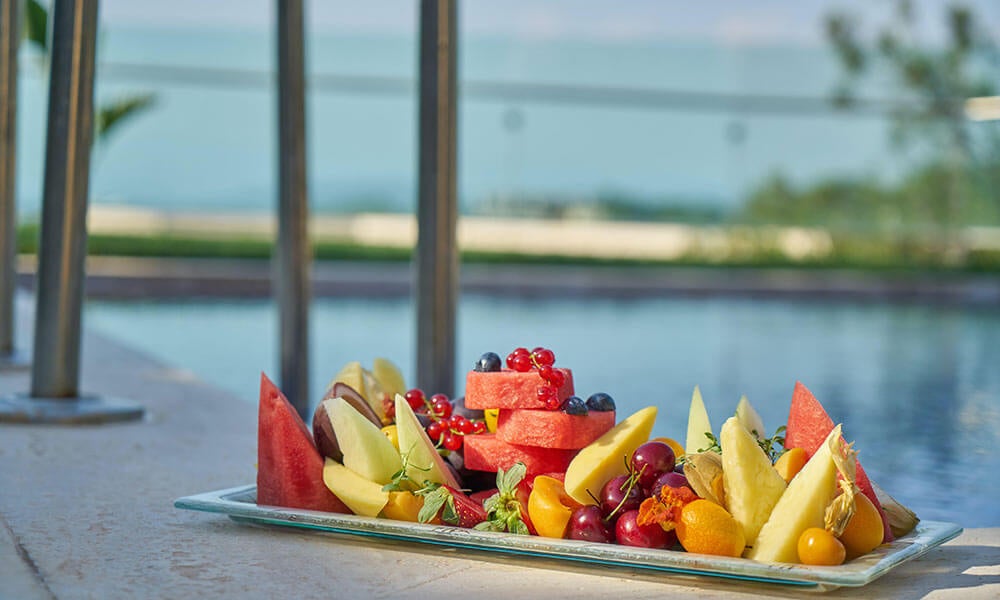
Fill out the form below and we’ll email you more information about UCF’s online hospitality programs.
- Name * First Last
- Degree * Destination Marketing and Management Event Leadership, MS Event Management Event Management, BS Financial Management for the Hospitality and Tourism Industry Hospitality and Tourism Management, MS Hospitality and Tourism Technologies Hospitality Management, BS Leadership and Strategy in Hospitality and Tourism Lifestyle Community Management, BS Lodging and Restaurant Management, BS Travel Technology and Analytics, MS
- Email This field is for validation purposes and should be left unchanged.
Privacy Notice
The widespread popularity of food television programs and related social media have impacted local industries, and have become a catalyst for the increase in food tourism. Consequently, the demand for professionals with experience in hospitality is on the rise. This increasing demand comes from various sources, including companies in the food and beverage industry as well as local and national governments that are looking to promote food tourism.
What Is Food Tourism?
Food tourism, also referred to as culinary tourism and gastronomy tourism, is engaged in by individuals who seek out culinary experiences to broaden their understanding of a culture or lifestyle while traveling. Food tourists embark on tours that not only expand their palate, but afford them the education to identify the link between food and local customs. They search for authentic culinary experiences that expose them to new tastes, textures and traditions.
From 2012 to 2018, food tourism entered the mainstream with the help of social media platforms and food television programs featuring world-renowned chefs, restaurants and events. Food tourism evolved into an experiential industry that included festivals, wine tastings and other personalized offerings, as well as the advent of food-tourism companies.
According to Robin Back of the University of Central Florida’s Rosen College of Hospitality Management, food tourists “pursue activities where authentic culinary and other food and beverage-related activities are the primary motivator for travel. Such activities may include visits to local producers, restaurants, food festivals, markets, wineries, distilleries, and breweries” to embrace an authentic cultural experience. According to the WFTA, 63% of millennials search for restaurants that are socially responsible. The association also recognizes that a majority of food tourists want an “eclectic and authentic experience.” Moreover, 40% of tourists spend their money on food tourism according to the 2019 president, Roi Correa, of FIBEGA, an internationally recognized gastronomy tourism fair.
Social media is incredibly popular among millennials and Generation Z, and they utilize social media platforms such as Facebook, Instagram and YouTube to document their experiences. In turn, marketing departments of food and beverage companies can leverage social influencers to promote their restaurants, products or food festivals. This exposure provides a mass audience for organizations that translates into profit.
According to the WFTA, the top four food-travel activities are: eating at gourmet restaurants, dining at a famous bar/restaurant, enjoying street food, and enjoying an overall remarkable dining experience. The Journal of Gastronomy Studies reports that food tourists obtain information about gastronomic destinations mostly through television programs that feature chefs and gastronomists.
TV programs are a powerful tool that have the ability to promote destinations and can influence tourists to flock to featured restaurants. As an example, the late Anthony Bourdain’s television show Parts Unknown exposed American audiences to unfamiliar places and unique culinary experiences. His program was able to connect American audiences to a country’s culture through the lens of food tourism. Another example is the Netflix cable show Chef’s Table that exposed a global audience to food as an art form.
Top Chef on Bravo is a reality competition show that pits chefs against each other. Its season 15 premiere attracted over 2 million viewers. The show has such an influence on food tourism that the media has created the term: “Top Chef Effect.” Various cooking shows on the Food Network by world-renowned chefs such as Bobby Flay, Rachael Ray and Sandra Lee continue to contribute to food tourism.
The Impact of Food Tourism on Local Communities
The impact of food tourism can be beneficial to the growth of a local economy. However, there are downsides to food tourism that can challenge a community and destroy its cultural heritage in the search for profits.
According to Back, “A growing number of destinations are promoting their cuisine as a core tourism product. This is particularly relevant to destinations with well-known cuisines as well as wine-producing regions, where fine wine and fine food frequently go hand-in-hand.” Yet, it is important that food tourism is sustainable and retains a destination’s cultural identity. Those pursuing a career in hospitality must develop the skills and knowledge to balance the benefits of food tourism while limiting its potential negative drawbacks.
- Benefits of food tourism: According to the WFTA, food tourists spend about 25% of their travel budget on food and beverages. This can mean an increase in profits for a local community as well as the local government’s budget due to the taxes imposed on the goods purchased by tourists. This rise in revenue can afford local governments the ability to invest in marketing to tourists, which in turn can boost profits for local shops, restaurants, hotels and transportation services. An increase in culinary tourism can also instill in locals cultural pride and help ensure unemployment rates remain low, especially in rural areas with low economic activity.
- Drawbacks of food tourism: Though food tourism can have many desirable effects on a local community, in some cases the negatives may outweigh the positives. For communities that are suffering from a lack of natural resources — food, water, electricity — tourism can negatively affect the lives of those in the community. Fresh water may be re-routed to crops to sustain tourists’ demand for food, while the locals’ ability to have fresh water and food can be diminished.
Some communities can face loss of cultural identity, because the local economy has transitioned to supporting the needs of tourists. Restaurants may begin to refrain from serving local cuisine and change menus to suit the culinary needs of tourists. In some cases, the influx of tourists can drive up the prices of goods and services, which forces many locals out of their communities, thus destroying a community’s unique character.
Hospitality and Food Tourism Management
To mitigate and help avoid the negative effects of food tourism, it is crucial that local governments and businesses hire knowledgeable professionals in hospitality and management positions. Food tourists want to participate in culinary experiences that embody and celebrate the heritage of local communities. Those pursuing managerial positions in hospitality and tourism have the opportunity to educate food tourists and help them enjoy a culinary-centric vacation, while also minimizing the negative impact on local communities.
The COVID-19 pandemic has forced the food-tourism industry to discover new ways of offering innovative food-tourism experiences. Now more than ever, hospitality professionals need to ensure a safe environment for tourists to experience culinary adventures. Moreover, professionals with knowledge of technology and social media can provide food tourists with the convenience of virtually exploring wineries, distilleries and culinary destinations. As food tourism continues to change, hospitality and tourism management professionals have the unique opportunity to be a critical part of an evolving industry.
Prepare for a Career in Hospitality and Tourism
Those looking for a career in food tourism would do well to pursue a college degree. The bachelor’s online restaurant management and hospitality degree programs at the University of Central Florida are designed to help students pursue careers in restaurant and foodservice management and hospitality management. UCF offers a variety of online degree options — bachelor’s, master’s and graduate certificates — as well as multiple food-centered electives.
At the graduate level, a certificate in Event Management offers students the knowledge and skill set to effectively organize private and public events. A certificate in Destination Marketing and Management prepares students to understand the economic and socio-cultural impact that tourism has on a local community. This certificate also equips students with the skills to efficiently execute marketing campaigns.
UCF’s MS in Hospitality and Tourism Management program prepares students to pursue leadership positions throughout the industry. It also teaches the skills to analyze and implement strategic marketing and financial planning to help an organization reach its financial goals.
To highlight, UCF offers a Bachelor of Science in Restaurant and Foodservice Management that prepares students with the unique opportunity to work with professors who are skilled experts in the industry. The program teaches students the managerial and business skills essential for leadership roles in the restaurant and food-service industry. The program also offers a unique opportunity for students to get hands on experience by participating in paid internships. UCF Rosen College has entered into an exclusive partnership with LongHorn Steakhouse of Darden Restaurants to offer Restaurant and Foodservice Management students a three-semester progressive internship that encompasses kitchen-operations training, dining room operations training and manager training.
Learn more about how UCF’s online hospitality degree programs can help students pursue careers in hospitality and tourism — and become the future leaders of their industry.
Online Hospitality Degrees at UCF
- Destination Marketing and Management
- Event Leadership, MS
- Event Management
- Event Management, BS
- Financial Management for the Hospitality and Tourism Industry
- Hospitality and Tourism Management, MS
- Hospitality and Tourism Technologies
- Hospitality Management, BS
- Leadership and Strategy in Hospitality and Tourism
- Lifestyle Community Management, BS
- Lodging and Restaurant Management, BS
- Travel Technology and Analytics, MS
You May Also Enjoy


What is Culinary Tourism? Exploring Culture Through Food

As an Amazon Associate I earn from qualifying purchases. Please read the disclaimer for more info.
What is culinary tourism? Also known as food tourism or gastronomy tourism, it is all about exploring a destination through its flavors. It’s a way to get a taste—quite literally—of a place’s cultural and culinary identity.
When you decide to take a trip based on the foods and beverages that a region is known for, you’re diving into a delicious realm of travel that satiates more than just your appetite. It’s a sensory adventure where your taste buds lead the way as you discover local dishes, traditional techniques, and the stories behind every bite.
Imagine yourself wandering through vibrant street markets, sampling exotic spices, or sitting at a table with locals enjoying a home-cooked meal.
Culinary tourism unfolds in cooking classes, wine tastings, and farm-to-table experiences. It’s a chance for you to connect with a region’s history, people, and traditions.
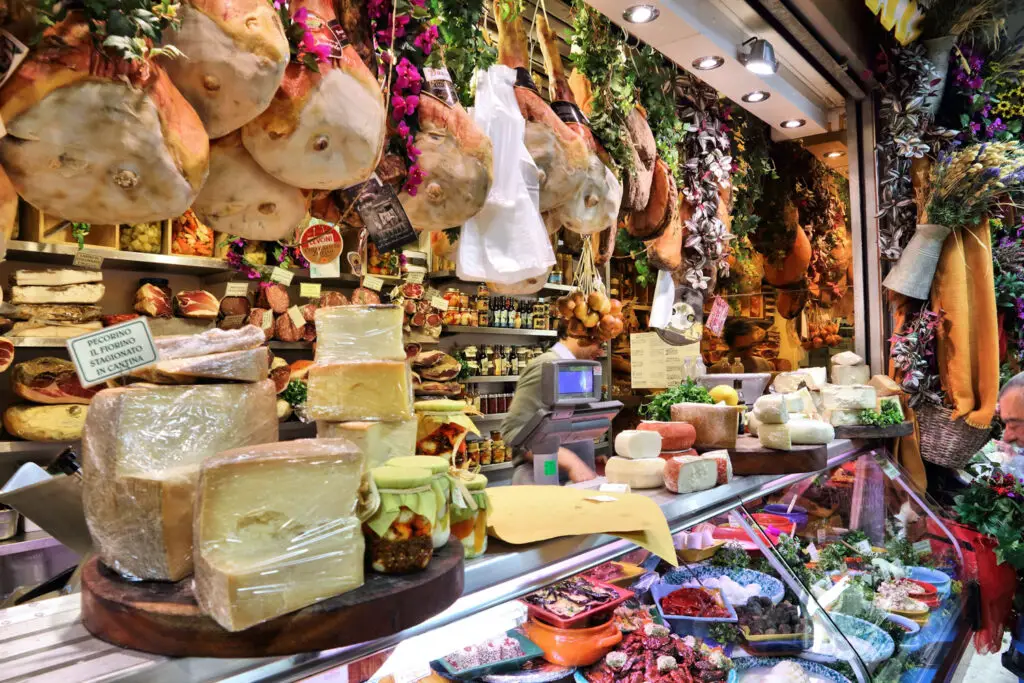
You don’t need to be a food expert to indulge in culinary tourism; all you need is curiosity and an appreciation for good food. As you plan your next getaway, why not let your cravings be your compass and turn each meal into an opportunity to create unforgettable memories?
What sets culinary tourism apart is its participatory nature. You’re not just eating; you’re engaging with the food landscape, meeting producers, chefs, and fellow food lovers.
This kind of travel encourages immersive experiences, such as picking fresh ingredients at an organic farm or learning to make pasta in an Italian grandmother’s kitchen. The stories and skills you bring back from your journey become souvenirs that last a lifetime.
Whether it’s savoring a new taste or understanding the intricate process of making traditional dishes, culinary tourism offers an authentic slice of life wherever you go.
Explore Italy as a food destination: 10 Best Italian Cooking Vacations 2024: Buon Appetito .
Exploring Culinary Tourism
Culinary tourism is about pursuing unique and memorable eating and drinking experiences. Whether you’re munching on local street food in Mexico or enjoying a fine dining experience in Paris, you’re participating in a flavorful journey.
Definition and Scope
Culinary tourism, also known as food tourism or gastronomy tourism, taps into the desire to explore a culture through its flavors. Your culinary adventures can range from local cooking courses to winery tours, encompassing any travel experience where the primary goal is to discover new tastes and food traditions.
According to the World Food Travel Association , this form of tourism is not limited to gourmet food but includes a complete range of experiences.
History and Evolution
The concept of traveling to various destinations to experience the food they offer has historical roots.
Over time, it’s evolved from leisurely aristocratic tours of the 19th century, focusing on European haute cuisine, to a much broader scope today. You’ve got food bloggers, TV shows, and festivals that further popularize this form of tourism, making it accessible to food tourists of all types seeking a taste of authenticity.
Types of Culinary Tourism
You’ll find a delectable array of culinary tourism types to satisfy your appetite for adventure:
- Food Festivals: A chance to try a variety of dishes at one go, usually themed around specific types of food or cultures.
- Cooking Classes: Hands-on opportunities to learn the intricacies of a region’s cuisine.
- Restaurant Tours: Guided tours focusing on a series of eateries known for authentic and innovative culinary creations.
- Street Food Tours: Dive into the heart of the city’s food scene with a food tour dedicated to street food.
- Winery/Brewery/Distillery Visits: Explore the world of drinks from production to the first sip.
- Farm or Market Tours: Get a fresh perspective by tracing the journey of ingredients from source to plate.
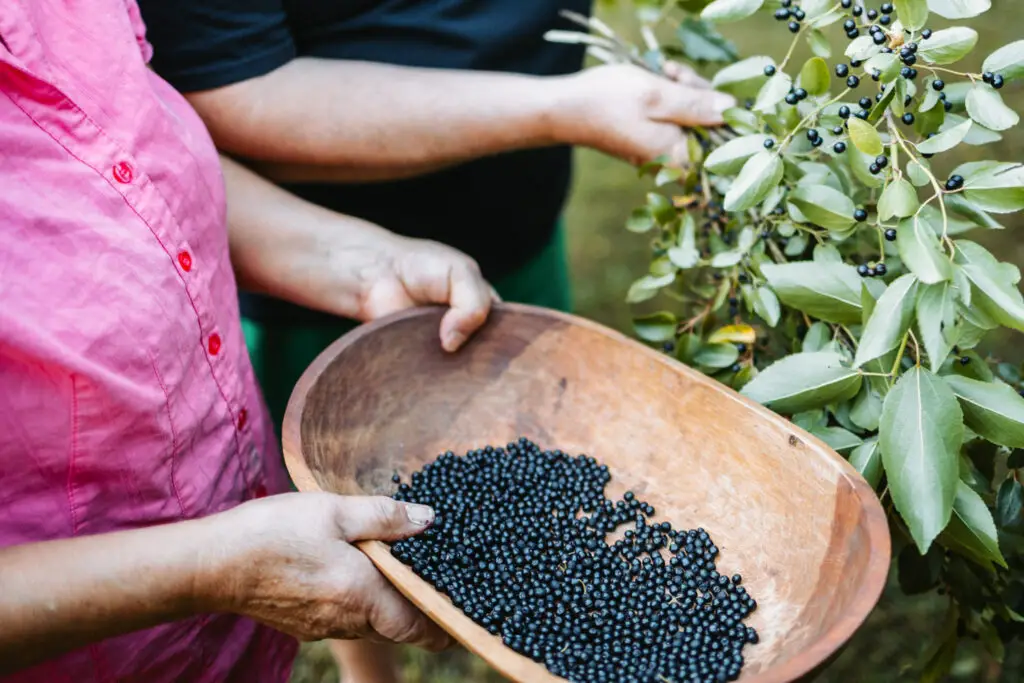
The Culinary Tourism Experience
Culinary tourism spotlights the delicious intersection between exploring new destinations and savoring their unique food offerings. Your journey will lead you to taste the essence of the region’s culture and history expressed through its cuisine.
Savoring Local Flavors
Immerse yourself in the rich tapestry of local gastronomy by indulging in regional specialties. Authenticity is emphasized, whether it’s a street food stall serving fresh, spicy tacos or a renowned restaurant famed for its delicate pastries. You’ll uncover the heart of your destination’s culinary identity, from traditional dishes passed down through generations to contemporary interpretations that fuse different cultural influences.
- Local Specialties : Tasting iconic regional dishes.
- Seasonal Offerings : Enjoying food made from ingredients at their peak.
- Distinctive Food : Discovering what sets the local cuisine apart.
Culinary Tours and Activities
Get a taste of the local scene through organized food tours . These guided experiences often include a curated selection of eateries, each chosen to represent a facet of the culinary landscape. From bustling markets to high-end bistros, you’ll gain an overview of the destination’s dining spectrum. And don’t miss out on the chance to attend cooking classes , where you can don an apron and learn to recreate the flavors of your travels in your own kitchen.
- Food Tours : A guided tour through diverse culinary stops.
- Cooking Classes : Hands-on learning to prepare local dishes.
- Market Visits : Experiencing the hub of local food culture.
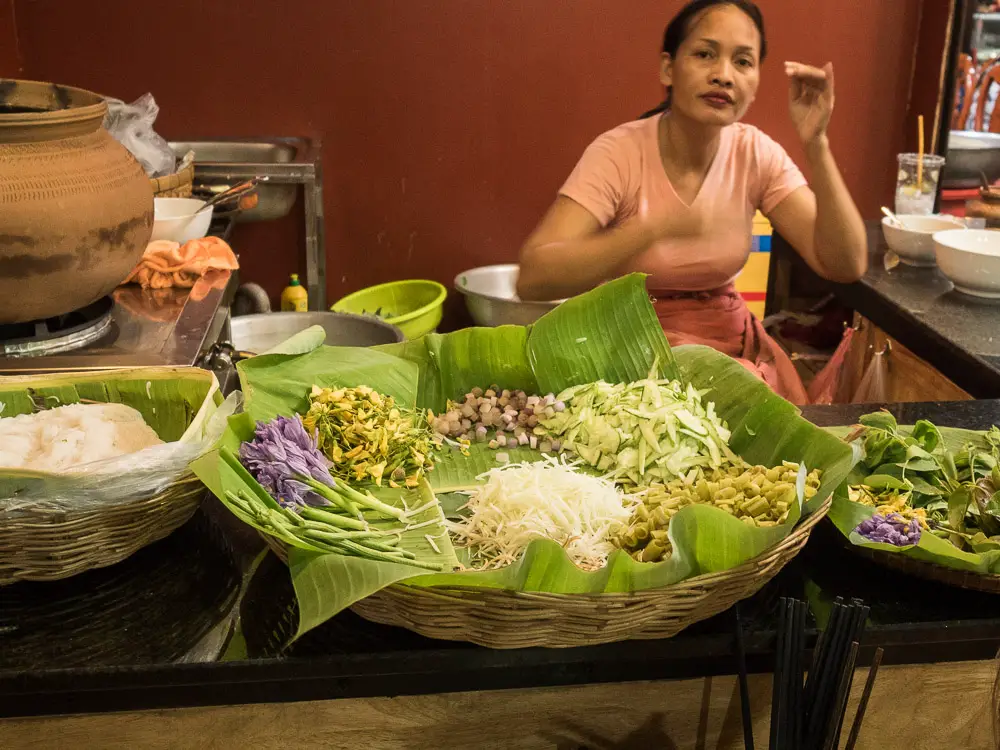
Interactive Food Experiences
Step into an interactive realm where you’re more than just a spectator. Engage with local chefs during cooking classes as they share their secrets and techniques. Pull up a chair at communal tables where meals are shared and stories told, or roll up your sleeves to participate in a cooking workshop. Throughout these experiences, the dynamic of food and drink intertwines with education and community, offering you a deeper connection to the locale.
- Chef-Led Workshops : Deep dives into culinary crafts.
- Tasting Sessions : Sampling a variety of local offerings.
- Food Festivals : Celebrating with fellow food enthusiasts.
Economic and Social Aspects
Food tourism plays a crucial role in shaping destinations’ economic and social landscapes. Tourists contribute significantly to the area’s financial well-being by indulging in local cuisine.
Local businesses, including restaurants and farms, benefit directly from travelers seeking authentic dining experiences, leading to job creation and community development.
In addition to economic impacts, culinary tourism encourages sustainable practices within the food tourism industry. Destinations frequently promote locally grown and harvested foods, which reduces long-distance transportation and minimizes consumption’s carbon footprint.
Moreover, culinary tourism fosters community and cultural connections. Sharing a meal opens doors to understanding the local culture and strengthens bonds within the community.
Global and Regional Cuisines
Exploring the world through taste lets you experience the heart of a culture. Each region’s unique flavors and cooking traditions are showcased in their cuisine, which is often a point of pride.
When you set off on a culinary adventure, you’re not just trying new foods; you’re literally tasting the culture’s history and geography on a plate. Cuisine transforms into an edible map where regional specialties provide a sense of taste of place . For instance:
- Italy : Think beyond spaghetti. Each region boasts its own signature, like the creamy risottos of the north and the zestier, olive-oil-rich dishes of the south.
- Japan : It’s not just sushi and ramen. Delicate flavors and meticulous presentation reflect the country’s aesthetic and philosophical ideals.
- Mexico : Dive into the tapestry of Mesoamerican and European influences with dishes ranging from the complex Oaxaca moles to the coastal areas’ fresh seafood ceviches.
- France: Its cuisine is a cornerstone of the world’s fine dining. From classic sauces to perfectly-executed tartes, you’ll enjoy the artistry of French cooking.
Educational Aspects

Exploring the educational aspects of culinary tourism, you’ll have the opportunity to expand your knowledge and skills in food preparation and production. Through hands-on experiences and expert insights, you’ll get an in-depth look at the culinary world.
Culinary Workshops and Cooking Classes
You’re in for a treat with culinary workshops and cooking classes where professional chefs share their secrets. You’ll learn:
- Techniques : Master the art of slicing, dicing, and sautéing.
- Recipes : Take home new recipes to impress friends and family.
- Presentation : Discover the importance of plating for a visual feast.
Brewery and Winery Tours
Next up, brewery and winery tours allow you to dive into the beverage industry. You’ll experience:
- Processes : Understand the steps of brewing beer or crafting wine.
- Tastings : Develop your palate through guided tastings.
- Pairings : Find out the art of pairing drinks with food.
Learning About Agriculture and Local Produce
During your journey, paying a visit to farms or markets lets you appreciate agriculture and local produce . Here’s what’s on the menu:
- Farming Methods : Gain insight into organic and sustainable practices.
- Local Ingredients : Discover the freshest, locally sourced ingredients.
- Seasonality : Learn how to cook with the seasons for optimal flavor.
In conclusion, culinary tourism is more than just indulging in a region’s food and drink; it’s about immersing oneself in the local people’s culture, traditions, and lifestyle.
Whether you’re tasting a farm-to-table meal in a rural setting or savoring a gourmet dish in a city’s bustling heart, you’re participating in a global phenomenon that fosters sustainability, boosts local economies, and deepens cultural connections.
So, the next time you ask yourself, “What is Culinary Tourism?” remember that it’s an adventure of taste that connects us to the heart of a destination and its people, making travel experiences truly unforgettable.
- 7 Best Tuscany Cooking Vacations 2024: A Taste of Tuscany
- 10 Best Cooking Classes in Rome for Italian Cuisine Lovers
Post a Comment Cancel Comment
Your email address will not be published. Required fields are marked *
Notify me of follow-up comments by email.
Notify me of new posts by email.
This site uses Akismet to reduce spam. Learn how your comment data is processed .
UN Tourism | Bringing the world closer
#traveltomorrow, tourism & gastronomy, share this content.
- Share this article on facebook
- Share this article on twitter
- Share this article on linkedin
Gastronomy is about much more than food . It reflects the culture, heritage, traditions and sense of community of different peoples. It is a way of promoting understanding among different cultures, and of bringing people and traditions closer together. Gastronomy tourism is also emerging as an important protector of cultural heritage, and the sector helps create opportunities, including jobs, most notably in rural destinations.
Several destinations are getting ready to restart tourism.
As part of the UNWTO #TravelTomorrow campaign, chefs from around the world show us how to prepare local dishes at home. We are also proud that the UNWTO Ambassadors for Gastronomy Tourism have joined this initiative. Also, UNWTO Secretary-General shared a typical dish of his native Georgia.
All of these are dishes to enjoy while planning our next trip and getting ready to travel again once it is safe to do so.

African cuisine
A tour all about flavors and spices. From Algeria to Zambia, from Cote d’Ivoire to Uganda, the African continent presents irresistible recipes of local dishes. Across Africa, gastronomy tourism can be used to drive economic growth and create jobs, including in rural communities, and help protect and promote cultural heritage.
American cuisine
Latin American and Caribbean combine refreshing bites with slow-cooked traditional dishes, offering a cuisine full of touches that never cease to surprise our taste buds. A major component of history, tradition and identity, gastronomy has also become a major motivation to visit this region.
Asian cuisine
The largest continent in the world offers delicacies for all types of palates. Sweet, sour or spicy, a wide range of mouth-watering flavours is on the table. Gastronomy tourism has a unique ability to contribute to the growth of sustainable tourism in Asia and the Pacific.
European cuisine
From the best known Mediterranean dishes to the cuisine of Eastern Europe, the gastronomy of this region is blends together past and present, tradition and creativity. The diversity and cultural richness of European cuisine has become a leading element in attracting visitors, and gastronomy tourism is helping destinations diversify their sectors and promote rural development.
Middle Eastern cuisine
From Egypt to Saudi Arabia, Middle Eastern cuisine represents tastes and textures of a mosaic heritage of identities. The union between gastronomy and tourism provides a platform to preserve tangible and intangible heritage, to empower communities and to enhance intercultural understanding.

- Skift Research
- Airline Weekly
- Skift Meetings
- Daily Lodging Report
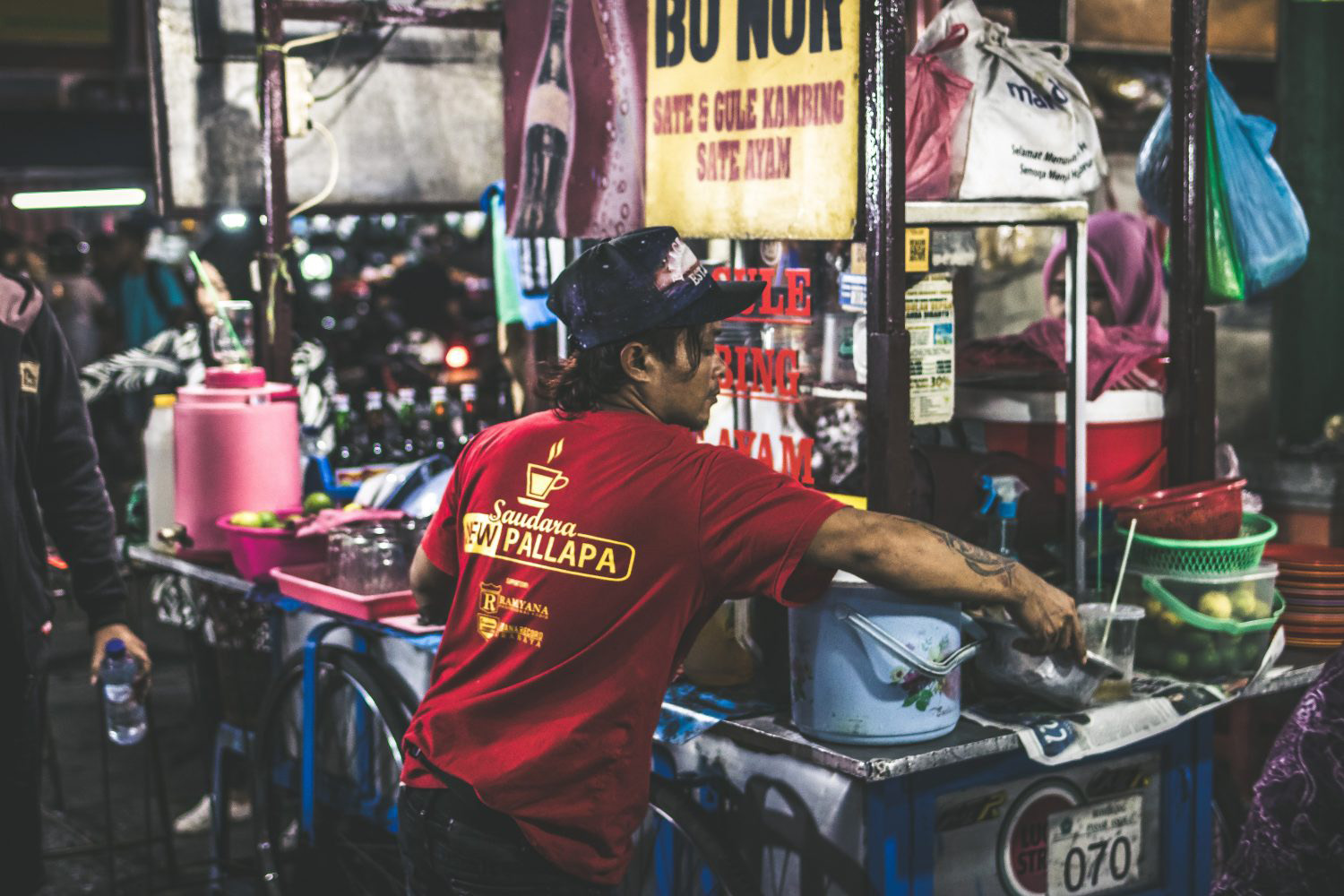
The New Era of Food Tourism: Trends and Best Practices for Stakeholders
Related reports.
- State of Travel 2023: Travel in 250 Charts July 2023
- Destination Marketing Outlook 2022 January 2022
- Sustainability in Travel 2021: Quantifying Tourism Emissions for Destinations June 2021
- EU Traveler Profile and Key Statistics: The Impact of COVID-19 January 2021
Report Overview
Over the past few years, food tourism has been a buzzy trend in the travel industry. Not only is it appealing to a large population of travelers, but it also has the potential to boost in-destination spending, and therefore, positively benefit local economies and small businesses. Despite the buzz, the conversation around food tourism has hardly changed since it first started to spread years ago. Not to mention, there is still some confusion about what food tourism really is and how destinations and other stakeholders can get involved.
In this report, we focus on addressing four questions under the food tourism umbrella: How big and important is the food tourism market? What are the new trends related to food tourism? Who should be be involved in and benefit from food tourism? What are the best practices for various stakeholders? We attempt to answer these questions drawing from the second, expanded iteration of our proprietary food tourism consumer survey. Then, we turn toward breaking down the new definition of food tourism into five components, drawing mostly from a number of in-depth interviews with industry stakeholders and experts. These perspectives then contribute to the final section of the report, in which we have identified 10 best practices for food tourism stakeholders.
Survey Methodology:
Skift Research’s Food Tourism Survey 2019 collected responses from 2,000 respondents who live in the U.S. The survey was fielded to internet users age 18 and over. Respondents were asked whether they’ve taken a leisure trip in the past 12 months that included at least one-night’s paid stay and was 50 miles or more from home. We refer to this group as “recent travelers” (N=1,373) to compare to the total population (“all respondents”, N=2,000). The survey was fielded by a trusted third-party consumer panel provider.
What You'll Learn From This Report
- What food tourism means and how it has evolved over time
- Who the stakeholders are in food tourism
- A comprehensive look at who food tourists are today, how they behave, and what they prefer
- Skift Research estimates for food and beverage expenditure by U.S. travelers
- Size of U.S. food tourist population
- The kinds of food and beverage based activities food tourists are most likely to participate in
- The percentage of food tourists who have taken a vacation with a food and beverage experience as the main purpose for the trip
- A five-part breakdown of the new definition of food tourism
- 10 best practices for food tourism stakeholders today
Executives Interviewed
- Benjamin Ozsanay - CEO & Co-Founder, Cookly
- Camille Rumani - COO & Co-Founder, Eatwith
- Didier Souillat - CEO, Time Out Market
- Erik Wolf - Executive Director, World Food Travel Association
- Helena Williams, Ph.D. - Researcher, Tourism & Hospitality, Texas Tech University and CEO, Gastro Gatherings
- James Imbriani - Founder, Sapore Travel
- Javier Perez-Palencia - CEO and Chair of the Board, FIBEGA Miami 2019 International Gastronomy Tourism Fair
- Joanne Wolnik - Tourism Development Manager, Ontario’s Southwest
- Michael Ellis - Chief Culinary Officer, Jumeirah Group
- Robert Williams, Jr. PhD. - Susquehanna University and Senior Partner, Mar-Kadam Associates
- Trevor Jonas Benson - Director of Food Tourism Innovation and lead consultant, Grow Food Tourism at the Culinary Tourism Alliance
Executive Summary
In 2016, Skift Research published a report called Food Tourism Strategies to Drive Destination Spending . This was at a time when “food tourism” was taking off as a buzzy trend in the travel industry. Now, almost three years later, we’re taking a look at where food tourism is today, how it’s changed, and best practices for stakeholders.
Food tourism is often approached with the destination in mind, as Skift Research did in 2016, and developing and promoting it is often cast off as the sole responsibility of destination marketing organizations (DMOs) or regional tourism offices (RTOs). Clearly, these organizations have important roles to play, but they don’t exist alone when it comes to food tourism. In the new era of food tourism, many stakeholders have the opportunity to help develop, promote, and eventually benefit from this type of tourism.
In this report, we lay out what food tourism is today and how it has changed from years past. We build this definition from an in-depth understanding of who food tourists are today, drawing from the second, expanded iteration of our proprietary food tourism consumer survey. After providing a comprehensive look at the consumer side of the equation, we turn toward breaking down the new definition of food tourism into five components, drawing mostly from a number of in-depth interviews with industry stakeholders and experts. These perspectives then contribute to the final section of the report, in which we have identified 10 best practices for food tourism stakeholders.

Food Tourism Demystified and Defined
Terminology.
These are a few commonly used terms that encompass food and beverage tourism experiences:
- Culinary tourism: Some sources prefer using this term because it more clearly encompasses beverage-based experiences in addition to food-based.
- Gastronomy tourism: Similarly to “culinary tourism,” some sources prefer this term because of its all-encompassing connotation. This term is most commonly used in Europe.
- Food tourism: As of 2012, the World Food Travel Association (WFTA) began using the term “food tourism” or “food travel” to describe “the act of traveling for a taste of place in order to get a sense of place,” or put differently, “the act of traveling to experience unique food and beverage products and experiences.” Rather than the type of experience being the differentiator, what matters is the uniqueness of the experience itself and how it is particular to the destination.
For this report, we will follow the lead of the WFTA, which stopped using “culinary tourism” in 2012 when its research indicated that English speakers tend to associate this term with exclusivity and elitism, neither of which should be inherent to food tourism. “Gastronomy tourism” can also be interpreted this way, especially to English speakers outside of Europe. For these reasons, we chose to stick with food tourism, as we believe it better reflects the variety of food- and beverage-based travel experiences we will discuss in this report.
So then what counts as food tourism? This is where the lines can get blurry. Almost all tourists need to eat at an eating place while traveling, so almost all contribute to the local food economy in some way. Broadly speaking, these can all be counted as food tourism.
A bit narrower than that, some sources define food tourism as food and drinking activities that are unique to a region/destination and include aspects beyond simply eating or drinking. With this in mind, food tourism experiences most commonly include cooking classes with locals, food and drink tastings, having meals in locals’ homes, eating at local restaurants or street food vendors, food and drink tours and trails, collecting ingredients or participating in harvesting local produce, visiting farms or other types of food producers, visiting food markets or fairs, and visiting food manufacturers such as distilleries, factories, and wineries.
An even narrower scope through which to look at food tourism is whether it is deliberate food tourism or incidental food tourism. Deliberate food tourism only includes food and drinking activities that are the main motivator for a traveler to go to a destination, while incidental are those that travelers participate in, but were not the main purpose of the trip. We will discuss these terms in more detail from the consumer perspective later in the report.
Each of the above ways of describing food and beverage related tourism is correct. Variations in data on food tourism can often be due to different definitions and scopes used for the research. Later in this report, we will provide data on these three ways of counting food tourism.
Stakeholders
Another important part of food tourism to mention here is the variety of stakeholders that are involved. Developing and promoting food tourism is often discussed as responsibilities of destination marketing organizations (DMOs) or regional tourism offices (RTOs). However, this report will emphasize that there are multiple stakeholders that can, and should, have a part in building and participating in a region’s food tourism space. Of course, DMOs and RTOs can and should play important organizational and planning roles, but tour providers and operators, traditional travel agencies, online travel agencies and booking platforms, peer-to-peer platforms, hotels, local restaurateurs, and more have the opportunity for involvement in food tourism.
While this lays out the basic elements of food tourism that we’ve built this report around, it’s very likely that we will need to revisit what we’ve summarized in the near future. The term, scope, and even stakeholders will constantly evolve as destinations, cultures, and trends change over time. Later in this report, we will examine the nuances of what defines the new era of food tourism that exists today compared with a few years ago. But first, we will take a look at the current state of the food tourism space for context.
The State of Food Tourism Today
Food tourism is a lucrative market.
Just how big is the food tourism market? As we laid out above, there are three ways to size up the food tourism market. In the broadest sense, it includes all food and drink based activities that travelers partake in, whether it’s eating at a chain restaurant, taking a food tour, or visiting a local brewery.
To get a sense of food tourism’s contribution to local food economies in this broad sense, Skift Research looked at all food and beverage expenditure by U.S. travelers for domestic and international travel. We analyzed data from the U.S. Bureau of Labor Statistics Consumer Expenditure Survey to determine how much money American travelers actually spend on food and drink while traveling. While this data includes spending on all food and drink while traveling (i.e. not just the local, unique experiences that many consider “food tourism”), it nonetheless gives us an idea of the potential economic impact food tourists can have and how it has changed over time.
Our estimates show that U.S. travelers spent $58 billion on food and drink while traveling in 2017 (the last year for which data was available at the time of writing). This represents a 5.8% compound annual growth rate from 2012.
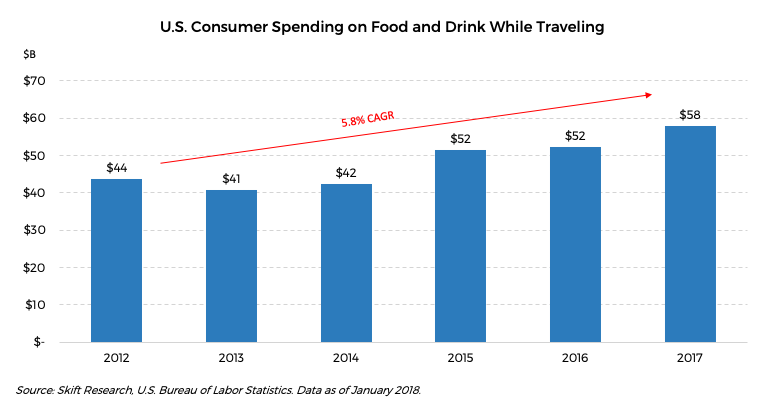
To look at this another way, we calculated the share of total travel expenditures spent on food and beverage by U.S. travelers. Here, we see an overall upward trend from 2012 to about 25%, where it has more or less hovered since 2015. This falls in line with the WFTA’s estimate from its 2016 Food Travel Monitor that global travelers spent about 25% of their travel budget on food and beverages, and this can be as high as 35% in certain destinations or for especially food-centric travelers
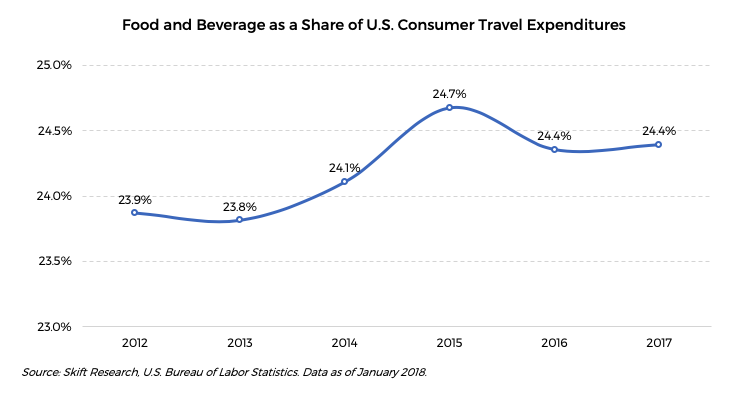
We then turn our attention to a narrower, more local scope of food tourism. While researching for this report, we found that despite the rising popularity and interest in food tourism across many related sectors, there is very little data on a clearly defined food tourism segment. We conducted our own survey for the purpose of providing some necessary context to the trends.
According to our food tourism survey, 96% of respondents have participated in some kind of experience that would fall under this slightly narrower food tourism umbrella (i.e., dining out at restaurants that serve local cuisine is included). This increases slightly to 98% for those respondents who have traveled for leisure in the past 12 months, who we call “recent travelers.” This falls in line with the WFTA’s 2016 Food Travel Monitor finding that 93% of travelers could be considered “food travelers” at some time, based on their participation in food or beverage experiences. This estimation, however, does not include travelers who only dine out in-destination.
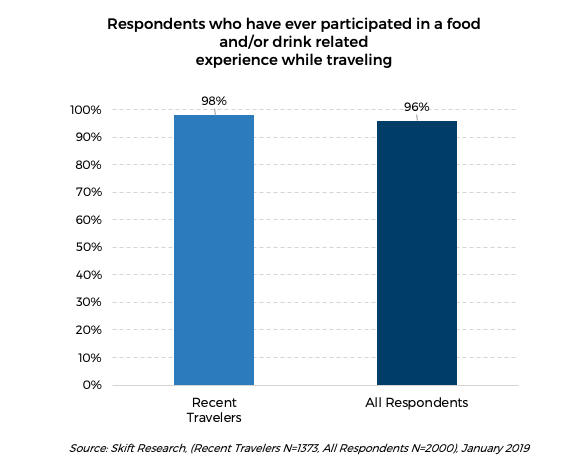
For more nuance, the chart below shows the type of food and/or drink related experiences that our respondents have participated in while traveling, divided again by recent travelers and the average for all respondents. Unsurprisingly, most respondents have dined out at a restaurant that serves local food while traveling, with about 80% of recent travelers reporting this.
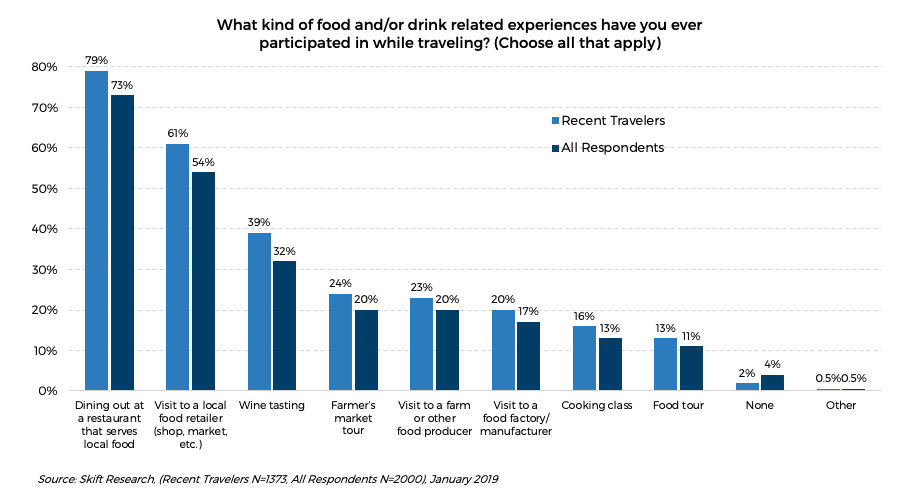
Next, we focus in on the narrowest scope of food tourism. We asked our respondents whether they’ve ever gone on vacation with a food and/or drink related travel experience as the main purpose of the trip. Among all respondents, one-third responded that they have. For respondents who have traveled in the last 12 months, 42% said so. This is a very significant number for relevant stakeholders who work to use food experiences to attract tourists.
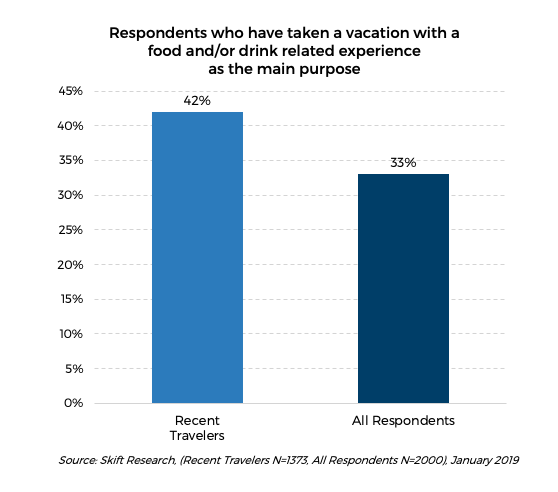
When looking at the specific types of experiences that these travelers planned their trips around, wine tasting claims the first spot, with 52% of respondents saying they’ve gone on trips with that activity as the main purpose. We will discuss more details later in the report.
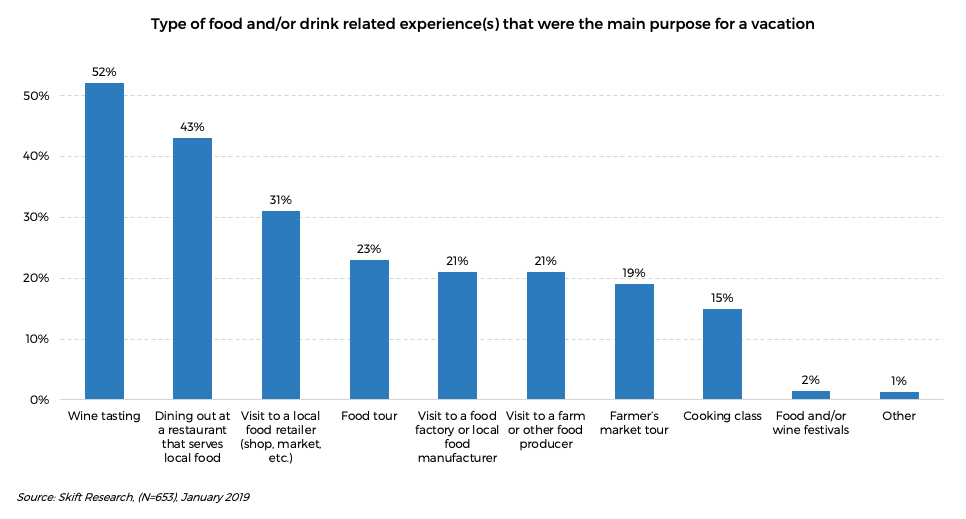
Food Tourism Experiences Grow in Popularity
Food and drink experiences have long been an important part of travel. However, food tourism is reaching new levels of popularity and is manifesting in more exciting ways than ever. Data from TripAdvisor , for example, showed that food tours and cooking classes were among the top-five fastest growing tour categories in 2017, each with 57% bookings’ growth on the platform. Food tours also saw the most growth by gross booking value that year.
Food and drink-related activities also show high levels of popularity on Airbnb’s Experiences platform. According to an Airbnb spokesperson Skift Research spoke with in February 2018 for our report The State of Tours and Activities 2018 , bookings of these types of Experiences accounted for around 29% of the platform’s total bookings at the time.
Not only are bookings of food tourism experiences growing, but there are also signs that traveler satisfaction with them is high. TripAdvisor recently released the winners of its 2018 Travelers’ Choice Awards, which includes awards for experiences listed on its platform. The winners are determined using an algorithm that takes into account a business’s reviews, opinions, and popularity with travelers over the last year. On the list of the Top 25 Experiences in the World , seven of those selected are either entirely food based, or include a unique, local food portion within the experience. The number one spot, in fact, was taken by an entirely food-based experience: a cooking class and lunch at a Tuscan farmhouse which includes a tour of a local market in Florence.
The Rise of Niche, Food- and Beverage-Related Businesses
Outside of food tourism experiences designed purely for travelers, we see growth in other food- and beverage-related businesses. In Skift Research’s 2016 report Food Tourism Strategies to Drive Destination Spending , we called out the “rise of beer, spirits, and coffee tourism.” This trend was largely being driven by the explosive growth of craft breweries at the time. Since then, this growth has slowed, but still remains steady, with small and independent craft brewers maintaining 5% growth in the first half of 2018 in the U.S. according to the Brewers Association , showing that the demand is still there.
Food halls are another niche, local food- and beverage-related business type that is undergoing huge growth currently. Cushman & Wakefield, one of the largest U.S. commercial real estate brokers, has been tracking food hall development in the U.S. since 2015. In that year, it noted 70 projects. By the year’s end in 2017, this number went up to 118 and was expected to reach 180 by the end of 2018. The firm estimates that there will be 300 food halls in the U.S. by the end of 2020.
The growth of craft breweries and food halls may not be entirely due to the rise of food tourism, as many locals also enjoy these venues. However, it is safe to say that the same interests that are driving food tourism are contributing to the growth of these types of businesses. Craft breweries, food halls, and the like also become attractions in and of themselves, thereby also contributing back to the rise in food tourism.
Industry Sentiment About Food Tourism Today
Clearly, food tourism deserves our attention. Stakeholders in the space agree. According to a survey of DMOs, educational institutions, marketing and consultancy firms, accommodation providers, the meetings industry, food and beverage providers, and wineries in the UNWTO’s Second Report on Gastronomy Tourism , the majority of respondents agree that gastronomy is a driving force for tourism development (with an average of 8.19 on a scale of 1 to 10, where 10 is “strongly agree”).
Even so, many respondents to this survey didn’t feel that their marketing efforts in this area were adequate. For example, while 70% of respondents said they have targeted food tourists as a specific market segment, only 10% think that this segment receives enough promotion in the destination. Further, just 46.5% report that they have a food tourism strategy in place, while just under 25% say they allocate budget specifically for attracting food tourists. These survey results emphasize the need for all stakeholders to contribute toward developing and promoting the food tourism in a region. We will discuss this more later in the report.
Who Are Food Tourists Today?
Because food tourism activities vary so much, it’s difficult to say exactly who food tourists are from a demographic perspective, as it varies so much depending on the activity. From our own survey, we found that Millennials and young Gen Xers make up the majority of our U.S.-based respondents who have ever participated in a food tourism experience other than dining out at chain restaurants. The age distribution is the same for food tourists who have traveled in the past 12 months.
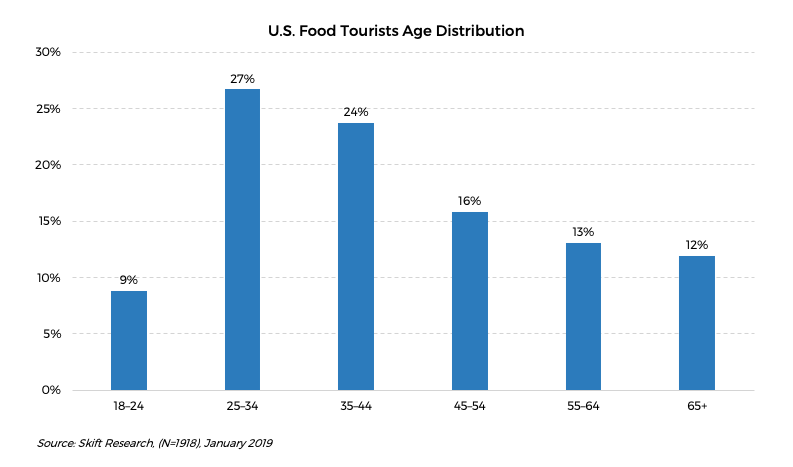
Today’s Food Tourists Are Curious and Crave Unique Experiences
Throughout our interviews with food tourism stakeholders, we heard the theme that food tourists are curious people who desire unique experiences that revolve around food. Camille Rumani is the COO and co-founder of Eatwith, a peer-to-peer app that connects travelers and locals around food experiences in 130 countries. She describes the guests who use Eatwith as “People who, for example … want to get off the beaten path, I would say, do something that is a bit different, but also have the feeling, they don’t want to be a tourist. … they will also value the fact that it’s not the same thing that they’re doing as anyone else.”
Joanne Wolnik, tour development manager for the regional tourism office, Ontario’s Southwest, echoed these sentiments when describing the typical food tourists in her region: “It’s people that are curious, people that have an appetite to learn new things. This is the same whether they’re coming for a tasting experience or their coming to make chocolate truffles, it’s people that want to learn.”
Today’s Food Tourists Aren’t All “Foodies” or “Gourmets”
It is easy to make the mistake of conflating food tourists with foodies, but today, these two groups don’t fully overlap. A study by Fogelson & Co. , a food brand strategy and marketing agency, articulated the larger trend of moving away from using “foodie” to describe people who have a deep connection to food. The study explains that “foodie” used to depict a niche minority, but a deep interest in food is now mainstream. Further, it argues that a “foodie” is often thought of as being a person who is in “some sort of exclusive gourmand group of hyper-passionate food people,” when in fact, this is not the case for many consumers who feel connected to food.
To compensate for this disconnect, Fogelson & Co. recommends a new consumer category: the “food connected consumer.” This group views cooking and eating as fun experiences and as opportunities to explore. In fact, 63% of these surveyed consumers reported that they love to travel.
This distinction between the traditional “foodie” group and the new “food-connected consumer” is important when thinking about building and promoting food tourism. Trevor Jonas Benson, director of food tourism innovation and lead consultant for Grow Food Tourism at the Culinary Tourism Alliance, explained that he has observed the success of destinations that look beyond foodies. “No longer are destinations concentrating on a very small percentage, hyper-niche market of foodies and gastronomic interested people … but they’re starting to understand that any and all experiences can often be enhanced through food and drink.”
Our survey results further illustrate this point. We asked respondents which category of food and/or drink related activity is most appealing to them when traveling. The results show that the often more casual categories of “Markets, festivals, and speciality grocers” was selected the most, followed by the also casual category of “Gastropubs, burgers, and beer,” while “Gourmet, upscale, classic” falls to the fifth position among all respondents.
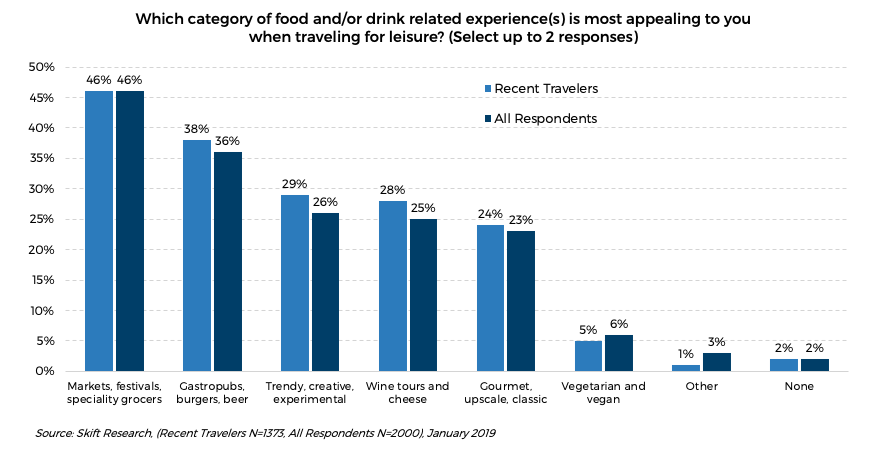
We asked a variation of this question for our 2016 report, Food Tourism Strategies to Drive Destination Spending , and similar trends were observed. However, “Gastropubs, burgers, beer” took the top spot then, and “Gourmet, upscale, classic” ranked one spot higher (please note, however, that respondents were not given “Other” or “None” options in 2016).
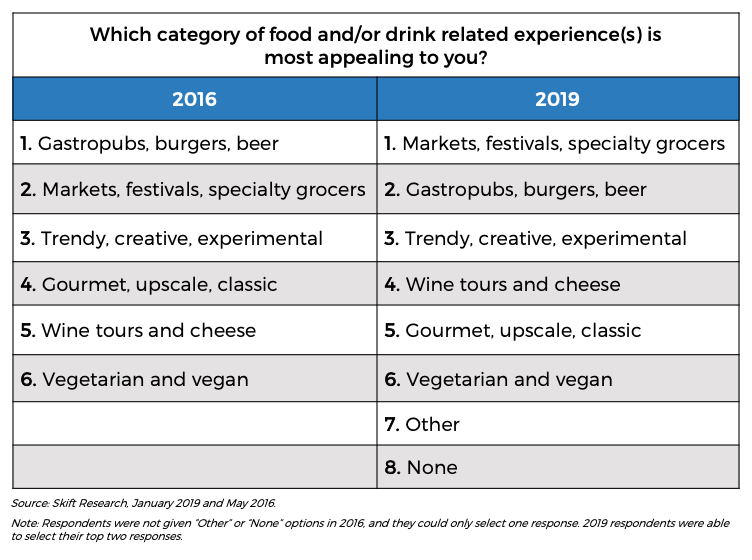
Still, the point remains, that while food tourism can be upscale and gourmet, it doesn’t have to be. In fact, more people prefer more casual types of experiences.
Today’s Food Tourists Can Be Divided into Two Main Groups: Deliberate and Incidental
A common way to segment food tourists is based on whether food and/or drink related experiences are their main motivation for travel or not. These groups are often referred to as “deliberate food tourists” and “incidental food tourists.” Skift Research spoke with Helena and Robert Williams, Ph.D.’s, researchers and academics with expertise in food tourism. They have researched the differences between deliberate and incidental food tourists extensively. Helena explained that deliberate food tourists will plan out their trips for weeks to include as many food experiences as possible, or a few of the most interesting ones: “They’re thinking about the food related experiences, not what restaurant they’ll eat in but can they go to a cooking class, can they go to a plantation, can they go to a winery, will there be some other cultural experiential thing they’ll learn about.”
Incidental food tourists, on the other hand, would still likely fall into the “food connected consumer” group we discussed above, but they are traveling for another reason, such as to visit friends or family, go to a conference, etc. Because they still appreciate food though, they will look for any free time they have to fit in food and/or drink related experiences.
Distinguishing between deliberate and incidental groups is important for food tourism stakeholders looking to develop and promote themselves to “food tourists” because they are likely to be interested in slightly different kinds of experiences and also need to be targeted in different ways and at different times in their journey.
The data below (which we discussed as Exhibit 4 above), for example, shows that the most common food and/or drink related travel experiences are those that have the option to be planned well in advance, but are also commonly done spontaneously (dining out at a restaurant that serves local food and visiting a local food retailer). In other words, these are experiences that are appealing to both deliberate and incidental food tourists. Those that require more pre-planning tend to fall toward the bottom of the list (cooking class, food tour).
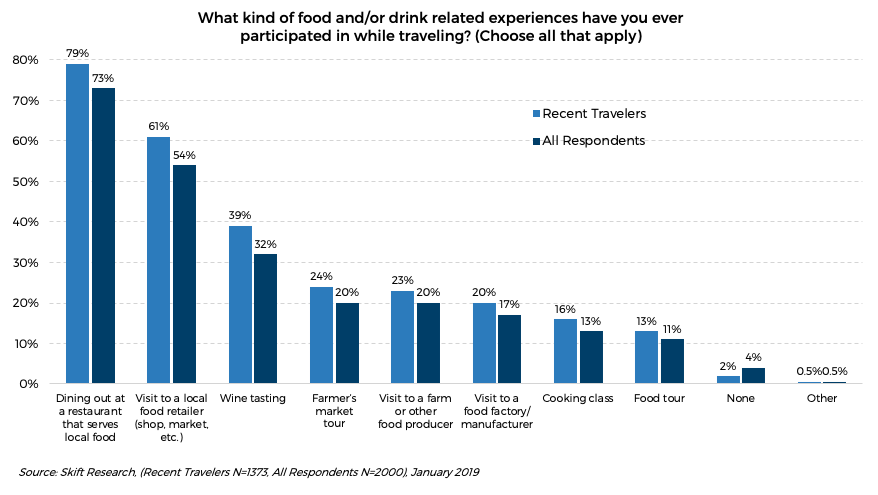
The popularity of these experience types changes when we look at those that were the main purpose of a vacation. Wine tasting moves to the top spot and food tours is the fourth-most common experience type that travelers have planned trips for specifically.
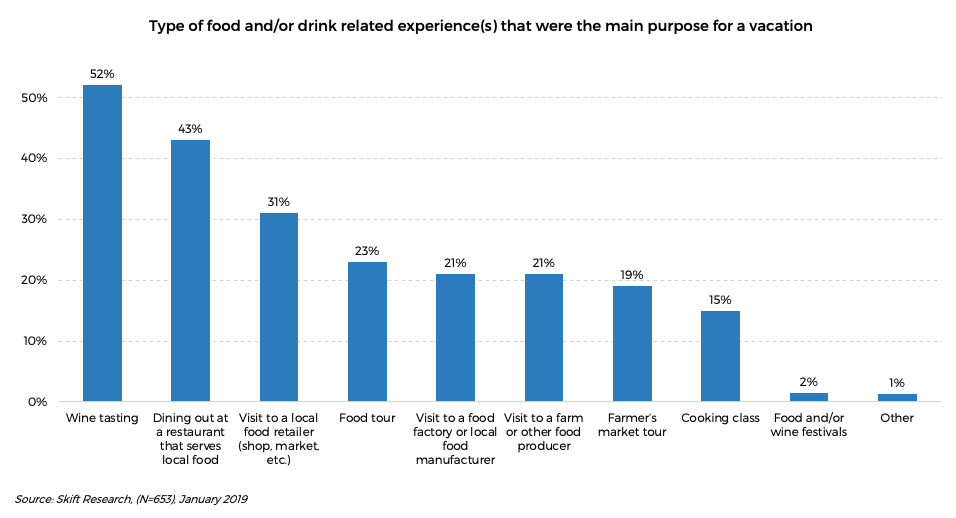
Joanne Wolnik of Ontario’s Southwest described how her organization uses this type of distinction when developing food tourism in the region. She explained that her team not only works to make sure that there are local, exciting options for tourists who are looking to dine out, but also that there are plenty of reasons for deliberate food tourists to make a trip to the region as well. “This is the side that we are really trying to grow. We’ve got awesome people that are here already doing really cool things … so we are building reasons for people to travel for food specifically.”
Today’s Food Tourists Often Plan Their Trips Around Food
Whether they’re incidental or deliberate, food tourists today are more commonly choosing destinations at least in part because of their food offerings, even if this is not the main purpose of a trip. They are also often planning other parts of their trips around food and drink experiences. As Camille Rumani of Eatwith explained, unique food offerings used to be a “nice to have. Now they [destinations] need to have that. People are really looking for it, and they also choose destinations more and more based on the food offerings.” Javier Perez-Palencia, CEO and chair of the board for the international food tourism festival FIBEGA Miami, summed this up by saying “Gastronomy is an attraction.”
Skift Research also spoke with Michael Ellis, Jumeirah Group’s chief culinary officer and former global director at Michelin Restaurant and Hotel Guides. From his experience in both roles, he has observed the emerging trend of travelers basically going on “gastronomic pilgrimages,” where they choose a destination like Copenhagen specifically to eat at Noma, or Madrid to eat at DiverXO. Even for incidental food tourists, it’s common for them to use the food experiences they do incorporate as starting points to plan their other activities. “Everything else will come from there,” he explained, “whether it’s shopping, or cultural, or sporting events, whatever they want to do. That will be organized around where they have their lunch or dinner reservations.”
An area’s food offerings are also an essential component food tourists consider when choosing accommodations. Robert Williams explained that it’s important for hotels to realize that this is becoming more common. “What hotels are beginning to do is instead of trying to be all inclusive, they realize that … some of their customers look for the food experience first … versus the other way where you pick the hotel in the location and then see what you can do while you’re there.”
Interestingly, the total trip expenditure of incidental food tourists might not vary that much from that of deliberate food tourists, despite their varying levels of motivation by food. This was something that Helena and Robert Williams found through their extensive research on the subject, a finding that Helena refers to as “one of the most profound things to come out of my research.” She explained that the spending by these two groups is pretty comparable, and that the spending of incidental food tourists, “if not equal, it’s more than the deliberate traveler because they’re already there for some other reason and their time is more compressed, but they still want these wonderful experiences.” In a 2018 paper they published in the Journal of Gastronomy and Tourism with Jingxue (Jessica) Yuan, two surveys of self-identified food tourists revealed that 60% spent the most money on a deliberate food tourism trip, while 40% reported that it was an incidental trip. This research further emphasizes why both groups of food tourists are important to target and attract.
Defining the New Era of Food Tourism
Now that we have a better picture of who food tourists are today, we will focus on what food tourism is today beyond the general definition we discussed at the beginning of the report. It’s impossible for food tourism to remain static, as cultures, the environment, and consumer demands are in constant flux. Drawing mainly from our interviews with expert stakeholders, we’ve identified five key components that define the new era of food tourism. For each component, we’ve included relevant perspectives from stakeholders and case studies.
Food Tourism Is About More Than the Food Itself
The types of experiences that define the new era of food tourism are about more than just food or beverages. Our interviewees brought this up repeatedly in multiple ways. This is the biggest part of the new definition of food tourism and is multifaceted. Today, the food tourism experiences that best exemplify what food tourists want meet at least one of the following criteria: they overlap with other types of tourism (such as cultural tourism, historical tourism, agritourism, etc.), they have a hands-on learning aspect, and they are social.
- DMO/RTO: Joanne Wolnik, of Ontario’s Southwest explained how her team divides experiences into three categories: culinary, waterfront, and significant events. She explained that “the main two are waterfront and culinary … but we’ve created a lens where [an experience] usually has to overlap with one of the other two. So culinary is quite a high priority.”
- Travel Agency: James Imbriani, founder of the luxury food-themed tour company Sapore Travel, told Skift Research, “Destinations have a lot of things to offer other than just food and wine. Even if we plan something more historical, if we can tie in food, we like to try.”
- Tour Platform/Operator: Camille Rumani of Eatwith explained that she has been seeing more experiences on the platform that are hosted in unique spaces, like art galleries, rooftops, and even an old London underground station. Looking forward, she foresees that people will become even interested in experiences with interest beyond food: “for example, dinner with a concert, or seeing a play at the same time, or integrating food and music. We see that becoming very, very popular.”
- Case Study: Time Out Market Time Out Market was conceived by Time Out Group, best known for its city-specific online and print magazines that cover entertainment, events, and culture in global cities. The first market opened in Lisbon in 2014 and includes a selection of the best food and drink the city has to offer curated by Time Out editors and presented in a food hall type style. A repeated marketing message of the Time Out Market, however, is “this is more than just a food hall.” In addition to food vendors, the space also includes an academy where cooking classes are taught and a large studio space where concerts and other shows, fairs, conferences, and more are specially curated to represent the city as best as possible. “The magazine is all about food, beverage, chefs, art, culture, music, exhibitions, what’s hot in town now. So we’re bringing the magazine to life physically” said Didier Souillat, CEO of Time Out Market. With this strategy, Time Out Market Lisbon has become the number one tourist destination in the Portugal, and attracts locals as well. Beginning this year, new Time Out Markets will begin opening in other cities around the world and will mimic the mix of offerings in Lisbon, but with localized twists.The mix of offerings within a Time Out Market differentiates it, attracts people initially, and keeps them coming back. As a Time Out Market representative explained, “It’s not just dinner on a Thursday night. It’s dinner and a show, dinner and a reading, dinner and a cultural moment.”
- DMO/RTO: Joanne Wolnik of Ontario’s Southwest told us, “The main thing about food tourism that I’m seeing is that people want something new to them, unique, they want to learn, and they want to go home with new skills. I’m hesitant to say the word transformational again, because I know that’s a little bit trendy right now so I’m being careful, but it’s a new way from them to engage in food and with food.”
- Case Study: Ontario’s Southwest Joanne Wolnik shared some examples of food tourism experiences in Ontario’s Southwest region that illustrate this part of our definition perfectly. One experience is called The Sweetest Smell on Earth, which is run by a maple syrup harvester. The experience, which is offered a limited number of times, begins with a trip on a tractor to maple trees, where participants learn how to tap the tree, collect sap, and are taught historical information about the process. They then are taught how to make their own maple candies and they get to keep a bottle of their own syrup. Next, they’re served a meal by a local chef who incorporates maple into each dish.Wolnik explains that the hands-on, educational parts of this experience make it really resonate with participants: “ … they have bragging rights because they have their own bottle of maple syrup that they bottled themselves, they know how to use the product beyond just putting it on pancakes and waffles, and it really empowers them to use the product. So not only are they learning something new, but now when they go home, it’s changing their behaviors and their habits. So there is a transformational piece to it.”
- Tour Platform/Operator: Social interaction is a key component of the peer-to-peer experiences available on Eatwith. Camille Rumani told us that this was one of the main motivators for starting the company. “We saw that because usually you’re a tourist when you’re traveling, it’s such a paradox to travel so easily nowadays in cities where millions of people are living, but you don’t actually meet anyone when you’re traveling to Barcelona and to New York. You’re usually wondering what’s behind the closed doors, and we wanted to facilitate this experience.”
- Benjamin Ozsanay, CEO and co-founder of the cooking class platform Cookly, expressed similar sentiments: “Over time, we realized that our users and partners were looking for a connection. … This human connection was something we think is missing in ‘food tourism’ as it commonly perceived. We think it is much more than just trying the local street food or visiting the hottest new restaurant. It is about making a human connection across cultures … the essence of travel”
- Case Study: TripAdvisor’s 2018 Travelers’ Choice Awards Top Experience in the World As we mentioned earlier in the report, the top experience in the world according TripAdvisor’s 2018 Travelers Choice Awards was a food-based experience called “Cooking Class and Lunch at a Tuscan Farmhouse with Local Market Tour from Florence.” The description of this experience on TripAdvisor gets right to the core of this part of our food tourism definition. It is described as a “hands-on experience,” where travelers can “explore cuisine in more depth than you would by simply eating in restaurants.” Traveler reviews praise the experience as “interactive,” “educational,” and “social.” They lauded that they “met some lovely people” and enjoyed “hearing about the history in addition to tasting the food.”
Food Tourism Emphasizes the Story Behind the Food
This part of the definition is very closely related to the previous point, in that food tourism experiences today shouldn’t be about just tasting food or beverages, but should go deeper. This aspect of food tourism is about cultures and communities authentically telling their stories through food as a way to attract and interact with tourists. As Trevor Jonas Benson of the Culinary Tourism Alliance described, “we’re seeing a return to the use of language such as ‘authenticity,’ which is really indicative of destinations and communities starting to reclaim what it is that makes them special.”
Food is perhaps one of the easiest ways for people to share something that reflects themselves, their city or region, or their culture. In the words of Camille Rumani of Eatwith “food really reflects the DNA and the soul, I would say of a culture, and basically of people.”
The importance of this aspect of food tourism today is obvious just by looking at the ways food tourism companies describe themselves. Among our interviewees, for example, Benjamin Ozsanay of Cookly described the company this way: “We cultivate a community of users with a love of food, who want to learn about different cultures through local recipes and cooking traditions.” James Imbriani of Sapore Travel also emphasized that his company creates “meaningful, cultural exchanges through food and gastronomy,” and that this is what food tourism should be at its essence.
- Case Study: Cookly In addition to incorporating more of the story behind the food into food and drink related experiences, this part of our definition can also be translated through marketing and branding. Cookly, a platform that connects food loving travelers with food professionals for cooking classes serves as a case study of this. The platform recently changed its logo from a chef’s hat to a mortar and pestle. While the company’s founders originally envisioned connecting travelers with cooking schools, CEO & Co-Founder Bejamin Ozsanay explained, “over time, we realized that our users were looking for more of a connection with the food, culture, and local traditions of a place. The mission was not just about taking a cooking class on your trip, but immersing yourself in the local community and sharing knowledge about the world. Our new mortar and pestle logo reflects our brand’s evolution.”
Food Tourism Is Conscious and Thoughtful
Conscious consumption is permeating throughout many industries, and travel and food tourism aren’t immune. In fact, the new era of food tourism is defined by its conscious and thoughtful nature. The best food and drink experiences for travelers today consider environmental sustainability as well as community and economic impact. This is especially important in developing destinations with fragile ecosystems. Sharing culture and interacting with travelers is beneficial to locals, but without care for the environment and a direct economic impact, these things are meaningless.
- Travel Agency: James Imbriani of Sapore Travel explained how conscious consumption has impacted food tourism: “Also we’ve seen the shift in mindset, even when it comes to the food you’re cooking and eating at home, where people care a little bit more about where their food came from, the processes behind them, how they’re made, the care and love producers put into their products, as opposed to just blindly consuming things. We’ve seen that people are more willing to travel to find these things out, and for me that’s exciting.”
- DMO/RTO: Joanne Wolnik and her team at Ontario’s Southwest aim for economic, social, and environmental benefit as a result of food tourism experiences in the region: “We don’t want to devalue what our operators and artisans and all of our partners are bringing to the table, because ultimately, the whole point of tourism should be the benefit that the travelers bring to the local community both economically and socially, and we strive for environmentally as well.”
- Hotel: Michael Ellis of Jumeirah Group is highly aware of the desire food connected travelers have for local products: “People want to, wherever they are, they want to eat like locals, they want to have a local experience. They want to have locally grown products. They want to have ingredients that, if possible, come from not too far away from where they’re being consumed.” The challenge here is that most of Jumeirah’s hotels are in desert environments, like Dubai. “… there’s not a whole lot that’s produced here. Most things are imported,” he explained. Even so, Ellis sees this as a challenge worth overcoming. “But, having said that, we are in the process now of identifying local producers for a wide variety of products including organically grown vegetables and poultry and eggs. … we are really excited about our ability to bring locally, organically produced, sustainably developed products into our restaurants.”
- Ensuring that food and drink travel experiences — whether it’s a food tour, a meal at a hotel, etc. — are conscious and thoughtful about the local environment and communities might present some initial challenges. But, in the end, they can be the deciding factor for food connected travelers, especially those who are millennials and younger. Research by tour operator Intrepid Traveler found that 90% of millennials consider a travel company’s ethical commitments when booking, and Gen Z is already showing signs of being conscious consumers. A study by McKinsey found that 65% of Gen Zers try to learn the origins of anything they buy and 80% won’t buy products from companies that have been involved in scandals. As these groups continue to become a larger share of the travel market, we can anticipate that this part of food tourism will grow in importance.
- Case Study: Feast On by Culinary Tourism Alliance The Feast On certification program was launched by the Culinary Tourism Alliance in 2015. Skift Research discussed the program in our 2016 report . Its growth and success since then warrant us to revisit it as a case study now. The program works mostly with restaurants, and also commodity groups and local producers, to verify that they are buying and celebrating food local to the Ontario area.
- Participants who meet the stated criteria pay a small fee and in return “we celebrate them through many different ways: through communication, through events, etc.” explained Trevor Jonas Benson who helped create the program. This program is one example of how food and beverage businesses can convey to locals and tourists alike that they approach food with their communities in mind. As the program’s website expresses: “Supporting our local economy and Ontario’s farmers is important; especially for the food service industry. It builds our local food identity, it puts dollars back into our communities and it limits our environmental impact.”
- As of September 30, 2018 the program has certified 137 restaurants, up from the 120 cited in our 2016 report. Perhaps the best way to measure the success of the program is by the expenditure of its participants on local Ontario food purchases, which all are required to report. In 2018, this number totaled $25,140,000 up from the approximately $15,000,000 cited in 2016. This is all money that is staying in the local region and going directly into the communities these businesses are a part of.
Food Tourism Can Promote Exploration Outside of Main Areas and Attractions
One way for food tourism experiences to be conscious and thoughtful to the environment and local communities is to encourage exploration outside of main areas and attractions in a destination. This is something that food tourism is already doing and we expect it will become an even more important part of these experiences in the future.
The size of the current and potential food tourism market is a bit of a double-edged sword. Erik Wolf, CEO of the World Food Travel Association explained, “This can be great news to destinations that are willing to plan carefully for success, but it also can add fuel to the overtourism fire in popular food-centric cities like Portland, Oregon and Barcelona, Spain.”
Encouraging tourists to get outside of the main areas of a destination doesn’t only benefit the local community, it’s also something that more and more food tourists are desiring. Benjamin Ozsanay of Cookly attributes this to the “exploding popularity of travel-culture-food shows like No Reservations, Parts Unknown, and Salt Fat Acid Heat [that] has thrust culinary tourism into the mainstream and we have seen increasing numbers of travelers across all markets searching for similar experiences.”
- Travel Agency: Getting tourists outside of main areas and attractions has benefits beyond easing overtourism. These are the types of experiences food travelers want and they can also be a benefit businesswise. At Sapore Travel, James Imbriani and his team like “to focus on destinations that are a little less typical when it comes what you generally think about in culinary tourism. … even focusing on different regions, like Sicily instead of mainland Italy. These are the kind of places we like to feature, and from a business perspective, these are the kind of places where expertise is a bit more valuable as well.”
- Tour Platform/Operator: For Benjamin Ozsanay’s team at Cookly, local partnerships are key to forming relationships in more remote regions so they can get their guests off the beaten path. “Local partnerships are very helpful for us to connect with the smaller local communities that are often left off the tourist map.” One such partnership is with the Tourism Authority of Thailand (TAT). He explained, “By working together with TAT we can discover more small communities and in exchange we are able to help them grow their local economy as well. Anyone can join Cookly, as long as they are able to provide a well planned out class with equipment and a passion to share their food knowledge and culture.”
- Case Study: Benvingutas a Pagés (Welcome to the Farm) Welcome to the Farm is an annual event in the Catalonia region of Spain. During one weekend of the summer, hundreds of farms and other food producers (olive oil producers, wineries, cava makers, honey producers, etc.) throughout the region open to visitors to offer the opportunity to taste and learn about the local food. Restaurants and accommodation providers throughout the region also participate and promote the use of local products.
- An interactive website for the event provides multiple ways for participants to plan their farm visits. A map shows all of the participating producers within districts of Catalonia, producers are divided by category for those looking to explore just one or a couple in depth, and a number of pre-planned routes have been created by the event’s organizers. Each mapped out route is targeted toward different groups (like foodies, cultural tourists, photography/nature lovers, families, etc.) and they take about three days for visitors to get through. This event and the resources available to participants encourage them — and make it easy — to explore beyond Barcelona, where they will then have the opportunity to connect with local communities and learn the stories behind the region’s famous cuisine.
Food Tourism Doesn’t Mean Just One Thing
After everything we’ve discussed already, this part of our food tourism definition is probably not surprising: Food tourism isn’t just one thing. It’s not all about gourmet experiences, just like it doesn’t have to be about eating street food, or going on a designated food tour. Experiences of all kinds can encompass the new definition of food tourism that we’ve laid out, giving the food tourists of today more options than ever before. Even within one destination, an authentic, meaningful experience can take many forms, be it a trip to a local farm or a meal at a restaurant that celebrates local produce. Our interviewees expressed this in their own ways.
- Travel Agency: Just because Sapore Travel focuses on luxury food travel experiences for a higher-end clientele, it doesn’t mean that they limit the activities throughout a trip to the high-end of things. “I think people are more willing to get outside of their comfort zone these days. Even in the luxury market, people are more willing to,” Imbriani explained. Later, he added “In a place like Mexico City, for example, you can have a Michelin-Starred, fine-dining meal at a place like Pujol, or similar, but you can also eat in a market and have just as memorable of an experience.”
- Hotel: Michael Ellis of Jumeirah Group brought up the point that “authentic” and “local” don’t necessarily mean eating at a hole-in-the-wall restaurant in the middle of nowhere. It all depends on the destination, and most have many facets of what makes them unique. “The gourmet, high-end, if you’re in Paris, that’s very much of a local experience. … People go to Paris for that experience. But you know, people don’t necessarily go to Bangkok, or Dubai, or Kuala Lumpur, or Miami for that experience.”He continued to explain how a luxury hotel group like Jumeirah can take advantage of the many kinds of “authenticity” that exist in the destinations where its properties are located: “I think that’s the most important thing is that you can be a luxury hotel group and offer something for everybody, but the important thing is to make sure whatever you’re offering is of the highest quality, whether it’s a street food experience or a gastronomic experience, it’s got to be authentic and it’s got to be at the best quality level.”
Best Practices in Food Tourism
We identified 10 best practices for stakeholders looking to develop, promote, and/or participate in their region’s food tourism scene. In this section, we will briefly discuss each one (in no particular order), providing perspective from stakeholder interviews, case studies, and additional research throughout.
There is no one-size-fits-all approach
Build the infrastructure that’s needed to support food tourism.
Before a region, or any stakeholders within it, can expect food tourists, they can all play a part in ensuring that the area has the infrastructure necessary to support them. In a 2019 article by Helena and Robert Williams and Jingxue (Jessica) Yuan published in the Journal of Hospitality & Tourism Research, a pyramid is used to illustrate the infrastructure that is needed in order for memorable food tourism experiences to be developed and marketed successfully. The foundation of the pyramid is health and safety, which includes things like clean water and proper sanitation practices and systems. Above that is transportation and lodging, meaning safe accommodations near and transport to and from food tourism experiences. Once those two elements are in place, communication should be the focus. This can mean ensuring internet access in order to reach travelers, and also from a strategic standpoint, how they are communicating their offerings.
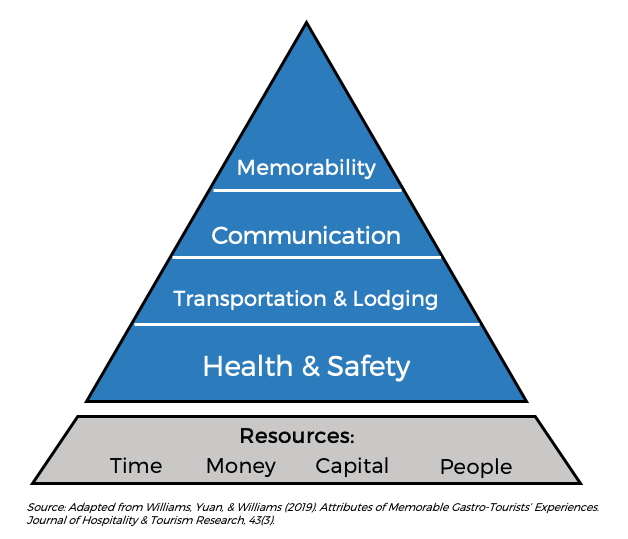
Everyone has a role to play
Developing and promoting food tourism is often regarded as responsibilities of tourism boards. As we have seen throughout this report, however, many kinds of businesses are stakeholders in this space, and therefore should have an active role in it. We will discuss partnerships and collaboration more a bit later, but here we want to focus on one type of stakeholder that is often omitted from the food tourism conversation: hotels.
Through our research and interviews, we have identified two different ways that hotels can get involved in the new era of food tourism: They can bring the community and its cuisine into their properties, or they can facilitate opportunities for their guests to have food tourism experiences in the communities they’re part of.
One way hotels approach the first method is to focus on creating the type of experiences that food tourists desire in the food and beverage offerings at their properties. Michael Ellis of Jumeirah Group thinks that hotels are increasingly becoming food tourism destinations in their own right: “The line between independently owned and run restaurants and restaurants in hotels is more and more blurred. … people want to be able to not just stay in a hotel, but they also want to have great F&B [food and beverage] offerings … You now have restaurants in hotels that are attracting locals and you see this all over the world.”
In addition to focusing their food and beverage offerings in this manner, hotels can also bring unique and local food experiences into their properties in other ways, like offering cooking classes for guests or retail opportunities for local food manufacturers.
Local partnerships are key
For all types of food tourism stakeholders, local partnerships and collaboration are key. Partnerships are key from two different perspectives. Organizations like DMOs, RTOs, and consultancies or associations that focus on developing food tourism have the ability to foster collaboration among local stakeholders that might not otherwise do so themselves. Joanne Wolnik of Ontario’s Southwest explained how her team does this: “Our region is big, geographically, so people three hours away generally don’t know each other, but if they’re doing the same thing or they’re doing similar things, or we know that they could partner to accomplish things together, we always love putting them together and making that introduction.”
Trevor Jonas Benson and his team at the Culinary Tourism Alliance also emphasize the importance of collaborating with the local stakeholders in their client destinations: “The development of the work itself, of the projects, is a collaborative process,” he stressed, “It’s got to be the people who are going to be ultimately benefiting from it and producing those outcomes that have got to be involved in the process from start to finish.”
From another perspective, we have tour operators, booking platforms, and travel agencies that essentially take tourists into many different locations for food tourism experiences. Local partnerships are also essential for these types of companies, even though they may take more work to establish. We already mentioned how Cookly, the cooking class platform, has partnered with the Tourism Authority of Thailand in order to gain access and form further relationships within the country’s more remote regions.
Focus on what makes you and your destination unique
For food tourism operators and businesses, it’s important to focus on what makes the experience unique, as well as what makes the cuisine of the destination unique. When developing food tourism products, Joanne Wolnik recommends considering “how are you making sure that your itinerary is truly an experience and not just a tour, how are you taking it one step further?” She explained, “The idea behind that is that we know that in tourism, your competition is whoever is doing the same thing as you but closer to the traveler’s home. So by being completely different, we open ourselves up to a totally different market.”
Imbriani echoed this when we talked to him about how a food tourism company like Sapore Travel can continue to stand out in the market as it becomes more crowded over time. “I think the biggest thing is offering experiences that are a little bit differentiated from the rest of the market. Less focus on these just kind of generic cooking classes and restaurant reservations, and more focus on meeting with producers, and things like that. The biggest thing is being able to offer a unique product.”
Erik Wolf, CEO of the World Food Travel Association emphasized the importance of focusing on what makes an area’s cuisine unique in order to attract food tourists: “We also see entrepreneurs, and their destination marketing offices implicitly endorsing, giving tourists everything they could possibly want rather than focus on an area’s specialty.” He gave the example of tourists in Barcelona who look for an opportunity to eat paella “which is actually a dish originating in the province of Valencia, three hours south. They leave seemingly satisfied after having found paella, but it may only be a shadow of what an authentic paella experience would be.” When food businesses focus on their destination’s true, unique specialities, it encourages exploration into less commonly visited places, like Valencia rather than Barcelona.
- Case Study: Communicating Unique Cuisine Through Marketing Focusing on what makes a region’s cuisine unique is crucial. Making sure that potential food tourists are aware of this is just as important. One way to do this is through marketing and branding messages. Time Out Market, for example, is opening a location in Brooklyn this spring. Didier Souillat, CEO, explained how one of the main marketing messages that will be used to attract tourists and locals to the location is “New York on a plate.” The idea that this message gets across — that a visitor can literally get a taste of a whole city with one experience — is powerful and attractive.
- Visit Sweden has recently launched a food tourism experience that follows this same idea (plus many others that we have discussed in the report). The experience is called The Edible Country . Created and hosted by four Michelin Star Swedish chefs, the experience takes participants into the wilderness in seven distinct regions of the country where they prepare a nine course meal made from things they catch and forage from nature around them. In addition to incorporating the hands-on, educational, and local aspects that we’ve discussed throughout this report, the way it is marketed and branded communicate Sweden as a destination that can be meaningfully experienced through this food-based activity.
Figure out what “authentic” means for you
As we discussed earlier in the report, food tourism isn’t just one thing, and a big part of this has to do with the many meanings of “authentic” across and within destinations. Because of this, it’s important for food tourism stakeholders to figure out what “authentic” means to them. What part of the region’s cuisine should you focus on? How can you take advantage of locally produced food and drinks? This is something that Time Out Market is approaching smartly in its upcoming Brooklyn location. This location will be the only Time Out Market location of those slated to open in the coming years to feature a Kosher vendor. According to Didier Souillat, “We’re about being local, so you can’t be more local than that.”
Nurture existing food resources to become parts of food tourism
This is one things that stakeholders can do to help develop the food tourism space in their destinations to positively benefit the community. Stakeholders of all kinds can examine what already exists in a region: local restaurants, producers, manufacturers, and even food-passionate individuals who aren’t currently making money this way. They can then come up with ways to nurture these resources to help them have a more active role in the space.
Helena Williams explained how restaurants can do this. By adding a chef’s table, a periodic cooking class, or more specifically, something like “a fish restaurant that will let you go to the dock early in the morning and show you how they select their fish, and then you select the fish and come back later for dinner, and that chef has prepared that fish that you selected.” The restaurant itself may already be a culinary attraction, but “Those are the kinds of things that could easily be added to an existing wonderful experience,” making it more memorable and encouraging travel specifically for the experience itself.
Stakeholders can also help food-passionate individuals enter food tourism, which will benefit them and also their communities. Williams also provided an example of how this could transpire: Maybe there’s a woman in a community who makes the best dumplings, from her kitchen or another unofficial space, but her food wouldn’t necessarily be available to tourists. In a case like this, other stakeholders can help connect her with a network that can help provide support to expand her passion into a business within the food tourism space in her community. Whether it’s the tourism board helping to promote her as a food business or a hotel bringing her to teach cooking classes or sell her dumplings, she can become a part of food tourism with the support of other stakeholders for the benefit of everyone.
Peer-to-peer platforms like Eatwith can also help everyday people who are passionate about their food and cultures play a role in food tourism. Rumani of Eatwith explained that when it comes to the platform’s hosts, “Most of them, I would say 98% of them are amateurs, like me. I do host sometimes as well, and it’s like people who love to cook, are super proud of their culture and story, family story.”
- Case Study: Ontario’s Southwest The maple syrup experience case study from Ontario’s Southwest that we shared earlier in the report is not the only one from the region worthy of discussing. Another example shared with us by Joanne Wolnik is an experience called Tree to Table: A Canadian Conversation. This experience is a great illustration of this best practice category because it shows how even a region’s non-food-specific resources can be nurtured to play a role in food tourism.
- This experience is hosted by a charcuterie board maker in Oxford County in Ontario, which is considered the dairy capital of Canada. Four at a time, participants come to his property, where he shows them how he sustainably sources wood from the indigenous forest for his craft. Participants then design their own board with his artist wife, and then he teaches them how to make their own board in his workshop. Throughout the experience, participants get to try locally foraged teas and some other local recipes made from regional products. Following the boardmaking portion, the group enjoys an outdoor feast that Wolnik describes as being “filled with local jams … local cheeses from different artisan cheesemakers, meat from sustainable meat producers. So everything you’re eating is local. Even the chives and pansies that are in the butter, local breads made from locally milled grains.”
- By hosting this experience, this artisan is able to expand his business and customer base while also sharing his region’s culture and history. Participants get to learn a new skill, understand the region through its food specialities, and bring home a souvenir they made themselves.
Food tourism should be collaborative, not competitive
We have already talked about how important local partnerships are for stakeholders interested playing a role in food tourism. That best practice especially focused on how organizations of different kinds can come together toward the common goal. Now, we turn our attention to how collaboration between stakeholders more generally can make a region a real destination for food tourism. If our focus on every stakeholder having a role to play hasn’t made it clear, food tourism should be collaborative, not competitive, even for similar types of businesses in a region.
Helena and Robert Williams have supported this statement through their research. In an article published in the 2018 Journal of Gastronomy and Tourism authored with Jingxue (Jessica) Yuan, they present results from surveys of food tourists. From the results of the surveys, they present what they call the 6+ Gastro-Cluster Destination Development Model. This model proposes that if at least six food tourism attractions in a two hour radius co-market themselves under a single brand image, it increases the likelihood that food tourists will consider the area worthy of a trip: The study concludes that “to attract serious, overnight, self-identified gastro-tourists, which results in sustainable economic development, 6+ clusters are needed.”
- Case Study: Food tourism trails Food tourism trails (or culinary trails, or beverage trails) are an example of how this “cluster” idea can play out in real life. We talked specifically about beverage trails in our 2016 report, where we mentioned the examples of the Denver Beer Trail, the Austrian Schnapps Trail, the Columbus Coffee Trail, and the Santa Fe Margarita Trail. Trails like this are made up of food or beverage businesses that fall within a specific culinary category all within fairly close proximity to one another.Joanne Wolnik explained that the culinary trails in Ontario’s Southwest show “the critical mass of operators, experiences, and offers that are there for people to do. It’s just a more cohesive message than to go out and say ‘We’ve got 35 wineries’ or ‘We’ve got two distilleries, 20 breweries, and 18 wineries.’ We just try to package it up so it’s more exciting.” She explained how trails in the region, like the Oxford County Cheese Trail , act as attractants for tourists to visit the area and support it in other ways: “They have to be doing more than that [just eating cheese] the entire time they’re there. We know that the Cheese Trail is the reason they came, but while they’re there, they’re also doing A, B, and C, and benefiting the local community in those ways as well.”
Think beyond tourists
Hopefully, the importance of thinking beyond tourists is obvious at this point. Food tourism requires input and collaboration from all kinds of stakeholders, who can all play a part and benefit from it. Even when developing food tourism experiences, the focus shouldn’t only be on tourists. In most destinations, tourism ebbs and flows, so tourists are not always going to be a steady stream of customers for food and drink businesses and experiences. Locals and domestic travelers need to be considered as well.
When Skift Research asked Didier Souillat of Time Out Market whether he and his team focus more on tourists or locals as its target audience, he responded, “It can’t be only one. Tourists won’t go to places where locals are not because they think it’s too touristy for me. The locals won’t go if there’s too many tourists.” Even with the Lisbon Market, where 70% of visitors are tourists, he says most of the advertising is directed at the local community.
Cater to specific niches
Once the infrastructure is in place to support food tourism and food tourism experiences have been developed that follow the guidelines we’ve presented in this report, stakeholders can start thinking about catering to specific niches of food tourists. This could include niches of dietary restrictions/preferences, like vegetarians or vegans, or special interest groups. In November 2018, Skift reported on vegetarian and vegan tours being the “next wave of food tourism,” as the major tour operator Intrepid Travel plans to launch fully vegan tours in Italy, India, and Thailand this year. In destinations like these, vegan cuisine is already common, so creating products with this segment in mind can still maintain regional authenticity while also being a key selling point for these specific groups.
Endnotes and Further Reading
- BeverageDaily.com, “Brewers Association: Microbreweries and taprooms are ‘clearly the growth engine of craft,” May 2018.
- Bisnow, “U.S. Food Hall Market Expected To Triple By 2020,” April 2018.
- Booking.com, “Going Local is the essential ingredient for an unforgettable foodie adventure,” June 2018.
- Business Wire, “Move Over Foodies … Make Room for the Food Connected,” October 2018.
- FoodNavigator-USA.com, “Soup-To-Nuts Podcast: ‘Food connected consumers’ could have broader reach than ‘foodies,’” October 2018.
- New York Times, Eating and Drinking Your Way Through A Trip, and Learning Something in the Process, May 2018.
- Scottish Tourism Alliance, “New plan to increase food and drink tourism,” 2018.
- Skift, “Chefs as Destination Ambassadors Appeal to Travelers’ Foodie Obsessions,” January 2018.
- Skift, “Vegans Find New Options as Part of Next Wave of Food Tourism,” November 2018.
- Skift Table, “The Next Generation of Food Hall Design,” December 2018.
- TripAdvisor, “2018 Travel Trends Report: Experiences, Tours & Activities,” 2018.
- TripAdvisor, “Top 25 Experiences — World,” 2018.
- UNWTO, Second Global Report on Gastronomy Tourism, 2017.
- World Food Travel Association
- Frontiers in Nutrition
- Nutrition and Sustainable Diets
- Research Topics
Food Tourism: Culture, Technology, and Sustainability
Total Downloads
Total Views and Downloads
About this Research Topic
Food and eco-tourism: Culture, Technology, and Sustainability Food is important in people’s daily lives and touristic experiences while traveling to different destinations, and tourism is a key sector for generating revenue and employment. With the development of new technologies and advances in food ...
Keywords : Food technology, Food tourism, Heritage, local food, Sustainability food, Plant-based food, alternative Food, Food waste, Algorithmic management, circular economy
Important Note : All contributions to this Research Topic must be within the scope of the section and journal to which they are submitted, as defined in their mission statements. Frontiers reserves the right to guide an out-of-scope manuscript to a more suitable section or journal at any stage of peer review.
Topic Editors
Topic coordinators, recent articles, submission deadlines.
Submission closed.
Participating Journals
Total views.
- Demographics
No records found
total views article views downloads topic views
Top countries
Top referring sites, about frontiers research topics.
With their unique mixes of varied contributions from Original Research to Review Articles, Research Topics unify the most influential researchers, the latest key findings and historical advances in a hot research area! Find out more on how to host your own Frontiers Research Topic or contribute to one as an author.
Features, drivers, and outcomes of food tourism
British Food Journal
ISSN : 0007-070X
Article publication date: 14 January 2022
Issue publication date: 14 January 2022
Mariani, M. and Okumus, B. (2022), "Features, drivers, and outcomes of food tourism", British Food Journal , Vol. 124 No. 2, pp. 401-405. https://doi.org/10.1108/BFJ-02-2022-022
Emerald Publishing Limited
Copyright © 2021, Emerald Publishing Limited
Introduction
Food is increasingly becoming a central aspect in staging memorable experiences within the tourism and hospitality sector ( Kunasegaran et al. , 2019 ; de Albuquerque Meneguel et al. , 2019 ; Cetin et al ., 2019 ), and it is a major motivation for traveling ( Okumus et al. , 2021 ; Chang et al. , 2020 ). Food is therefore important for at least three different sets of reasons. First, it can be a major pull factor to a tourism destination ( Su et al. , 2020 ) and the major travel motivation as travelers might be attracted by a specific cuisine ( Robinson et al. , 2018 ) whose authenticity could depends critically on the place where the food is produced ( Kim et al. , 2019 ) and those producing it. Accordingly, the cultural, religious and psychological drivers and motivations of food tourism consumption have been only partially covered by extant literature (e.g. Lai et al. , 2019 ; Yeap et al. , 2019 ) and need to be investigated in more depth by means of empirical studies leveraging both small and big data about travelers and tourists ( Mariani et al. , 2018 ; Mariani and Baggio, 2021 ). Second, while food is certainly about gastronomic products, it is also about processes and about innovation of gastronomic products and processes that rests on knowledge, craftsmanship and traditions ( de Albuquerque Meneguel et al. , 2019 ). New cooking techniques, science of cooking and molecular gastronomy gradually inspire daily cooking activities and haute cuisine techniques attract more adventure travelers globally. Increasingly food has been included in tourism services and experiences in an ubiquitous way ( McKercher et al. , 2008 ) and in light of the most recent technological advancements in services ( Mariani and Borghi, 2019 ). As such, it is critical to understand what features of food products and production processes are functional for tourism firms to create or co-create with tourists compelling tourism experiences. Third, food tourism is gradually more important for tourism destinations to enhance their competitiveness, economic performance, attractiveness, and for their place/destination marketing ( Okumus et al. , 2007 ) and branding ( Lai et al. , 2018 ) strategies. As such, the mechanisms that allow food tourism to make a difference in terms of competitiveness and appeal need further investigation as well as factors pertaining to sustainability ( Everett and Slocum, 2013 ). Overall, this Special Issue aimed at shedding more light on the characteristics, drivers and outcomes of food tourism. We particularly welcomed empirical studies addressing a variety of topics in food tourism and adopting qualitative, quantitative and mixed methods.
Hopefully, this will be a well-cited issue as food tourism is increasingly covered by major travel, tourism and hospitality journals. This topic is currently covered in a very fragmented way as food tourism research is relatively novel and only around 300 journal articles have been published on the topic scattered across many disciplines. However, what is missing is a collection of cutting hedge research shedding light on the features, drivers and outcomes of food tourism to build an overarching framework around the phenomenon. In this Special Issue, the contributing authors explore the Features, Drivers and Outcomes of Food Tourism and explain how food tourism can help destinations as well as tourism, hospitality and foodservice industries to overcome a number of challenges.
An overview on papers in this special issue
This special issue contains eleven scientific articles that cover a broad range of issues, topics and initiatives in Food Tourism including sustainability, creativity, food tourism experiences, local cuisines, diaspora marketing, food festivals, street food consumption, online marketing and health hazards. These articles have adopted various methodological approches using different methods such as customer surveys, manager surveys, experimental designs, text mining, content analysis, case studies and some innovative statistical analytic techniques. We are happy to provide this rich and varied collection to scholars and peers in our field.
In the article titled “ Motivations, self-congruity and restaurant innovativeness as antecedents of a creative-food tourism experience: the moderating effect of first-time and repeat tourists ” Gomez-Rico et al. (2022) analyzed the drivers of a creative food tourism experience (CFTE) and its effect on the tourists' perceived authenticity and satisfaction. Data were obtained about 407 food tourists who traveled to visit a creative restaurant, and subsequently analyzed using structural equation modeling (PLS-SEM). Results confirm the relevance of emotional and social motivations to enjoy a CFTE and the need to align the target tourists' self-concept and restaurant positioning. Restaurant innovativeness was found to be the most vital driver of CFTE, which suggests that entrepreneurship in gastronomy is critical to boosting food tourism.
The article titled “ Not just food: Exploring the influence of food blog engagement on intention to taste and to visit” by Mainolfi et al . (2022) examined the effect of several factors such as perceived enjoyment, blogger credibility and homophily on readers' engagement with food blogs, as well as the influence of blog engagement on intentions to follow blogger's recommendations. Based on an online survey with a sample of 821 blog readers (Italian and American), the authors proposed and tested a model deploying structural equation modeling. They found that perceived enjoyment and homophily significantly impact on blog engagement, which, in turn, positively influences both intention to taste and visit. Furthermore, blogger credibility does not influence blog engagement.
In the article titled “ Addressing sustainable food management in hotels: proposing a framework and examining hotel groups ” Ruiz Molina et al. (2022) investigated sustainable food management in hotels, taking into account the various facets of the food supply chain. For this purpose, several dimensions were proposed for dealing with sustainable food management, involving all aspects of food supply chains that may be relevant for hotel decision-making. Results confirmed that the quality and the quantity of the information provided by hotels are limited and that hotel managers and users neglect a number of aspects of sustainable food management identified in the framework.
The article titled “ Searching memories of pleasures in local cuisine: how nostalgia and hedonic values affect tourists' behavior at hot spring destinations?” by Lin et al . (2022) developed a causal relationship model of nostalgia, hedonic values and tourists' intentions for local cuisine in historic hot springs. For data analysis, the authors used the purposive sampling model and surveyed three hundred and fifteen Taiwanese tourists visiting the Beitou Hot Spring, Taiwan. Covariance-based structural equation modeling was used to find that higher levels of tourists' perceived nostalgia are associated with stronger perceived hedonic values based on dining experiences. Tourists' perceived hedonic values mediate the relationships between nostalgia and tourists' intentions for local cuisine.
In the article titled “ Food tourism: opportunities for SMEs through diaspora marketing? ” Bowen (2022) investigated the impact of the diaspora effect on food tourism. The author used mixed methods to develop a deeper understanding of diaspora effects on food tourism using online survey of 169 food producers, with 37 follow-up interviews in Wales and Brittany. Results confirmed that two avenues for diaspora tourism are available, either through engaging with diaspora networks, such as expatriate networks located outside the country of origin, or through the reverse diaspora effect, of visitors experiencing products and then seeking to purchase them once returned to their countries.
The article titled “ Profiling food festivals by type, name and descriptive content: a population level study ” by Kesgin et al . (2022) classified and described food festivals and examined the patterns in food festival naming and festival descriptions in online media. The study represents the first population-level empirical examination of food festivals in the United States using a purpose-built dataset ( N = 2,626) and builds on text mining techniques to examine food festival communications. Findings identified the festival forms, styles, functions and their diversity serving as a foundation for future scholarly work.
In the article titled “ Application of the extended theory of planned behavior to street-food consumption: testing the effect of food neophobia among Indian consumers, ” Nagar et al. (2022) examined how food neophobia, perceived risk and word of mouth about street food vendors affect tourists' attitude and intention to consume street food. The authors collected data collected from 445 tourists from the Indian urban center of Jammu and analyzed them by leveraging structural equation modeling (SEM). The study found that word of mouth about street food vendors positively and significantly influenced tourists' attitudes and intention to consume street food, while food neophobia led to negative attitude and intention to consume street food.
The article by Bigi et al. (2022) titled “ Who killed food tourism? Unaware cannibalism in online conversations about traveling in Italy ” addressed the online representation gap of destinations, focusing on Italy, for which official destination promotion materials, tourist guides and web influencers indicate food and wine as crucial drivers to attract visitors. For this purpose, content analysis based on a Bayesian machine-learning technique utilizing Leximancer software was applied to analyze questions and answers posted on TripAdvisor forums by potential and past visitors of four destinations in Italy (Naples, Florence, Parma and Ferrara). Surprisingly the authors found that food-related themes were almost completely absent in the conversations analyzed, suggesting that food-related attributes are diminished compared to less sensorial and memorable aspects of the travel experience.
In the article titled “ Defining risk reduction strategies for tourists with specific food needs: a qualitative approach, ” Moraleda et al . (2022) identified the main risk reduction strategies when individuals suffer from coeliac disease (CD) or non-coeliac gluten sensitivity (NCGS) travel. A qualitative approach based on thematic analysis was adopted. The results of 32 semi-structured interviews confirmed the high level of consensus on the main food risk reducers which can be listed as travel information, staff training in safety assurance, legislation and risk prevention protocols. The findings also suggest that information offered by restaurants, organizations and tourist destinations lack details about risks for the specific segment of tourists analyzed.
The article titled “ Seafood festivals for local development in Italy and Sweden ” by Pizzichini et al. (2022) focused on festivals taking place in coastal regions whose central element is seafood. Qualitative exploratory case studies of seafood festivals in Italy and Sweden were performed using an analytical model and the findings showed the close relationship between seafood and tourism. The authors suggest that, although the aforementioned relationship takes variable forms, food is a fundamental lever for maritime and coastal tourism and local development.
In the article titled “ The impact of COVID-19 on destination visit intention and local food consumption,” Dedeoglu et al. (2022) examined the impact of potential Chinese tourists' local food consumption motivation on their intention to consume local food. Moreover, they also examined the impact of those intentions on their tendency to visit that destination. Data obtained from 264 Chinese respondents for Italian food, and 277 Chinese respondents for Thai food were analyzed utilizing PLS structural equation modeling. The authors found that tourists' risk perceptions of COVID-19 negatively moderate the effect of cultural experience and novelty on the intention to consume Italian food but tourists' risk perceptions on Thai food have a diminishing effect on all motivation factors.
Concluding remarks
This special issue attracted a large number of high-quality submissions from scholars interested in food tourism and hospitality across many countries. This witnesses a growing scholarly “appetite” for food tourism to use a wordplay. The articles in this special issue covered theoretical and practical issues pertaining to food tourism, travelers' food consumption, health concerns of tourists, and organizational design of destinations using food as an attraction. The papers also display a variety of methodological approaches, including qualitative methods leveraging on interviews and case studies, quantitative approaches leveraging surveys, experiments, and content analysis, and mixed method approaches combining surveys and interviews. The papers represent contributions from all over the world including USA, UK, Italy, Spain, Sweden, Taiwan, India, Turkey and China. Together, they show that food is a global resource and central aspect in staging memorable and engaging experiences for travelers during their visits the destinations.
We would like to thank all the authors who responded to the call for papers. Competition for the SI was very high, and therefore the review process was extremely selective. We are particularly grateful to the authors of the papers in the special issue and to the many anonymous reviewers who provided constructive suggestions, valuable time and feedback.
Finally, we do believe that the articles included in this special issue will be well-received by scholars, students, as well as practitioners and managers. More specifically, the studies presented in this special issue emphasized the importance of developing further the scholarly debate on food tourism and food service research across multiple disciplines. We hope that the articles in this special issue will encourage more researchers to join the scholarly debate on the fascinating and innovative research area of food tourism. Last, we believe that several of the practical implications stemming from the studies might support the decision-making of tourism and hospitality managers, entrepreneurs, and marketers to see, seize and exploit the opportunities brought about by food in the tourism and hospitality industries, as well as other related sectors.
Cetin , G. , Okumus , B. and Alrawadieh , Z. ( 2019 ), “ The role of local gastronomy in destination marketing ”, Experiential Consumption and Marketing in Tourism Within a Cross-Cultural Context , p. 195 .
Chang , J. , Okumus , B. , Wang , C.H. and Chiu , C.Y. ( 2020 ), “ Food tourism: cooking holiday experiences in East Asia ”, Tourism Review , Vol. 76 No. 5 , pp. 1067 - 1083 .
de Albuquerque Meneguel , C.R. , Mundet , L. and Aulet , S. ( 2019 ), “ The role of a high-quality restaurant in stimulating the creation and development of gastronomy tourism ”, International Journal of Hospitality Management , Vol. 83 , pp. 220 - 228 .
Everett , S. and Slocum , S.L. ( 2013 ), “ Food and tourism: an effective partnership? A UK-based review ”, Journal of Sustainable Tourism , Vol. 21 No. 6 , pp. 789 - 809 .
Kim , S. , Park , E. and Lamb , D. ( 2019 ), “ Extraordinary or ordinary? Food tourism motivations of Japanese domestic noodle tourists ”, Tourism Management Perspectives , Vol. 29 , pp. 176 - 186 .
Kunasegaran , M. , Rasoolimanesh , S.M. and Khan , S.K. ( 2019 ), “ Experiences of international tourists with healthy signature foods: a case study in Malacca ”, British Food Journal , Vol. 122 No. 6 , pp. 1869 - 1882 .
Lai , M.Y. , Khoo-Lattimore , C. and Wang , Y. ( 2018 ), “ A perception gap investigation into food and cuisine image attributes for destination branding from the host perspective: the case of Australia ”, Tourism Management , Vol. 69 , pp. 579 - 595 .
Lai , M.Y. , Khoo-Lattimore , C. and Wang , Y. ( 2019 ), “ Food and cuisine image in destination branding: toward a conceptual model ”, Tourism and Hospitality Research , Vol. 19 No. 2 , pp. 238 - 251 .
Mariani , M. and Borghi , M. ( 2019 ), “ Industry 4.0: a bibliometric review of its managerial intellectual structure and potential evolution in the service industries ”, Technological Forecasting and Social Change , Vol. 149 , p. 119752 .
Mariani , M. and Baggio , R. ( 2021 ), “ Big data and analytics in hospitality and tourism: a systematic literature review ”, International Journal of Contemporary Hospitality Management . doi: 10.1108/IJCHM-03-2021-0301 .
Mariani , M. , Baggio , R. , Fuchs , M. and Höepken , W. ( 2018 ), “ Business intelligence and big data in hospitality and tourism: a systematic literature review ”, International Journal of Contemporary Hospitality Management , Vol. 30 No. 12 , pp. 3514 - 3554 .
McKercher , B. , Okumus , F. and Okumus , B. ( 2008 ), “ Food tourism as a viable market segment: it's all how you cook the numbers ”, Journal of Travel and Tourism Marketing , Vol. 25 No. 2 , pp. 137 - 148 .
Okumus , B. , Okumus , F. and McKercher , B. ( 2007 ), “ Incorporating local and international cuisines in the marketing of tourism destinations: the cases of Hong Kong and Turkey ”, Tourism Management , Vol. 28 No. 1 , pp. 253 - 261 .
Okumus , B. , Mehraliyev , F. , Ma , F. and Köseoglu , M.A. ( 2021 ), “ Intellectual connections in food tourism literature: a co‐citation approach ”, International Journal of Tourism Research , Vol. 23 No. 2 , pp. 220 - 237 .
Robinson , R.N. , Getz , D. and Dolnicar , S. ( 2018 ), “ Food tourism subsegments: a data‐driven analysis ”, International Journal of Tourism Research , Vol. 20 No. 3 , pp. 367 - 377 .
Su , D.N. , Johnson , L.W. and O'Mahony , B. ( 2020 ), “ Analysis of push and pull factors in food travel motivation ”, Current Issues in Tourism , Vol. 23 No. 5 , pp. 572 - 586 .
Yeap , J.A. , Ong , K.S.G. , Yapp , E.H. and Ooi , S.K. ( 2019 ), “ Hungry for more: understanding young domestic travellers' return for Penang street food ”, British Food Journal , Vol. 122 No. 6 , pp. 1935 - 1952 .
Related articles
We’re listening — tell us what you think, something didn’t work….
Report bugs here
All feedback is valuable
Please share your general feedback
Join us on our journey
Platform update page.
Visit emeraldpublishing.com/platformupdate to discover the latest news and updates
Questions & More Information
Answers to the most commonly asked questions here

What’s New in the World of Food Tourism & Culinary Travel?
“Food tourism is the act of traveling for a taste of place in order to get a sense of place.” ™ World Food Travel Association
Travelling the world to experience different cultures through food is not new, but the opportunities for immersion keep expanding. If you’re a foodie, or a food-focused traveller, here are some exciting things to watch out for in the world of food tourism.
Culinary Destinations
The concept of food tourism and culinary vacations have gained significant momentum, with more travellers seeking destinations renowned for their culinary experiences. Cities and regions are increasingly marketing themselves as food destinations, showcasing their local specialties and culinary traditions to attract tourists.
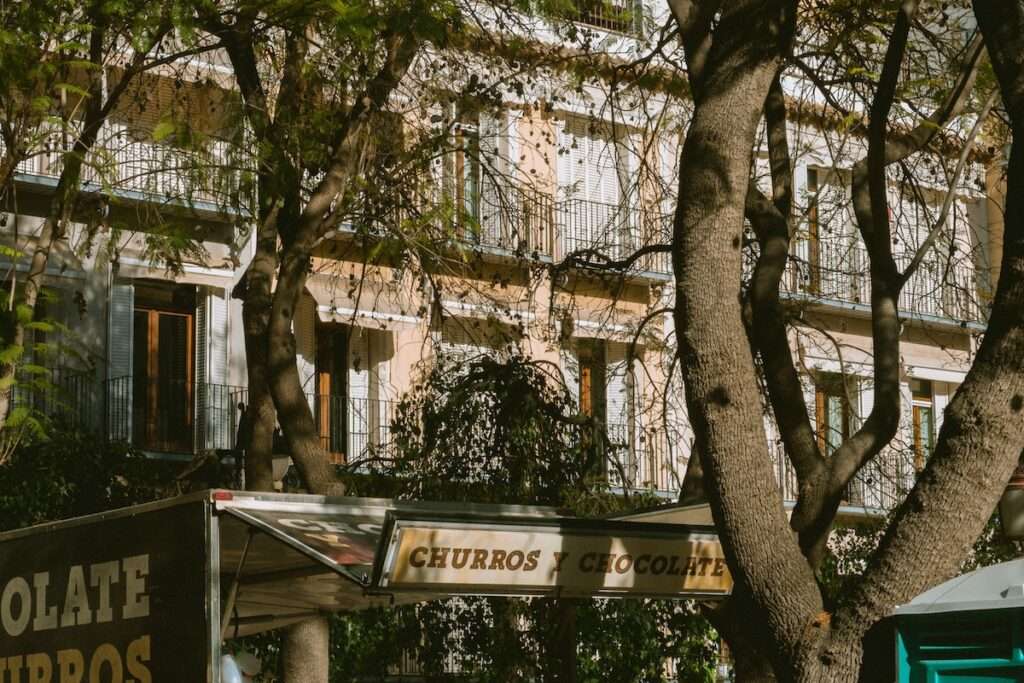
Experiential Dining
Food tourists are seeking more immersive and hands-on experiences, going beyond just tasting the local cuisine. This includes participating in cooking classes, visiting local markets, and engaging in farm-to-table experiences where they can learn about the sourcing and preparation of ingredients.
Fusion Cuisine
Fusion food has become popular among travellers, especially among millennials and Gen Z. They are interested in trying innovative combinations of flavours from different cuisines, resulting in unique and exciting dining experiences.
Sustainable & Ethical Food Practices
With an increased focus on sustainability and ethical food production, food tourists are seeking establishments that prioritize locally sourced, organic, and ethically produced food. There’s a growing interest in supporting businesses that follow environmentally friendly practices .
Technology Integration
Technology is playing an essential role in food tourism. Food-related apps, online reviews, and social media platforms influence travellers’ choices regarding where and what to eat during their trips. Additionally, some tours and experiences are incorporating virtual reality and augmented reality to enhance the dining experience.

Food Tourism Festivals & Events
Food-themed events and festivals have become significant draws for tourists. These gatherings celebrate local food culture and can range from small-scale street food festivals to large international food events, such as:
1. Oktoberfest – Germany : Oktoberfest is one of the world’s largest and most famous beer festivals, held annually in Munich, Germany. The festival usually takes place from late September to the first weekend in October. It celebrates Bavarian culture with an abundance of traditional German beer, food, music, and various attractions.
2. Taste of Chicago – USA: This annual food festival usually takes place in the summer, spanning multiple days. The festival showcases a diverse array of Chicago’s food scene, including famous deep-dish pizza, hot dogs, ethnic cuisine, and desserts.
3. La Tomatina – Spain : La Tomatina is a unique and lively food festival held in the town of Buñol, Spain. It takes place on the last Wednesday of August, during which participants engage in a massive tomato fight. Thousands of people come together to throw ripe tomatoes at each other, creating a vibrant red spectacle.
4. Cherry Blossom Festival – Japan : While not exclusively a food festival, the Cherry Blossom Festival, also known as Hanami, is a significant event in Japan, celebrating the blooming of cherry blossoms in spring. During this time, people gather under cherry blossom trees to have picnics and enjoy various traditional Japanese foods and snacks.
5. Pizzafest – Italy : Also known as Naples Pizza Village (Napoli Pizza Village), Pizzafest is a popular pizza festival in Naples, Italy. Naples is the birthplace of pizza, and this festival celebrates the city’s culinary heritage. The event showcases various types of pizzas from local pizzerias and includes pizza-making competitions, workshops, and entertainment.
These food festivals not only offer a chance to indulge in delicious cuisine but also provide a unique cultural experience and a glimpse into the culinary traditions of the respective regions.
Food and Beverage Pairings
The pairing of food and beverages, such as wine, craft beer, or artisanal spirits, is gaining popularity in food tourism. Travellers are interested in exploring how different beverages complement and enhance the flavours of various dishes.
Street Food
Street food continues to be a major attraction for food tourists, offering affordable and authentic local flavours. Food tours specifically centred around street food are becoming more prevalent in many cities.
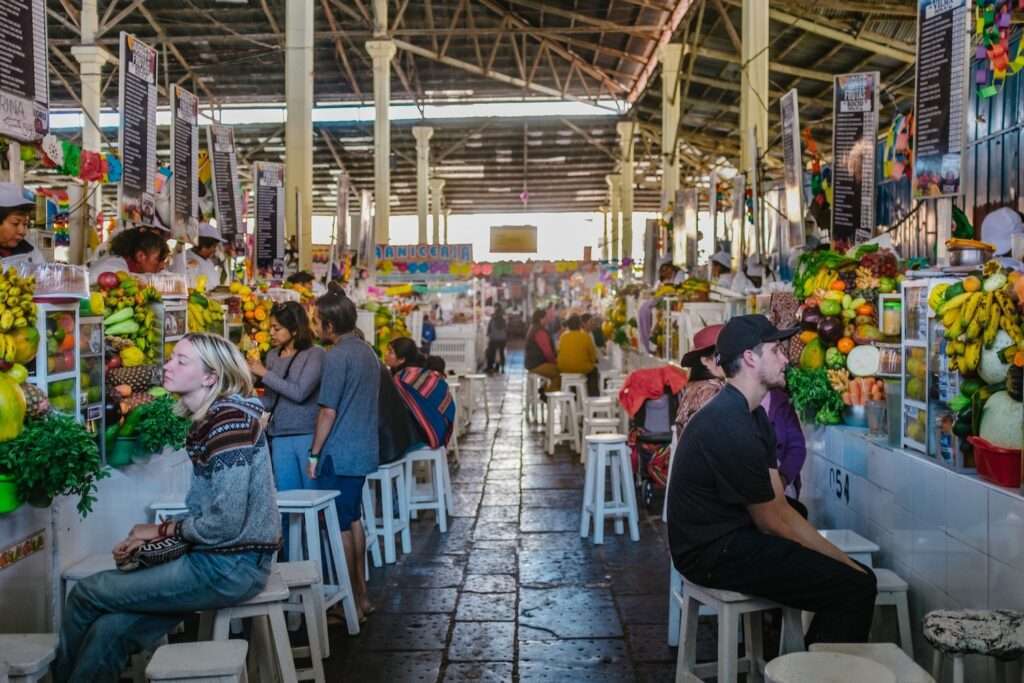
Cultural Exchange Through Food Tourism
Food tourism is viewed as a means of cultural exchange, providing tourists with insight into the traditions and heritage of a destination through its cuisine. This also includes learning about traditional cooking techniques and recipes passed down through generations.
Dietary Preferences and Food Allergies
Food tourism has adapted to cater to different dietary preferences and restrictions, including vegetarian, vegan , gluten-free, and other special diets. Restaurants and food tour operators are offering more inclusive options to meet diverse needs.
Related Posts
7 ways plant based protein can help you reach your..., napa valley: epicurean wonders from vine to table, brewing innovation: the caffeine-free coffee alternative that’s turning heads, 5 over the top dining experiences for 2024, culture & connection through food tourism: my experience at the..., hot trend: open fire culinary experiences from georgia to tulum, privacy overview.

Discover the main types of activities in Food Tourism
With the recovery of tourism, more experiences and activities of food tourism have gained prominence. But what activities are these?
In general, they are experiences that use food as a form of expression and connection with the local culture and biodiversity of a destination.
We have selected the main examples of food tourism activities to help you plan and understand how to make a culinary trip.
Examples of Food Tourism Activities
Food tours (food or beverage tours).
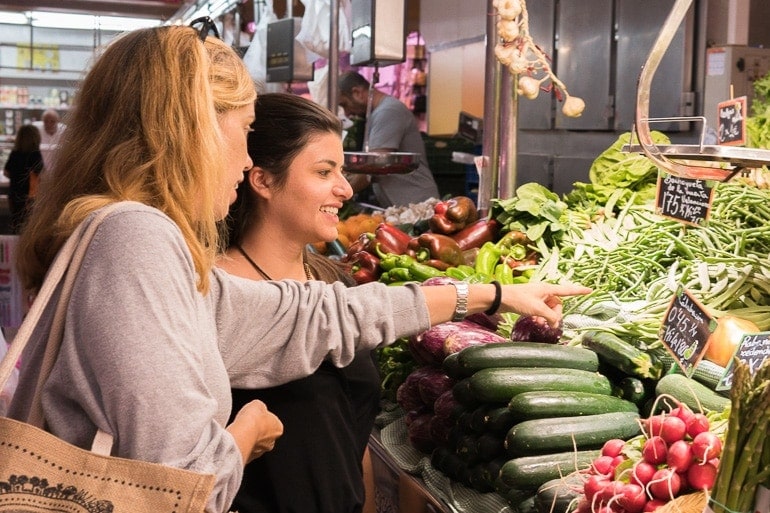
Food tours are guided tours to gastronomic establishments, such as typical restaurants, local markets, street fairs, and specialty stores. Usually, the itineraries are themed and seek to bring an immersion, for example, tours in traditional neighborhoods, tours centered on street food, tours to explore exotic foods, typical drinks, etc.
Taking a food tour is the most delicious way to know a destination. You stroll and learn more about the place, in addition to tasting delicacies and typical dishes in an educational, safe, and relaxed way.
Cooking Classes

A type of activity that has increasingly filled the travel itineraries. If you like to cook, you’ll love taking a cooking class on your next trip. Imagine learning different recipes and techniques from a local chef?
There are several models of cooking classes in tourism: group, private, cooking schools with individual counters, at the residents’ house, with a visit to the market to buy the ingredients, for amateurs, for professionals, and so on. That is, there is no lack of options. The coolest of the cooking classes is that they are quite entertaining in addition to offering practical learning.
Now, for those who cannot travel, but want to learn how to make typical dishes from around the world, know that it is possible to find online cooking classes, an excellent way to travel without leaving your home!
Tasting Sessions

This activity is already very famous in beverages, for example, wine, beer, and spirits tastings. These are sessions where different samples of drinks or foods are presented and savored.
The interesting thing about including Tasting Sessions in your travel itinerary is that you will have the opportunity to be guided by an expert to understand more about the product’s characteristics, the nuances of different production processes, or learn harmonization tips.
We’ve even done black pepper tasting in southern Cambodia – and it was an amazing experience. Today, we value and understand much more about black pepper, which helped develop our taste and knowledge.
Visits to Local Producers

From planting to producing food and drinks, knowing how food reaches your table is essential in anyone’s life. In general, food production is more related to rural areas. Therefore, a good idea is to take advantage of leisure moments to do agritourism . It is possible to visit local producers and enjoy the countryside.
Usually, the producers organize and guide the visit, or it is done through specialized guides and agencies. Examples are visiting productions of honey, cheese, wine, cold meats, fruit plantations, etc.
Travel on Regional Product Routes

Now, if you really want to explore in-depth some authentic food or drink from the region – the best option is to follow product routes at the destination. For example, the route of coffee, wine, cheese, rice fields, etc.
These routes are usually promoted by the tourist offices in conjunction with local establishments – and have great historical and cultural value. You can explore these routes independently or through specialized tours.
Eating at Regional Cuisine Restaurants
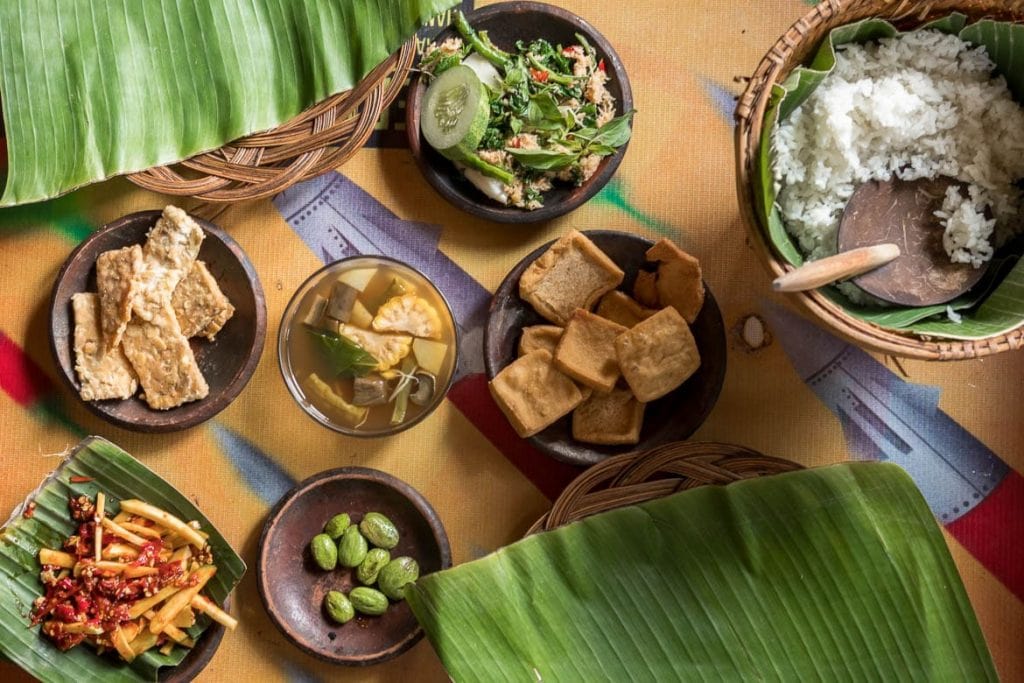
Eating in restaurants that express the culture of a destination through their dishes is also food tourism.
What counts here is the proposal of the restaurant. The list can include traditional and classic restaurants to authentic establishments and popular with the residents. The experience may also include modern restaurants with innovative concepts focused on cultural and biodiversity appreciation.
Food and Cultural Festivals
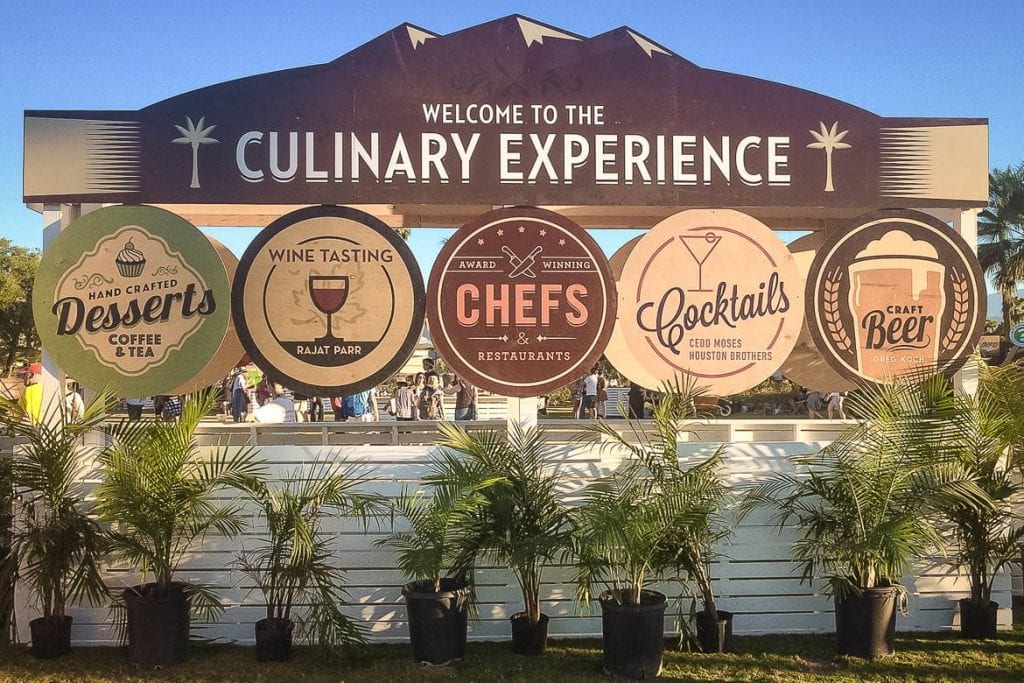
Many cities have a gastronomic event or cultural festival with themed food stalls. Here, cultural festivals that are not necessarily dedicated to gastronomy, but offer a good supply of food and drinks related to the region’s food traditions, are also worthwhile.
The tip to include food festivals in your trip is easy: Pay attention to the festive calendars of the city you intend to visit because where there is a party, there is food (and vice versa!).
Visit Fairs and Local Markets

A classic example of a food tourism activity. Visiting markets and fairs are an excellent way to try ingredients and learn about the region’s biodiversity while interacting with producers and the local community.
Visits can be made independently or guided. As we have already mentioned, many cooking classes start with visits to the local markets. Food tours may also include it in their program.
Workshops that teach Artisan Production

This activity is a little more immersive, with educational programs – short or long – that teach how to prepare traditional products in an artisanal way. Perfect for those who like to reproduce their learnings at home after their trip.
Food tourism for all tastes
These were just a few examples of food tourism activities and experiences you can do while traveling. In general, to do this type of tourism, you just need to be interested in the place’s gastronomy. From there, it is up to you how you want to experience it, whether tasting a typical sweet at the cafe or through a guided tour to the country’s wineries. The best thing is to include several of these activities in your itinerary; after all, food tourism is for everyone.
Want to know more? Check out our tips on how to plan a culinary trip .
- .wp-block-kadence-advancedheading mark{background:transparent;border-style:solid;border-width:0}.wp-block-kadence-advancedheading mark.kt-highlight{color:#f76a0c;}.kb-adv-heading-icon{display: inline-flex;justify-content: center;align-items: center;}.single-content .kadence-advanced-heading-wrapper h1, .single-content .kadence-advanced-heading-wrapper h2, .single-content .kadence-advanced-heading-wrapper h3, .single-content .kadence-advanced-heading-wrapper h4, .single-content .kadence-advanced-heading-wrapper h5, .single-content .kadence-advanced-heading-wrapper h6 {margin: 1.5em 0 .5em;}.single-content .kadence-advanced-heading-wrapper+* { margin-top:0;} .wp-block-kadence-advancedheading.kt-adv-heading_c4edf0-15, .wp-block-kadence-advancedheading.kt-adv-heading_c4edf0-15[data-kb-block="kb-adv-heading_c4edf0-15"]{padding-bottom:0px;margin-top:-20px;margin-bottom:0px;font-size:14px;font-style:normal;}.wp-block-kadence-advancedheading.kt-adv-heading_c4edf0-15 mark, .wp-block-kadence-advancedheading.kt-adv-heading_c4edf0-15[data-kb-block="kb-adv-heading_c4edf0-15"] mark{font-style:normal;color:#f76a0c;padding-top:0px;padding-right:0px;padding-bottom:0px;padding-left:0px;} We promote Food Tourism as a tool for connection and local development. Company Who we are
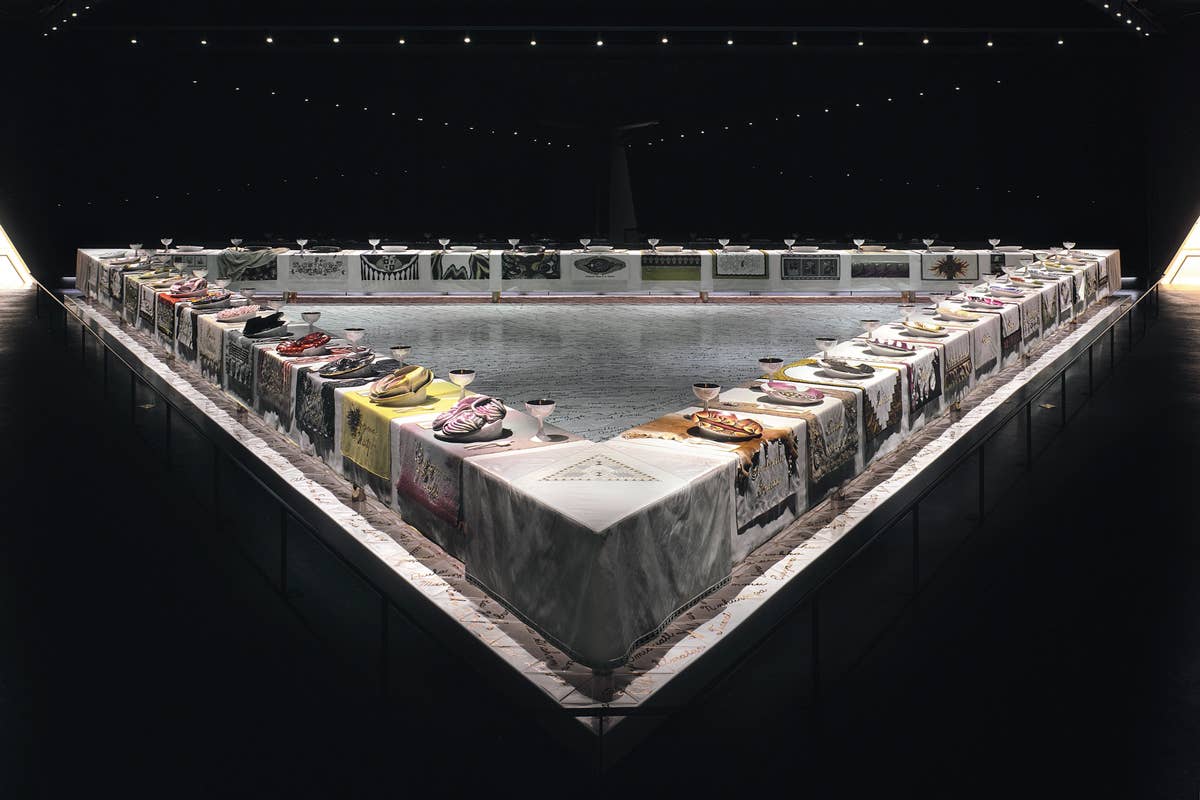
A Different Kind of Food Tourism
Between-meal diversions in Paris, New York, Hong Kong, and more
By Allie Wist
Published on March 5, 2015
Hunting for the best restaurants while traveling is a given, but I also make a point of seeking out little pockets of food-related art and culture when I'm exploring a new place. In fact, some of my favorite food experiences haven't involved me eating at all: One of the most memorable lunches I've had was simply observing young Thai monks eat their midday meal (of which they shared several bites with a monastery cat).
On your next trip, consider searching for food in places other than markets and restaurants—starting with these food-relalted art exhibits and historic destinations.
Pretend You're a Guest at Judy Chicago's Dinner Party
Brooklyn, New York The ultimate feminist dinner party is on permanent display at the Brooklyn Museum. In the mid-70s, American artist Judy Chicago built an enormous table, 48 feet long on each side, to host a figurative dinner party. Instead of serving any food or inviting guests, she dedicated each of the 39 place settings to a powerful female figure in history, and set the table with beautiful ceramic dishes and embroidered tapestries. Although the plates themselves are unquestionably "feminine" (as in, they allude to female anatomy), the concept as a whole turns the traditionally marginalizing concepts of domesticity and food preparation into an empowering occasion.
Brooklyn Museum 200 Eastern Parkway Brooklyn, New York 11238 (718) 638-5000
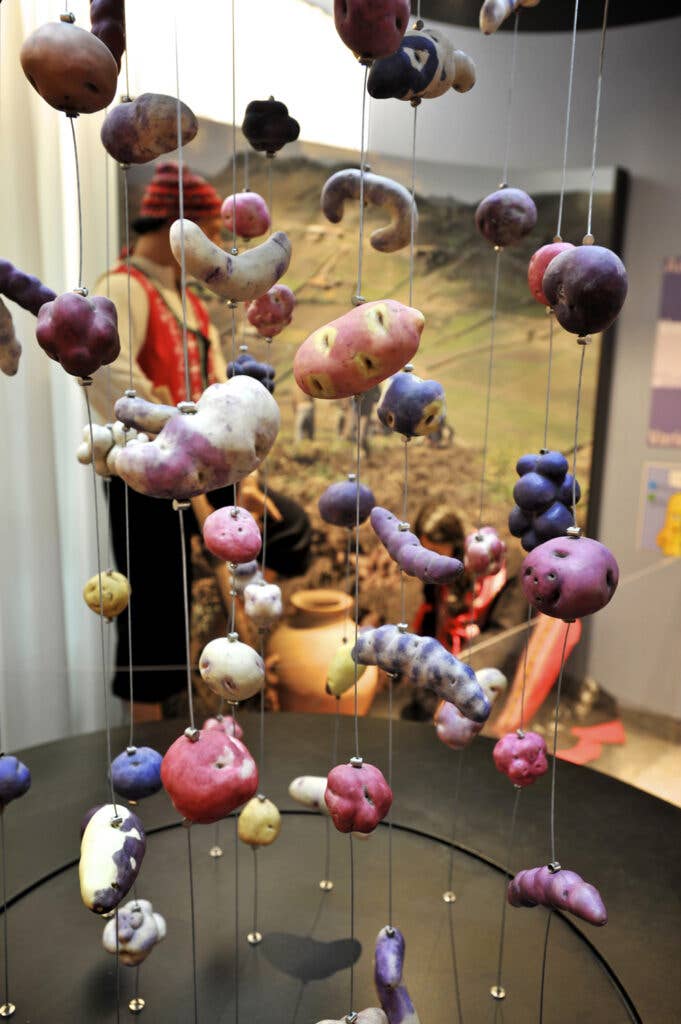
Turn French fries into an Educational Exercise
Bruges, Belgium Yes, this is a museum dedicated to French fries, Belgium's most famous potato invention. The exhibit begins on the ground floor with Peru, the origin of the domesticated potato plant, and a showcase of potato varieties and cutters. Further floors explain the French fry's origin in Belgium and, happily, house a café for tastings.
Frietmuseum Vlamingstraat 33 8000 Bruges, Belgium +32 50 34 01 50
Visit the Quirky Back Room of Poilâne Bakery
Paris, France Everyone knows the legendary Poilâne bakery—it's arguably the most famous traditional bakery in Paris. But what makes the Saint-Germain-des-Prés location in particular worth a visit is a peek into the back room. Hanging on the wall are paintings of bread from dozens of artists, all allegedly donated in exchange for a Poilâne miche. They also have a black and white photograph of an art installation commissioned by Salvador Dali in 1971: Lionel Poilâne created an entire bedroom furniture set out of Poilâne bread for Dali, who was a long admirer of the baker's bread sculptures. To this day, a chandelier made out of bread hangs from the ceiling as a tribute to Poilâne and Dali's friendship. And yes, they replace it when it starts to fall apart.
Poilâne 8 rue du Cherche-Midi Paris, France 75006 +33 (0) 1 45-48-42-59
Step into Julia Child's Kitchen at the Smithsonian Museum of American History
Washington, DC Explore the pots, pans, and adorable plastic-covered Marimekko print tablecloths of Julia Child's Cambridge home kitchen, where she hosted her last three cooking shows. It's not a replica—the Smithsonian actually deconstructed Julia's entire kitchen when she moved to California in 2001 and shipped it to the National Museum of American History. They took everything from potholders to countertops (which the 6-foot-tall chef had custom built at 2 inches higher than most) to preserve her beloved culinary legacy.
Smithsonian Museum 1000 Jefferson Dr., SW Washington, D.C. (202) 633-1000
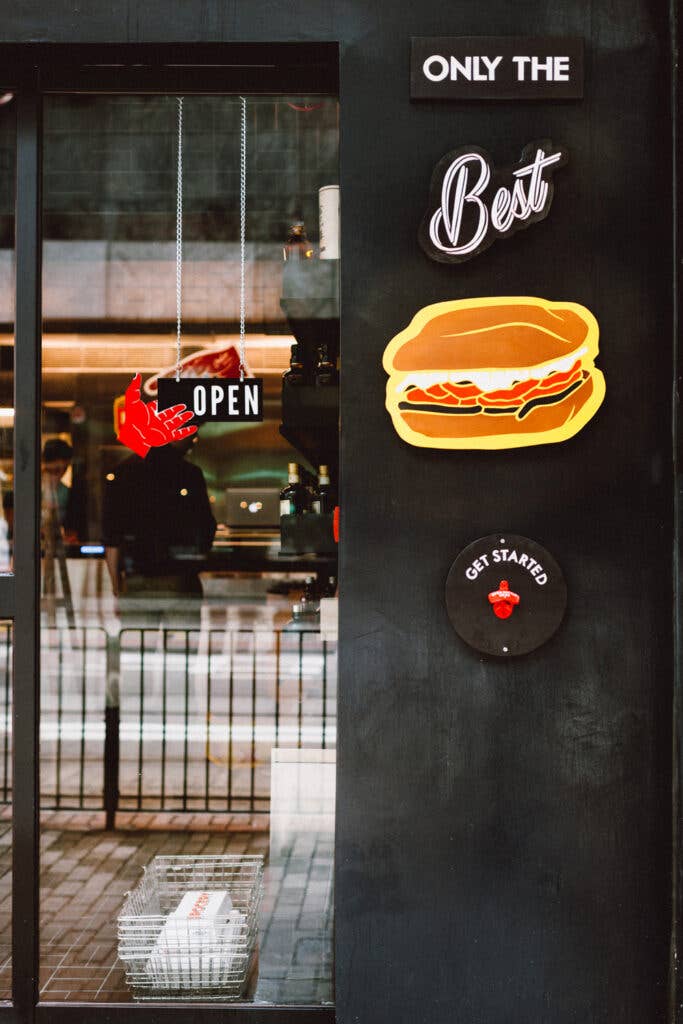
Get Inspired by Design at Sunday's Grocery
Hong Kong For those seeking the best in interior design and environmental typography, take a trip to Sunday's Grocery in Hong Kong's Kennedy Town. Famed for their chicken yakitori joint Yardbird, which is located in Hong Kong's Central district, Canadian duo Matt Abergel and Lindsay Jang opened this venture in the spring of 2014. But here, guests won't be sitting down to chicken skewers and cocktails—or sitting at all. Sunday's Grocery is a "curated convenience store," selling sandwiches, high-end sake, Japanese whiskey, snacks, beer, and specialty packaged foods. The design—from the storefront to the sandwich-and-beer bento-box-style takeout—is beautifully modern and quirky.
Sunday's Grocery 66-68 Catchick Street Kennedy Town, Hong Kong +852 2628 6001
Eat an Imaginary Meal with the Dutch Masters at the Louvre
Paris, France If you're into food history (that is, if you're like me and you find entire books on the global evolution of black pepper fascinating), make sure not to miss the 17th and 18th century Dutch still life paintings the next time you're at the Louvre. From dead geese and game hens to oranges newly imported from the New World to half-bodies of fleshy tuna, the edible evidence found in these still lifes is fascinating. The paintings are both beautiful and a bit haunting, and serve to document how Europeans ate during the 17th and 18th century.
Musée du Louvre 75058 Paris, France +33 (0)1 40 20 53 17
Ogle the Silver Dinnerware of Famous Augsburg Master Silversmiths at Maximillian Museum
Augsburg, Germany Augsburg, a town northwest of Munich, was an important gold-and silver-smith hub of Central Europe up until the 1800s. This museum has a beautiful collection of dining sets, plates, drinking vessels, and servingware—all crafted out of pure silver by the Augsburg silversmith masters. My favorite pieces include gilded drinking cups, specially made for consuming German beer.
Kunstsammlungen und Museen Augsburg Maximilianmuseum Fuggerplatz 1 (Philippine-Welser-Straße 24) D-86150 Augsburg +49 (0) 821 / 324 41 02
See an Enormous Ice Cream Cone Sculpture
**** Cologne, Germany When asked to create a sculpture for the Neumarkt Galerie building in Cologne's Neumarkt Square, artists Claes Oldenburg and Coosje van Bruggen found themselves inspired by the city's landmarks that peek above the glass-paned shopping mall. Cologne boasts 12 Romanesque churches, each with impressive spires that dominate the skyline; in a playful gesture, the artists mimicked these spires with the conical shape of an enormous, inverted plastic ice cream cone.
Neumarkt Galerie Köln Neumarkt 2-4, 50667 Köln, Germany
Keep Reading

We Should All Be Cooking with Fresh Turmeric

Seeds Are the Epitome of Spring’s Unlimited Potential

In Remote Northern India, Weed Isn’t a Trend—It’s a Way of Life

Decades of Travel Inform This Guide to Southern Thai Cooking

Why You Should Heart Artichokes (If You Don’t Already)

13 Excellent Restaurants to Try in Nashville

Where to Stay in London If You Want to Eat Like Royalty

The Origins of Spaghetti all’Assassina, the Pasta That Breaks All the Rules

Cookbooks Have Always Been Political—Whether Readers Knew It or Not

Continue to Next Story
Want more SAVEUR?
Get our favorite recipes, stories, and more delivered to your inbox.

- Write For Us
- December 9, 2019
- Impulsive Wanderlust Admin
- Food & Drink
Food Tourism: Why Food and Tourism Complement Each Other
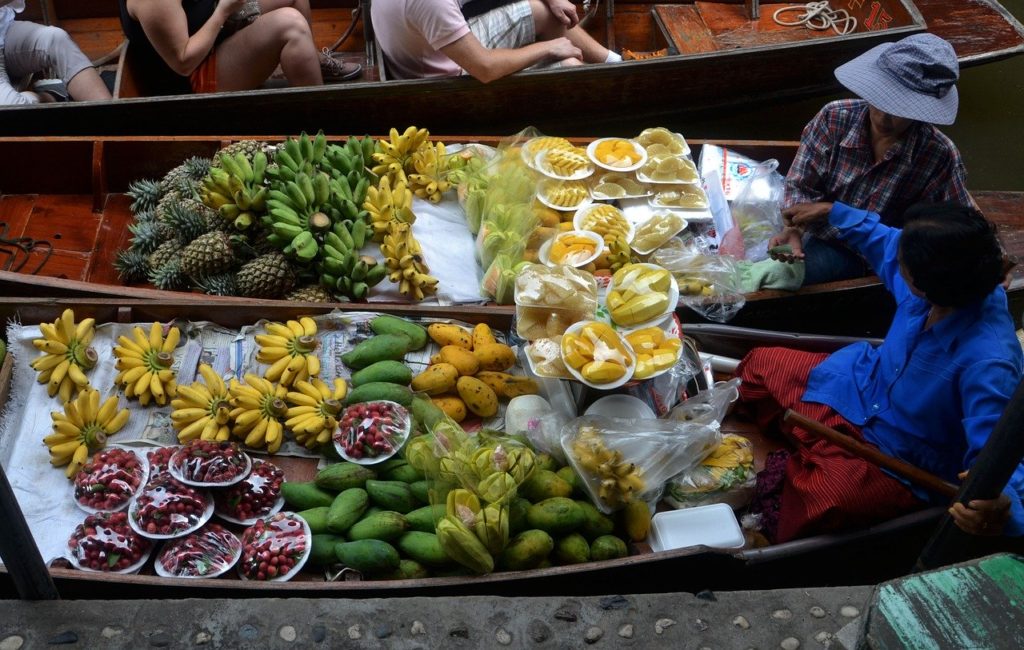
Food tourism has always been a huge part of the travel industry. It plays a significant role in one’s travel experience and is often what people most remember during their trips. Compared to yesteryears, tourists now are better equipped with information. They are more adventurous, cultured, and hungry for new experiences.
Food represents the culture and heritage of a city or country which offers tourists an insight into the lifestyle of the locals. It also transcends age, gender, and nationality. Food is not just a necessity – it’s also a lifestyle.
When it comes to food tourism, cuisine has always been a part of the entire experience. Whether you’re dining out, attending food festivals, joining a cooking class, participating in food tours, there’s always something that connects travelers to food.
What is Food Tourism?
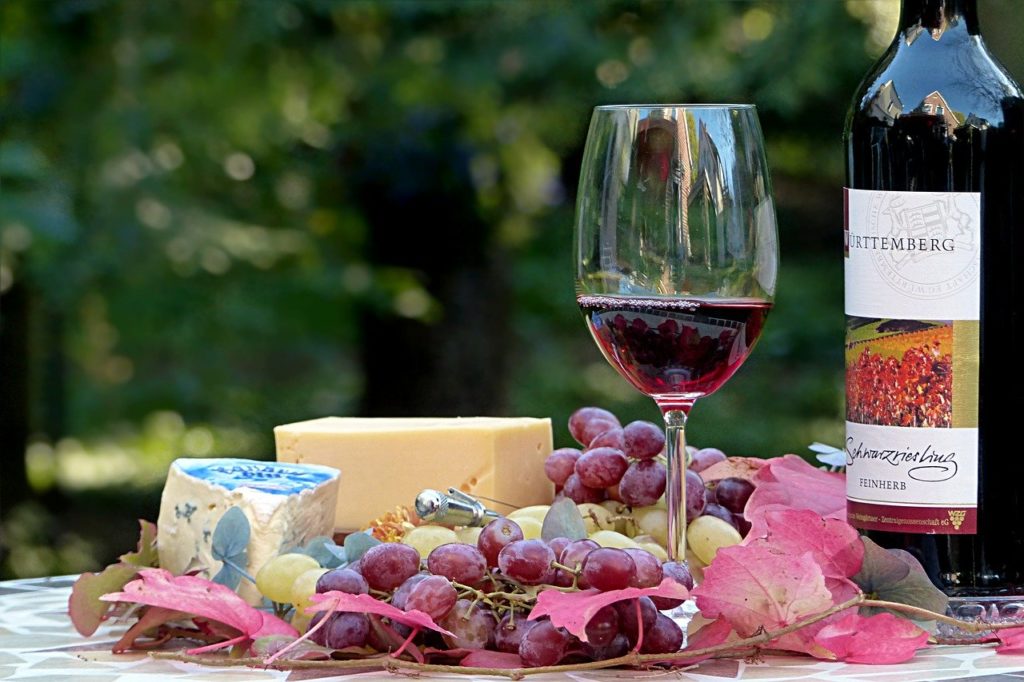
Food tourism is also referred to as culinary tourism. It is described as the discovery of food and is the reason behind your travel. Food is viewed as a huge part of the tourism industry – as well as the tourist’s experience. Tourists consider food as one of the important factors that help them decide where to go and book their flights – in addition to factors like scenery, activities, accommodations, and weather.
Since tourists general eat at least three times daily, food is a significant driving force in the tourism business. There are some cities and countries that are known for their local delicacy and are investing in food tourism to attract more people to visit their city.
The World Food Travel Association defines food tourism as eating and drinking associated with an activity. At the same time, it is not limited to traveling out of town or abroad to eat and drink. You can also explore your own neighborhood, city, and region. This is where the term “food travelers” applies.
Different Types of Food Tourism
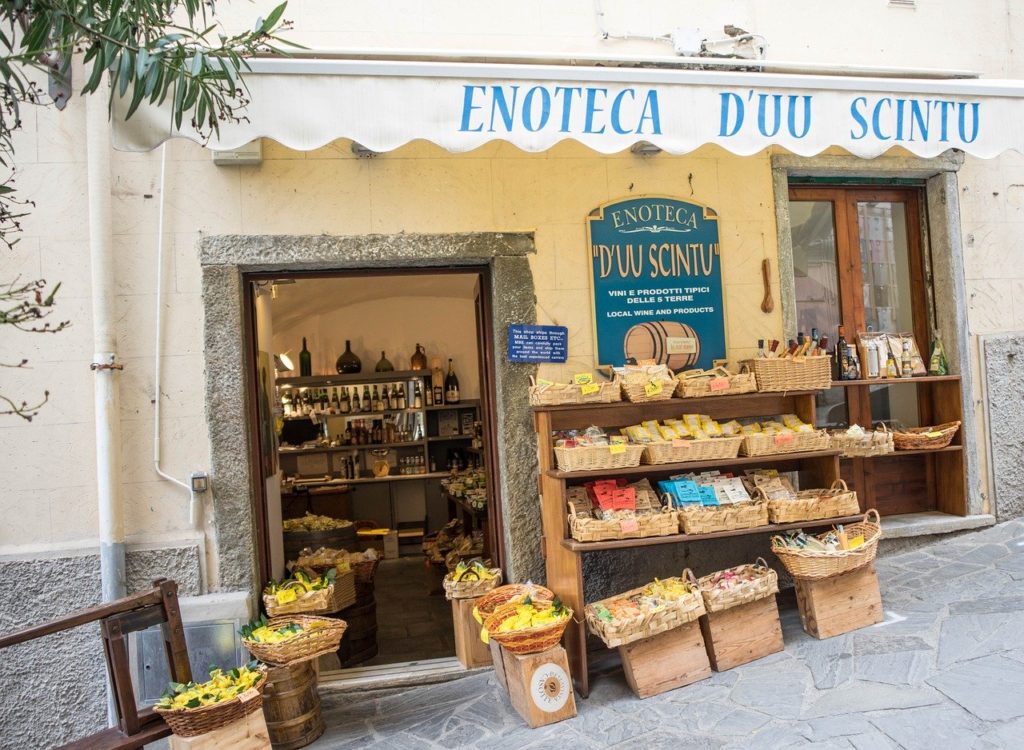
While there are different types of food tourism, the most common activities include the following:
- Cooking Classes – Taking cooking classes is a growing trend in food tourism. This involves taking short lessons that can last a few hours or an entire day. In some cases, culinary schools offer courses that run for a couple of days.
Usually, cooking classes cater to the foreign traveler and offers techniques on how to cook local dishes. Tourists who take cooking classes want to immerse themselves in the local food and culture as well as the lifestyle.
- Food Tours – Food tours are very popular and are the easiest and most convenient way to learn about the culinary arts of the place they are visiting. Most tours are done on foot as the tourists travel in short distances – usually from one restaurant to another. In some cases, food tours are incorporated with bike tours.
Food tours often last from three hours or more depending on how many are on their itinerary. Tourists get to experience the way the locals eat – which isn’t always inside a comfortable, air-conditioned restaurant. Some tours offer street food as part of their itinerary.
The great thing about food tours is that tourists can immerse themselves in the local food culture with the assistance of a guide. The guide can also help recommend the best places to eat in the city.
- Wine, beer and food festivals – Attending food festivals is a fantastic way to discover the local flavor. Some avid festival-goers plan their whole itinerary around a certain festival. Festivals attract a lot of tourists because they get to try different types of dishes all in one place. As a bonus, they get to party with the locals too.
Top Five Food Destinations in the World
Here are some of the best places to travel for food.
1. Tokyo, Japan
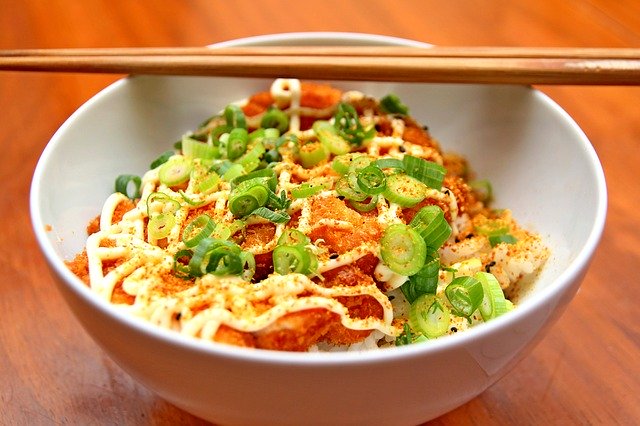
Tokyo offers a variety of dishes that are uniquely their own. From sushi, sashimi, noodles, to okonomiyaki, Japan is bursting with delicious flavors and interesting food combinations. Tourists will find all sorts of local dishes on the street.
2. Paris, France
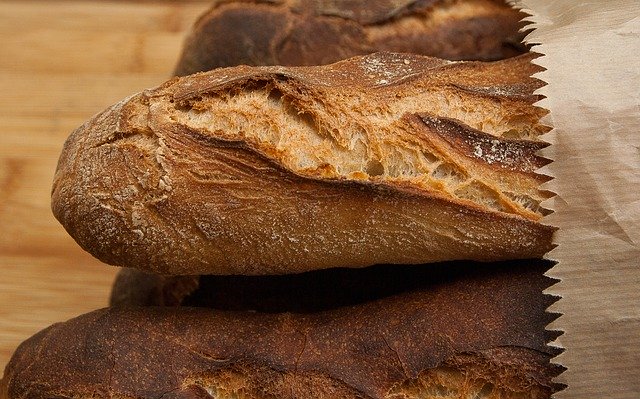
Tourists will find a huge variety of pastries served all day long along the lovely cafes in the streets of Paris . Some of the most popular are macarons, chocolates, and caramels. You can order your favorite bread or pastry along with a hot cup of coffee.
3. Rome, Italy
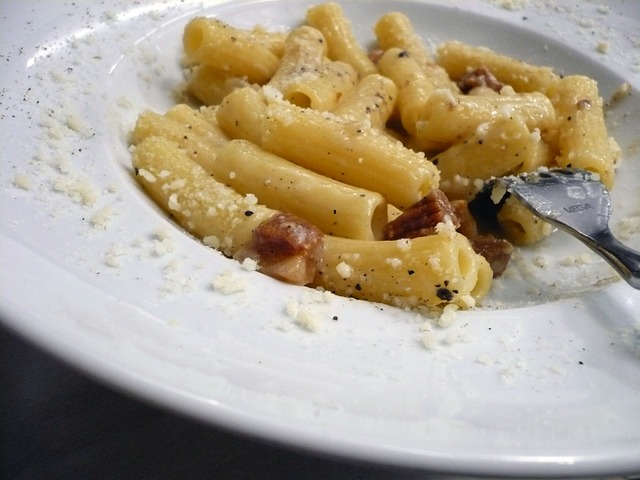
The Italians are known for serving the best pasta in the world. Another popular dish in Italy is pizza. Before you go on a gastronomic adventure in Rome , be prepared to eat tons of mouth-watering carbs.
4. Ho Chih Minh, Vietnam
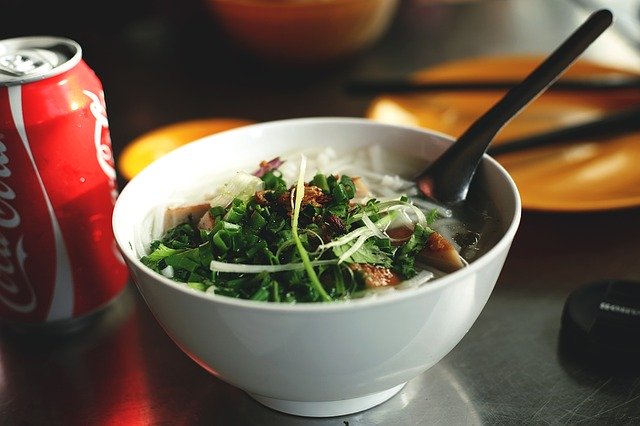
Vietnam food is a combination of Chinese and French influences – but has its own unique flavor. You’ll find that the best places to eat Vietnamese are right beside the street where the locals sit in small chairs and eat Pho (noodles).
There are plenty of food choices when it comes to Vietnamese food.
Aside from noodles, Vietnam is also known for its sandwich – or Banh Mi as the locals call it. To find Vietnamese food nearby , check out the local restaurants in your neighborhood.
5. Bangkok, Thailand
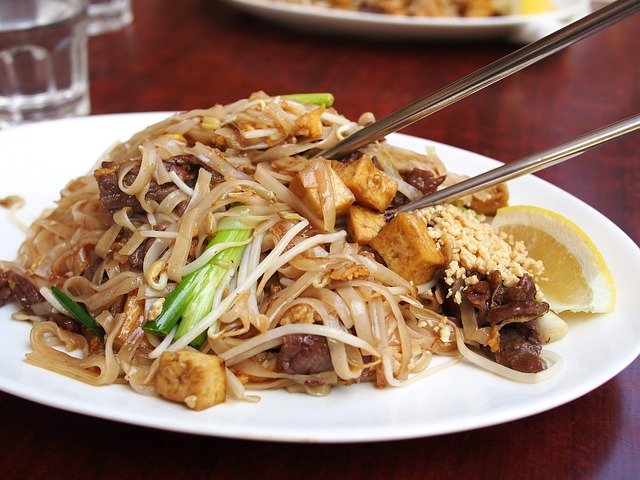
While Bangkok may be best known for its shrines, temples, and elephant tourism , this city has much more to offer. The Thais are known for preparing their signature dish , tom yum, which is also regarded as the country’s national soup. Similar to Vietnam, tourists will also find the best food served in small eateries beside the street.
Food tourism has changed the way people travel. People love to try the local delicacies of other countries. Ease of accessibility for food research has allowed this concept to transform many cities and countries into food destinations.
However, it’s not just about eating. Part of the experience is the adventure of discovering new flavors and trying out new things. Food tourism has also opened up new markets for both tourists and businesses.
If you haven’t gone on a foreign food tour, don’t waste any more time!

Leave Comment
Or cancel reply.
Save my name, email, and website in this browser for the next time I comment.
The 8 Best European Cities to Celebrate New Year’s Eve
6 great amenities every vacation rental should have, recent posts.
- April 8, 2024

- May 4, 2023

- March 12, 2023

- December 4, 2022

- July 31, 2022
Wander-Lush
UNESCO Food Culture: 30 Amazing Culinary Traditions Around the World
Explore the intersection of food and culture with this round-up of culinary traditions around the world. This post unpacks all 30 food-related rituals on UNESCO’s Intangible Cultural Heritage of Humanity list , and offers tips for experiencing them as a traveller.
Most people are familiar with UNESCO World Heritage Sites – but did you know that the United Nations also recognises ‘intangible culture’ as something to celebrate and safeguard?
Cultural elements that lack a physical form but are instead expressed through knowledge, skill or ritual are equally important to shaping living culture.
These include artistic performances, festivals , social practices, oral heritage, craftsmanship, and of course, gastronomic traditions.
Also read: 40 breakfast traditions around the globe .
Food and culture are interwoven. The processes involved in preparing, serving and sharing certain foods and drinks might appear simple, but they often carry important social and cultural significance. Recipes and dietary practices can be used to transmit knowledge from one generation to the next.
Making and eating certain foods as part of a celebration can solidify social bonds. For travellers, getting to know the local food scene and joining in with culinary traditions is one of the best ways to deepen your knowledge and enrich your experience.
As of December 2022, UNESCO recognises 30 food and drink-related traditions as part of its Representative List of the Intangible Cultural Heritage of Humanity .
To inspire you to learn more and maybe even try them for yourself, I asked a group of travel writers to share their insights into food traditions around the world.
Please note: This post contains affiliate links, meaning I may earn a commission if you make a purchase by clicking a link (at no extra cost to you). Learn more.
Exploring the importance of food culture
Have you ever smelled the aroma of something delicious being cooked and instantly felt transported back in time to your childhood home or a favourite vacation? Food is an incredibly evocative force that connects us with our food systems, our heritage, and our cultural traditions.
Food provides more than just nourishment – it explores what we consume, how we prepare it, and the people that we share it with. As such, food culture is also an important part of connecting and relating to people from other backgrounds.
What is food culture?
The definition of food culture can be described as the beliefs, attitudes, and practices related to producing and consuming food .
That may sound a bit dry, but what it means is that food culture lies at the heart of our relationship with our food and the food systems that produce and deliver it to us.
Because food is such an important part of our heritage and ethnicity, traditional foods and recipes play a key role in our food culture. When we sit down with friends and family to enjoy a meal together, we are literally ‘breaking bread’ with them.
On a subconscious level, we’re tapping into centuries of food cultures and traditions.
How does culture impact food?
Food culture around the world is influenced by factors such as the local landscape and weather . For this reason, they can even vary even within a single country.
For instance, the food in northern part of Italy is often enriched with butter made from the milk of local dairy herds, while in the olive-growing south of the country, butter is hardly used and there’s a preference for cooking with olive oil instead.
The history of the country also has an impact on the food culture and traditions of the people living there. Taking the United States as an example, you can easily see how layers of food culture have created the melting pot of cuisines that exists in the USA today.
It starts with the rich history of Indigenous food cultures , then between 1492 and 1800, colonisation brought European ingredients and cooking styles to the Americas. Later on, cultural influences on food from 20th century immigration led to an influx of new cooking styles and foods to choose from.
Food is so much more than just fuel, and sharing food with those we love is part of what makes us human . As the world grows smaller, it’s become easier to enjoy food from different countries, and many cultural traditions have developed around the celebration of food at religious holidays and family gatherings .
And yet another different food culture has developed as more people recognise the importance of slowing down and enjoying seasonal ingredients .
Why is food culture important?
Food culture embraces local and seasonal ingredients , using them to create distinctive recipes and flavours . It involves sharing food with friends, family, and the wider community and has an impact on all of these:
Food and identity
At the individual level, food plays an important role in each person’s own identity. Preparing, sharing, and eating cultural foods is both a physical act and also a symbolic act that links the individual intrinsically with their personal family history.
For many people, eating the food that we enjoyed as a young person transports us back in time to our childhood . It might be the soup that your mother cooked when you were feeling ill or the special dessert you shared on a religious holiday, but food can evoke a bitter-sweet sense of nostalgia alongside warm feelings of comfort and belonging.
This is why food traditions are so important for immigrants as they are an easily transportable piece of the homeland they left behind.
Food and community
People also use food as a way to connect to their community and its cultural practices.
At one point in time, our ancestors would have based their cultural food preferences on the foods available in their locality. Anything unfamiliar could have been dangerous and so would have been viewed with suspicion, while local food was familiar and safe . Of course, we no longer have to worry about that, but cultural foods are still a powerful way of creating social bonds with the people we care about.
When we sit down at the dinner table with our whole family or a group of close friends, it elevates the food that we’re eating, however humble, to something special. Communal eating boosts social bonding and feelings of well-being, helping us to feel part of a community.
In fact, research from the University of Oxford has shown that the more often we share food with others, the more likely we are to feel content and satisfied with our lives .
Food as a way to safeguard traditions
Looking beyond the family and our close community, food is also an important part of ethnic and national culture. Traditional recipes , passed down through the generations, help to preserve the history and habits of the people who cooked them.
Immigrants carry the food customs and recipes of their homeland with them wherever they go, helping them to deal with homesickness and pass their culture on to the generations that follow . The recipes may not always be exactly the same, depending on the availability of ingredients, but immigrant foods remain an important reminder of their shared history, beliefs, and values.
This means that food can also be an important way for us to understand the cultural practices and traditions of people from different backgrounds, whether we enjoy it at home or when we travel abroad .
UNESCO has recognised the importance of food culture and includes several traditional recipes in its list of Intangible Cultural Heritage , such as the ritual preparation and sharing of kimchi in South Korea and the ceremonial keşkek in Turkey.
More recently, UNESCO has added the traditional beetroot soup borscht from Ukraine to the list. This soup has been prepared by families for centuries and, despite shortages of ingredients and the destruction wrought by the war with Russia, Ukrainians continue to unite around the familiar comfort that it brings.
Keep reading to see a complete list of UNESCO Food Traditions.
Food culture and health
Considering the importance of food culture, it’s all too easy to see how food and culture can also become entwined with health issues. Low-cost ready meals and super-sized takeaway food lacks the social and cultural value of traditional foods and this leads us to become detached from the food systems that produce our food .
At the same time, the prevalence of Western diet culture has turned our food into something that has to be weighed and measured, rather than valued and enjoyed. If we stop respecting food and turn it into something to control, we lose the connection that we have with the culture of food.
Without this connection, our mental and physical health can start to suffer. We miss out on the emotional benefits that sharing food with loved ones can bring, and our bodies suffer from the lower nutritional value of highly processed foods.
Luckily, we can all take steps to reconnect with food culture by embracing healthy eating recommendations that go beyond the number of calories or grams of protein.
Taking time to reconnect with food traditions, cooking from scratch more often, taking time to share food with others , and slowing down to really savour the taste of your food are all ways that you can create a strong food culture once again.
30 examples of food culture: Culinary traditions recognised by UNESCO
Here are the 30 food and drink-related traditions currently recognised by UNESCO and its Representative List of the Intangible Cultural Heritage of Humanity.
This list includes five new items inscribed in 2022. As new culinary traditions are recognised each year, they will be added too!
1. Ukrainian Borscht (Inscribed in 2022)
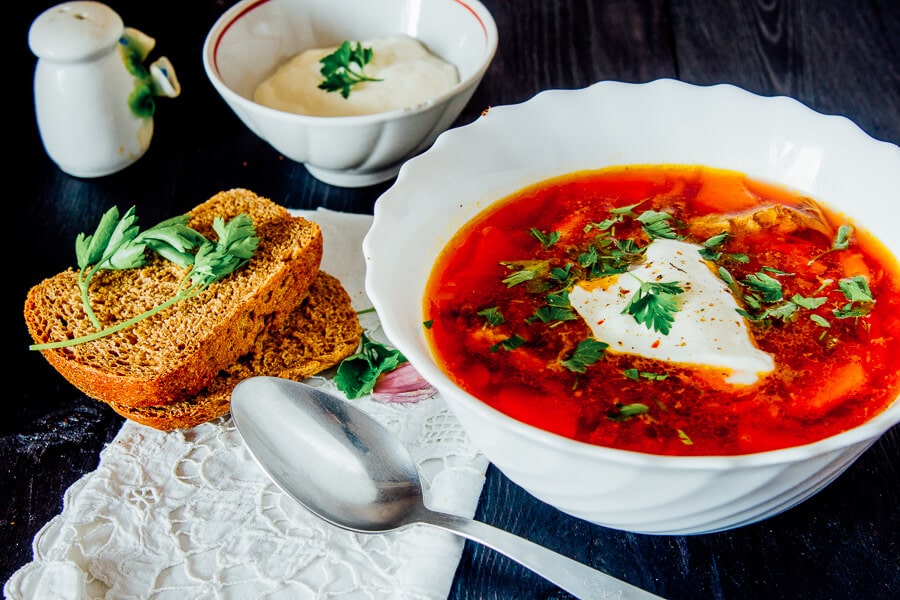
Borscht is a traditional soup eaten in many Eastern European countries, including in Ukraine where it is an important part of culinary identity. The soup owes its vibrant colour and tart flavour to its main ingredient: beetroots.
Borscht is hearty and nourishing. It’s commonly based on a meat stock combined with sauteed vegetables including cabbage, potatoes and tomatoes. Dill, bay leaves, marjoram, horseradish, ginger and even prunes might be used for flavour. Sometimes beef or fish is added for protein, while others prefer to keep the dish vegetarian.
According to some people, a ‘good borscht’ must be thick enough for a spoon to stand upright in the bowl. It can either be served chilled or warm, and always with a big dollop of sour cream on top.
Ukraine is commonly considered the home of borscht. Every region or oblast has its own distinctive recipe – for example in Kyiv, lamb is often added while in Lviv, cooks often use Vienna sausage.
The art of preparing Ukrainian borscht is in urgent need of protection. That’s why in mid-2022, UNESCO gave special consideration and fast-tracked this addition to the list.
Try it for yourself: While we can’t travel to the source right now, the Ukrainian diaspora have ensured that borscht is available in almost every city around the world. Look for a traditional Ukrainian restaurant where you can try this dish.
2. Baguette bread culture in France (Inscribed in 2022)
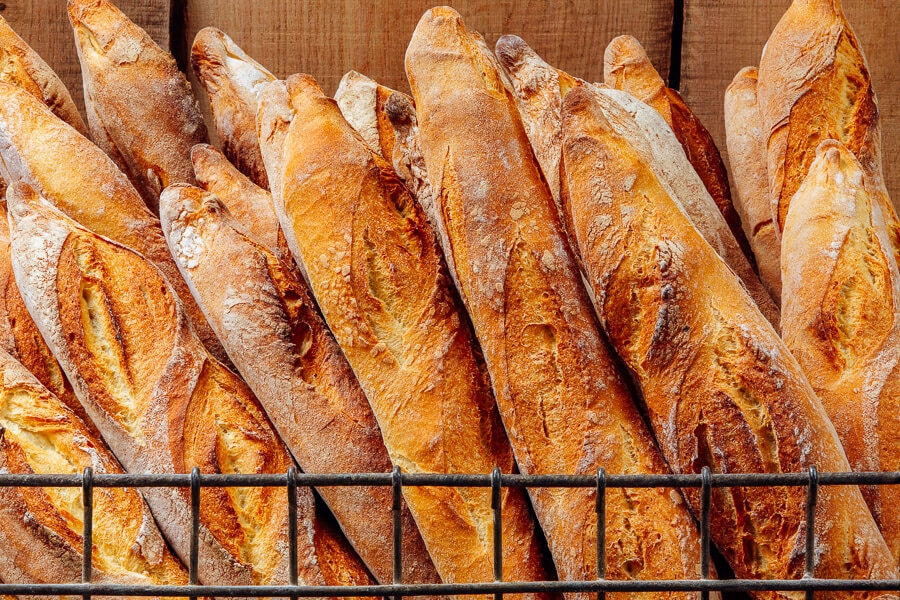
The baguette – a long, thin baton of white bread – is a symbol of France and one of the country’s most beloved food items. It’s a tradition that goes all the way back to the reign of King Louis XIV in the 18th century.
Traditionally, a French baguette (Baguette de Tradition Française) has only four ingredients: wheat flour, water, yeast, and salt. It is baked daily in bakeries or boulangeries and consumed with almost every meal. A ‘good’ baguette is around 65 centimetres in length and has a crunchy crust.
The origins of the baguette are unknown, but there are many myths surrounding it. Did Napoleon Bonaparte invent the baguette so that his soldiers could carry bread around with them in their pockets? Or did they spring from the Bread of Equality decree after the French Revolution as a foodstuff that crossed social lines? You decide!
Try it for yourself: Every city, town and small village in France has specialty bread shops. It’s traditional to rip (not cut) your baguette into pieces before enjoying it with fromage, spreads, or perhaps even French onion soup.
3. Al-Mansaf in Jordan (Inscribed in 2022)
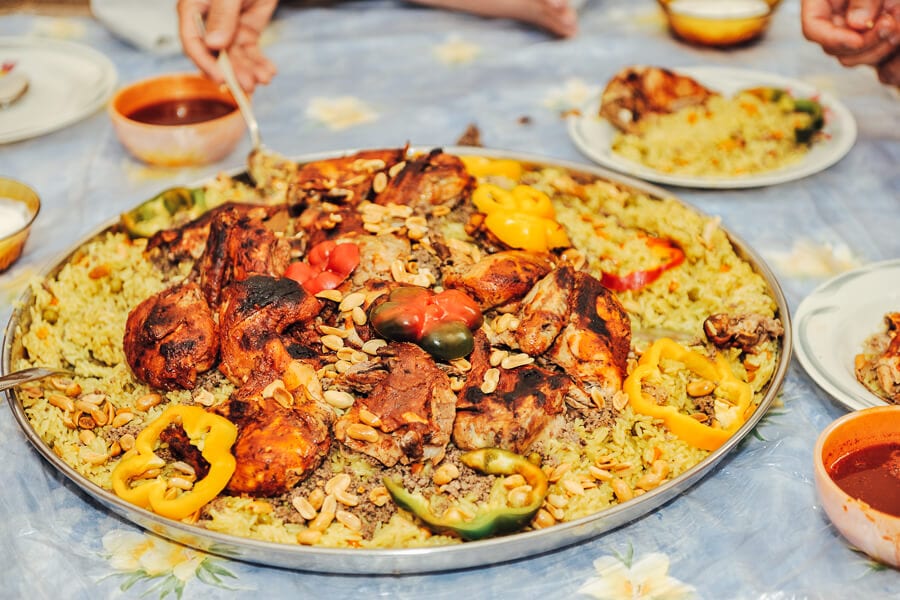
Mansaf or Al-Mansaf is the national dish of Jordan in the Middle East . It consists of lamb or chicken cooked in a rich sauce made from fermented yogurt with white rice or bulgur wheat.
The name of the meal means ‘large tray’, a nod to the way Mansaf is served sharing-style in the centre of the table. Traditionally it is prepared for special occasions including weddings and religious holidays.
Mansaf traces its origins back to Bedouin culture. In the past, the end of inter-tribal conflicts would be marked only once leaders sacrificed an animal to prepare and eat Mansaf together. The dish continues to play an important socio-cultural role in Jordanian society even today.
Try it for yourself: If you’re lucky enough to be invited to share a dish of Mansaf in Jordan, remember the dish is traditionally eaten with one’s right hand instead of utensils.
4. Tea culture in China (Inscribed in 2022)

Tea is a way of life in China, one of the oldest tea-drinking nations on earth. In 2022 UNESCO recognised the critical role tea processing, drinking and sharing plays in Chinese culture when it added this item (China’s first inscription in this category) to its list of Intangible Cultural Heritage.
This entry covers everything from the techniques of picking tea leaves, to the social bonds forged in China’s tea houses. According to UNESCO, there are more than 2,000 different teas produced in China from different categories of leaves and certain flowers and herbs.
In China, tea traverses social and economic borders – it is a drink embraced by all, including many of the country’s ethnic minority groups .
Try it for yourself: Since China is the world’s biggest exporter of tea globally, there’s a good chance you’ve already tried it! When visiting China, a trip to Chengdu to visit the traditional tea houses is a must.
5. Joumou Soup in Haiti
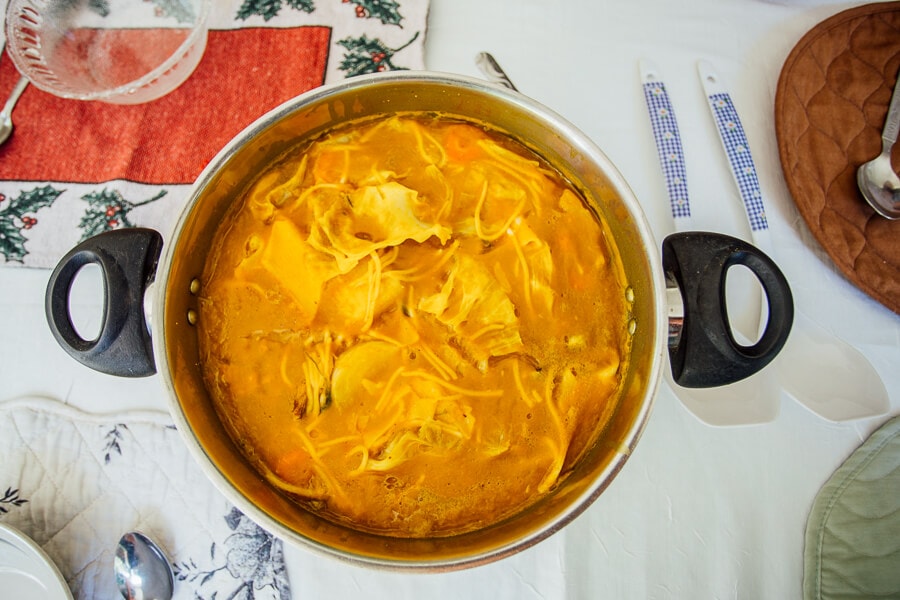
Joumou is a perfect example of the connection between food and culture. In the Caribbean nation of Haiti, this soup is traditionally consumed on January 1 to celebrate the nation’s independence and mark the beginning of a new calendar year. For Haitians, it’s so much more than just a dish: Joumou is a symbol of freedom and liberation.
The history of Joumou goes back to the 17th century when Haiti was colonised by France. This particular soup, made from giraumon , a local pumpkin or squash, was a favourite of the French plantation owners. While they indulged in the tasty, nourishing meal, their slaves were left to survive on scraps alone.
When Haitians rose up against slavery – staging the world’s only successful slave revolt and eventually gaining independence for their nation in 1804 – the soup was coopted by locals who started preparing it for their own families. Haitians previously deprived of eating Joumou reclaimed the recipe for themselves, and the soup came to symbolise the nation’s defiance, resilience, and love of freedom.
Try it for yourself: Today, Joumou is commonly prepared with squash, beef, pasta and various other vegetables. Many people eat it for Sunday brunch. You can find it on every restaurant menu in Port-au-Prince and beyond.
6. Truffle Hunting in Italy

You’ve probably tasted truffles before, but do you know where they come from? Not only are truffles an important ingredient in Italian cuisine, the knowledge and skills involved with hunting for precious ascomycetefungus are an important part of the culture, especially in truffle-producing regions such as Tuscany.
In 2021, UNESCO recognised the importance of Italy’s tartufi truffle-hunting traditions, which are passed down orally through the generations. It includes two processes: Hunting truffles, including being able to identify areas where the fungus grows, and truffle harvesting, which is done with a special spade.
Italian tartufis possess intimate knowledge about climate, ecosystems and biodiversity. Truffle hunting is done in a way that respects the environment and does not deplete natural resources. The culinary tradition also includes feasts held at the beginning and end of each truffle season where special foods are prepared to showcase the delicious flavours of locally grown truffles.
Try it for yourself: Join a truffle-hunting tour from Florence or elsewhere in Tuscany. White truffle season falls between October and December, making this the best time to go.
7. Ceebu Jën in Senegal
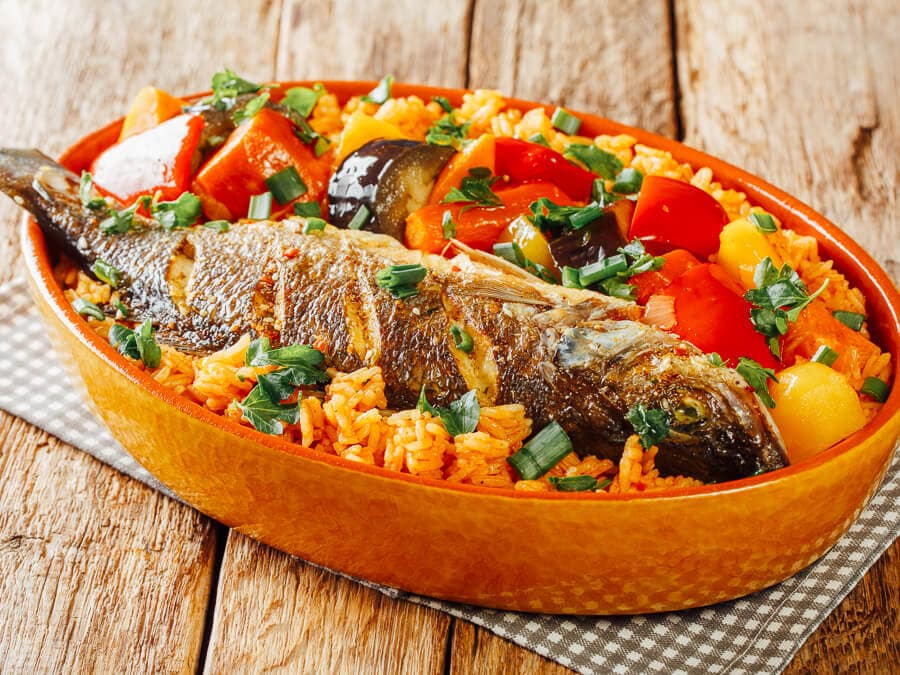
Ceebu jën ( Thieboudienne ) is the national dish of Senegal in West Africa. The recipe originated in fishing villages on Saint-Louis Island and is today eaten across the country and in other nations in the region, including Guinea-Bissau, Mali, Mauritania, and The Gambia.
Ceebu jë recipes are passed down from mother to daughter. Every region and community puts a different spin on the dish, but the essential ingredients include fish, broken rice, tomatoes, onions, and other seasonal vegetables. Higher quality fish and finer vegetables are used for special occasions or when a family is preparing ceebu jë for guests.
At home, the dish is served in one large bowl (a bolus ) and eaten with one’s hands or using a piece of bread to scoop up the rice. Ceebu jë is widely considered to be a symbol of Senegalese terranga (hospitality).
Try it for yourself: If you’re lucky enough to be invited into a Senegalese household to share a bowl of ceebu jë, remember that there are certain customs and etiquettes associated with eating the dish – for example, you must hold the bowl with your left hand and use your right hand for eating. Variations of fish, meat and chicken ceebu jë are widely available at restaurants in Dakar and across the country.
8. Lavash in Armenia
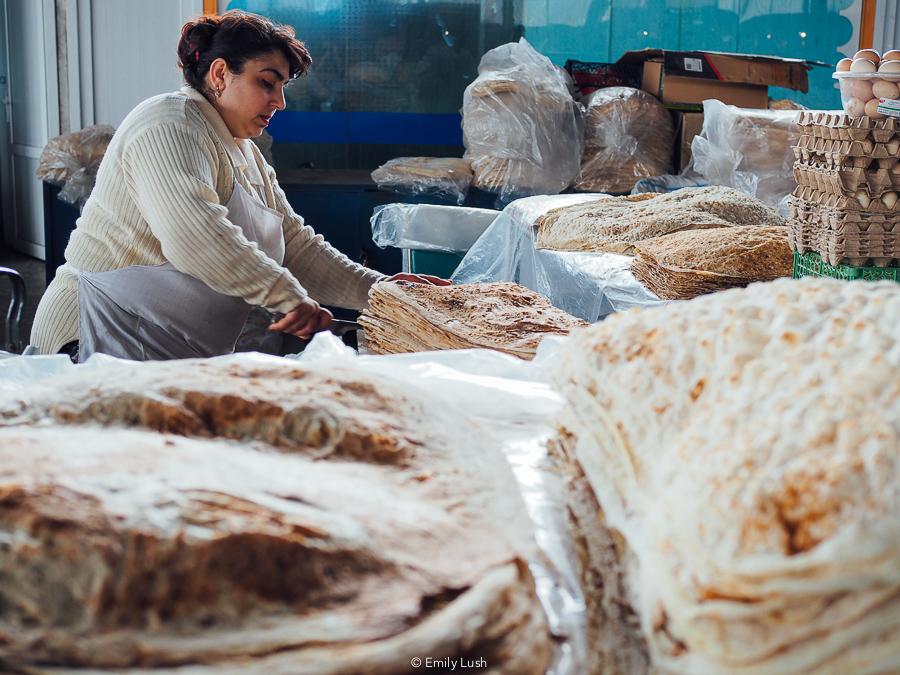
Armenian lavash holds a special place in the country’s food culture and social life. The skill and coordination required to knead and cook lavash, as well as the social exchange that takes place among women when preparing it, prompted UNESCO to inscribe Armenian lavash in 2014.
Lavash dough is a simple mix of wheat flour and water. Once kneaded and rolled, the it’s pulled and stretched over a special cushion that’s stuffed with hay or wool. Still on the cushion, the bread is then transferred to a conical clay oven (called a tonir ) by ‘slapping’ it onto the side.
It only takes between 30 and 60 seconds for the delicate bread to bubble up and cook through. Finished lavash sheets have different colours and textures depending on the type of flour used and the duration of the bake.
Try it for yourself: Lavash plays an important ceremonial role in Armenian weddings, where sheets of the bread are draped over the bride and groom’s shoulders to signal future prosperity. It’s also eaten on a daily basis, often with cheese or meat, and can be found on restaurant menus around the country.
To see how lavash is prepared, head to the GUM Market in Yerevan , where vendors bake fresh sheets every morning.
9. Washoku in Japan

Japanese food is so damn good that it was added to UNESCO’s Representative List of the Intangible Cultural Heritage of Humanity in 2013. It was added as a way to preserve it, as traditional dietary habits are starting to die out across the country, but also because the food is fresh, simple and produced with such incredible attention to detail.
Japanese food is collectively referred to as Washoku . At its essence, it reflects a deep respect for nature, using natural, locally sourced ingredients such as rice, fish, vegetables and edible wild plants.
Every little detail about Japanese food – from the way it’s prepared and presented to the way it’s eaten – stems from a historical cultural tradition that is passed down through the generations.
Washoku is traditionally comprised of four elements: Cooked rice (the staple dish), soups, side dishes that give flavour to the rice, and tsukemono (Japanese pickles).
Try it for yourself: The best way to get a feel for Washoku is to try out traditional Japanese dishes as a local would. For example, try okonomiyaki (Japanese omelette/pizza) in Hiroshima or Osaka, or fresh sushi at the world-famous Toyosu Fish Market in Tokyo (formally the Tsukiji).
By Stefan & Sebastien from Nomadic Boys
10. The Mediterranean Diet in the Mediterranean Region

In 2013, the Mediterranean diet of Spain (and six other countries including Italy, Portugal , Morocco, Croatia , Cyprus, and Greece ) was inscribed on UNESCO’s list of Intangible Cultural Heritage and Humanity.
Though the Mediterranean diet has certainly become something of a fad in many countries, UNESCO has concentrated more on celebrating the rituals and processes that make this diet an important part of Spanish culture.
Some of the strongholds of the Mediterranean diet in Spain include using few ingredients to make flavourful dishes while eliminating food waste as much as possible; eating many small dishes with an emphasis on sharing; and viewing food and diet as a social ritual.
One of the greatest examples of food being used socially would be tapas culture. Throughout Spain, it is incredibly common to go out in the evenings with groups of friends, have a drink and share small plates of food.
Another major factor in this important facet of cultural identity is the role of markets. There are large, central markets in most Spanish cities, each featuring stalls with local vendors selling their family’s specialty.
Many markets in Spain will also include a small cafe-bar where shoppers can enjoy a beverage and a snack while catching up with friends.
Try it for yourself: One of the best places to experience both the tapas and market culture aspects of Spain’s Mediterranean diet would be to spend a couple of days in Seville . The city is famous for its thriving restaurant and bar culture and has many historic, local markets that are very much worth exploring.
By Maggie from The World Was Here First
Other places you can experience the Mediterranean diet:
- Pintxos bars in San Sebastian, Spain
- Trattorias in the Aeolian Islands, Sicily
- Istrian seafood restaurants on the Croatian coast
11. Hawker Food Culture in Singapore
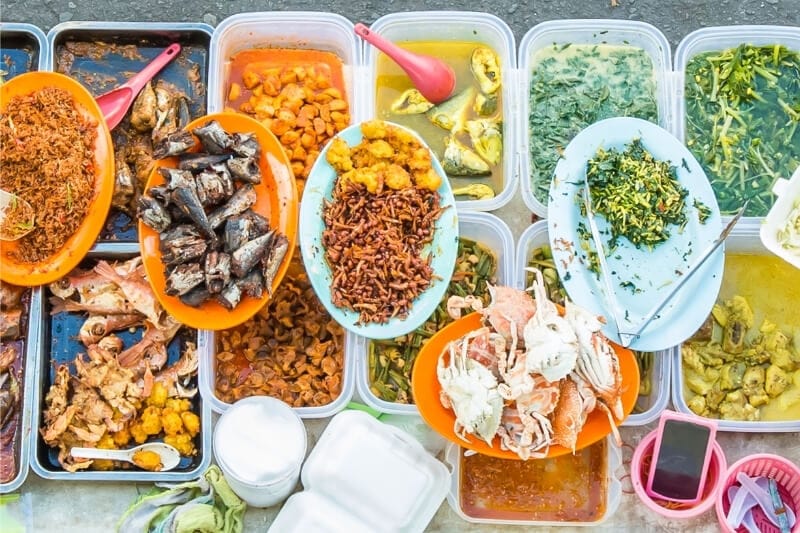
Nothing says Southeast Asia like a bustling food market. In 2020, UNESCO recognised the cultural importance of Singapore’s unique hawker food centres when it added them to the list of Intangible Cultural Heritage.
Singapore is an extremely multicultural nation, and no where is that more obvious than at the city’s hawker markets. These large undercover centres house a range of small restaurants where chefs whip up a menu of diverse meals that showcase Malay, Nyonya, Indian and Chinese flavours. Many cooks specialise in just one or two dishes – over time, they’ve truly refined their craft.
Hawker culture dates back to the 1960s and although the centres have changed over time, becoming more regulated and organised, they’ve been a fixture of Singapore’s culinary landscape for generations.
Apart from being a great place to grab an affordable meal, hawker centres are ‘community dining rooms’ – spaces carved out of the city’s modern urban landscape where people from varied backgrounds come together to socialise. UNESCO recognises these markets as being critical to social cohesion.
Try it for yourself: Singapore’s hawker markets are the place to go for an immersive dining experience. They’re a window onto diverse Singaporean culture and offer an opportunity to try all the country’s specialty dishes under one roof (including famous chilli crab!). Here are the top five hawker centres to visit in Singapore .
12. Couscous in Algeria, Mauritania, Morocco & Tunisia

I don’t know about you, but couscous has always been a bit of a mysterious food item in my mind. I’ve often peered into a bowl of couscous and thought to myself, what exactly is this!? How is it made!? And how are the grains so small!?
In the North African nations of Algeria, Mauritania, Morocco and Tunisia, people understand couscous better than most. The dish originated here, and in 2020, UNESCO recognised not only the dish itself, but also the knowledge associated with how couscous is produced.
Couscous is a cereal, thus the process starts with a seed. The semolina that’s grown and harvested is rolled by hand to form those tiny rounded balls. It’s then steamed and finally cooked.
Each of the four countries listed has a slightly different way of preparing and eating couscous, but one thing they all have in common is the ceremonial nature of the processes involved, which are transmitted down from parents to their children through observation.
There are special tools involved with making couscous too, including clay and wooden instruments that are manufactured by specialised artisans. The final stage in the couscous lifecycle – eating! – is also linked to important social and cultural practices.
Traditionally shared from a large pot between family members and friends, couscous is a symbol for togetherness.
Try it for yourself: It’s hard to avoid couscous when travelling through North Africa – it’s a staple dish on almost every restaurant menu. Tagines are a particularly popular dish containing couscous. For an up-close look at how couscous is prepared, try enrolling in a workshop at a culinary school. Marrakesh is a popular place to take a short cooking class and learn the intricacies of this beautiful dish.
13. Qvevri Wine-making in Georgia
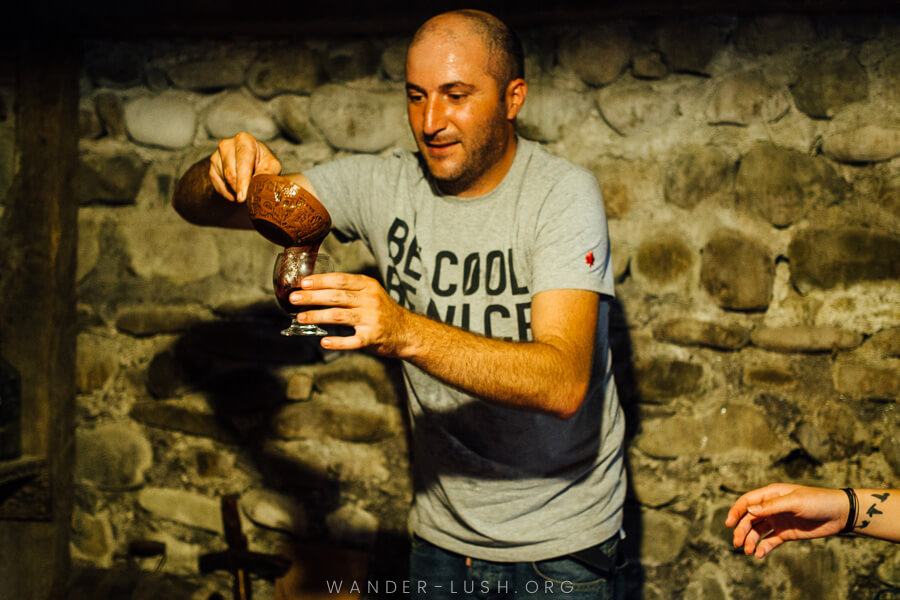
Georgia is synonymous with wine – no surprise seeing as the Caucasus (Georgia, Azerbaijan and Armenia ) are the global birthplace of viniculture. Grapes have been cultivated in Georgia’s fertile Alazani Valley in Kakheti region and beyond for eons (to be more precise, the first evidence of wine-making in Georgia dates back as far as the 6th millennium BC).
In 2013 UNESCO recognised this incredible legacy by inscribing qvevri wine-making methods as part of the country’s Intangible Cultural Heritage.
Incredibly, many Georgian families, monks and nuns, and professional wine-makers alike still use the same methods of preparing wine today as their ancestors did thousands of years ago. Traditional Georgian wine making involves using a qvevri , a huge amphora-shaped clay urn that is buried beneath the ground to maintain a constant temperature.
Following the rtveli wine harvest , which happens annually in autumn , the grapes are fermented inside the qvevri. If the skins are left on, this produces skin-contact wine which Georgia has become famous for. After 5-6 of constant tending with a range of specialty tools, the wine is ready to drink.
Try it for yourself: Every restaurant in Tbilisi and cafe in Kutaisi serves local wine by the glass. Some of the best vinos are homemade. If you get a chance to stay at a guesthouse in Georgia , you’ll no doubt be plied with incredible wine in addition to home cooking! Specialty wine bars in Tbilisi are a great place to sample a variety of different drops, including qvevri and organic wines.
For an immersive wine experience, travel from Tbilisi to Sighnaghi , the heart of Georgia’s wine country. Here, you can find dozens if not hundreds of commercial cellar doors and family run wineries where you can tour the facilities and see ancient-looking qvevri up close before participating in a Georgian wine tasting or degustation.
14. Turkish Coffee in Turkey

Turkey has no fewer than three food-related listings on UNESCO’s Intangible Cultural Heritage list. Turkish coffee is perhaps its best-known and most recognisable.
Coffee was first introduced to the Ottoman Empire in the 15th century. It was an instant hit. From that point on, the Ottomans controlled coffee trading routes and were responsible for spreading coffee throughout the empire.
This explains why countries and territories previously conquered by the Ottomans, including Bosnia and Herzegovina , have their own coffee traditions that are closely related to Turkish coffee.
To make Turkish coffee, roasted beans are ground to a super-fine power and brewed slowly with water and sugar until a foam forms on the top. Turkish coffee pots, or cezve , are integral to the ritual.
Miniature bronze pots for one or larger cezve that hold enough coffee for a large group are presented to the drinker on an intricate coffee tray. Sugar cubes and a square of Turkish delight is usually served on the side.
Brewing and drinking Turkish coffee reflects the country’s communal culture and was recognised by UNESCO in 2013.
Try it for yourself: Traditionally prepared coffee is ubiquitous all over Turkey. The most authentic coffee-drinking experiences can be found at coffee houses (known as kaveh kanes ) in Istanbul and beyond. Turkish coffee is usually sipped slowly as an accompaniment to conversation. Since coffee is a symbol of hospitality and friendship, a Turkish coffee house is the perfect place to meet someone new over a brew.
15. Traditional Mexican Cuisine in Mexico
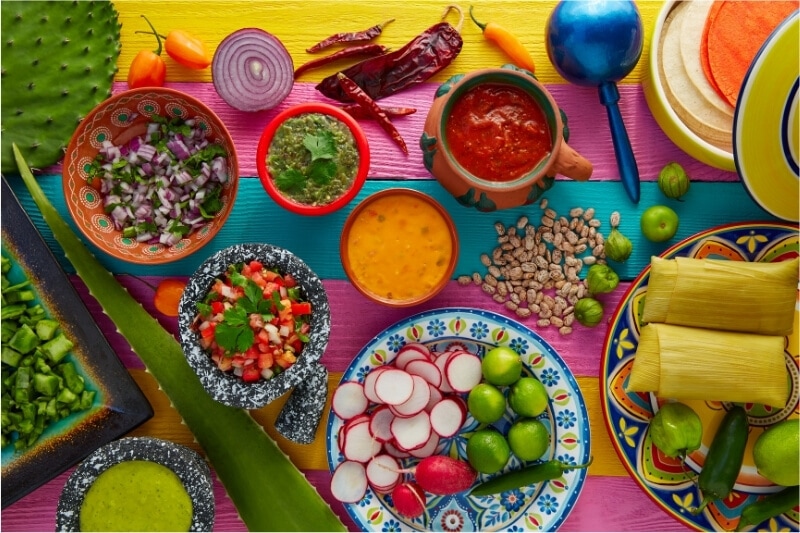
It’s not surprising that Mexican cuisine has attained UNESCO’s Intangible Cultural Heritage of Humanity status. The country is so diverse from state to state and province to province—the result being a full spectrum of flavour, contrasts, and olfactory sensations.
One of the most interesting facts about Mexican food : The development of the national cuisine was driven by the interaction between Spanish conquistadors and Aztec culture.
Most of the Mexican food we eat today is a delicious combination of ancient traditions, Aztec, Mayan and Spanish. The French also played their part in the story of Mexican cuisine, adding baked goods such as sweet breads and the bolillo to the mix.
Contemporary Mexican cuisine is more a mix of modern ingredients from European, North American and even Asian influences. Like anywhere else in the world, it’s hard to replicate true Mexican food outside of Mexico.
Food is one of the main ingredients of Mexican culture . Food is essential to every social gathering – one of the reasons why the food is so great!
Try it for yourself: If you want to taste authentic Mexican food, try chilaquiles for breakfast , tacos for lunch, elote for a street snack, and mole enchiladas for dinner, followed by a Mexican hot chocolate. If you’re brave enough, you should definitely try out the lime chilli fried crickets ( chapulines ). They’re actually quite good!
By Henry & Zory from This Life Of Travel
16. Dolma in Azerbaijan

Dolma is one of the most popular menu items that you’ll find at restaurants in Baku and the rest of Azerbaijan . Delicious dolma is a pre-cooked grape leaf stuffed with minced meat, rice, onion, and sometimes other ingredients such as peas.
The word ‘dolma’ is of Turkic origin and technically is a shortened version of doldurma , which translates to ‘stuffed’. Recipes and methods of dolma-making are passed down from generation to generation.
One of the greatest things about dolma is that the food is used as a way to celebrate guests and mark special occasions. Azerbaijani people are extremely hospitable and love teaching their traditions. Most are welcoming of foreigners to become a part of their society through learning the local traditions and ways of life, including making and eating dolma.
Try it for yourself: There are so many places you can find dolma in Azerbaijan, and the best will almost always be in the homes of Azerbaijani people. You can also find some extremely tasty versions in Baku at the many traditional restaurants in and around the old town and even at on-site restaurants in hotels in Baku .
Head to Shirvanshah Museum Restaurant, the best place I ate dolma in the capital city, or to restaurant Dolma near Fountain Square, where you are sure to find some of the city’s tastiest food.
By Megan from Megan Starr
17. Neapolitan Pizzaiuolo in Italy

Pizza is a classic Italian dish, but did you know that there are many different regional variations? There is Sicilian sfincione and Roman pinsa – and then there’s the version that has gone global, the Neapolitan pizza.
Through the centuries, the art of making Neapolitan pizza has been based on a few key elements – namely water, flour, salt and yeast. Traditionally, raw ingredients are produced in the Campania countryside.
It’s in the hands, heart and soul of the pizzaiuolo (Pizza Chef) that the magic really happens! And that’s why UNESCO has declared the city of Naples ‘ trademark technique of pizza making part of the world’s Intangible Cultural Heritage.
There are three primary categories of pizzaiuolo: The Master Pizzaiuolo, the Pizzaiuolo, and the baker. The knowledge and skills for making pizza is primarily transmitted in the bottega or in homes, where young apprentices observe masters at work.
The art of making a Neapolitan pizza is a culinary practice comprising four different phases: The shaping of dough balls (the so-called staglio ); spreading the dough (called ammaccatura ), where the pizzaiuolo forms the famous raised rim called cornicione with a skilful motion known as schiaffo .
Next, the dough is topped, starting from the centre and spiralling in a clockwise motion. Finally, the pizza is baked in a wood-oven with a rotating movement (‘half turn’).
Try it for yourself: We enjoyed the handiwork of pizzaiuolos during our stay in Sorrento on our Amalfi Coast drive . The best Neapolitan pizza is made from simple and fresh ingredients: A basic dough, raw tomatoes, fresh mozzarella cheese, fresh basil, and olive oil – no fancy toppings here.
More sauce than cheese, it’s quite soggy in the centre but yummy! Pizza is best enjoyed with some house wine and finished with Limoncello, a lemon-infused liquor that’s popular on the Amalfi Coast.
By Priya from Outside Suburbia
18. Nsima in Malawi

Nsima is a thick porridge made by mixing white cornmeal with water. This is an elaborate process that involves pulling the paste against the side of a pot with a wooden spoon as it simmers. Nsima is eaten in many parts of Africa, and goes by different names in other African countries.
In Malawi, it’s normally eaten with two accompaniments: A protein-heavy dish, and a vegetable dish. The protein dish can be meat, fish or beans, while the vegetable dish is usually a type of dark leafy green, such as mustard or pumpkin leaves.
Young children are taught to pound maize and sift flour to make nsima from an early age, and eating communal meals of nsima is an important way of strengthening family bonds. Nsima’s cultural significance in Malawi is why UNESCO has listed it as a form of Intangible Cultural Heritage.
Try it for yourself: Since nsima is the most common staple food in Malawi , it’s available all over the country – though it’s not always served in tourist restaurants. Thomas’s Restaurant, Grocery and Bar in Cape Maclear on Lake Malawi caters to a mix of tourists and locals and serves nsima with beans and salad.
By Wendy from The Nomadic Vegan
19. Flatbread in Iran, Azerbaijan, Central Asia & Turkey

The flatbread has a long history on the Eurasian continent and each region and country has its own variation. The making and sharing culture surrounding flatbread was added to the UNESCO Intangible Cultural Heritage list in 2015.
The humble flatbread is hugely important to Iranian, Azerbaijani, Turkish, Kazhakstani and Kyrgyzstani food culture. Flatbread, including lavash , katyrma , jupka and yufka are typically prepared by households and community members on a daily basis. Besides being eaten as a staple food, flatbread plays an important role in weddings, births, funerals and religious gatherings.
Depending on the region, flatbread is either cooked in a stone or earth-ground oven, on a metal plate, or in a cauldron. Flatbread dough is always prepared from simple ingredients: Wheat flour, water and salt.
Once mixed, flatbread dough is left to rest before it is rolled out and cooked/baked. Some villages still operate an oven for the whole community where each household can bring their bread to be baked.
Try it for yourself: You can watch locals make soft lavash flatbread in the main market in Baku – and since you’re there, how about a freshly prepared lavash kebab wrap. Or you can try to make a Turkish yufka at home using the flat sheets in a savoury layered borek pie.
I love dipping my lavash in narsharab , a sweet and sour sauce made from pomegranate. I suggest you also check out other flatbread from the region, such as Lebanese manakish and Iranian sangak .
By Helene from Masala Herb
20. Il-Ftira in Malta

Il-Ftira is a flattened sourdough bread that’s traditional to the island nation of Malta. It differs from the other flat breads listed by UNESCO and mentioned on this list – it’s more like a loaf with a thick crust and a light, fluffy inside.
The name ftira comes from the Arabic word for unleavened bread and the dish reflects the cultural exchange that has defined Malta’s history. This bread is hand-shaped – the process can’t be replicated by a machine – which makes it all the more special. Regional and seasonal ftira recipes use different ingredients to flavour the bread, such as olives or capers.
In Maltese schools, Ftira Days are held to teach students about healthy eating. A young person who wants to become a ftira baker when they grow up has to go through a long and complex apprentice process first.
Try it for yourself: The smell of fresh-baked ftira wafts through the streets of Valletta and every town and village around the country. Cafes and restaurants often serve it stuffed with fresh salad and tuna – sort of like a loaded bagel – for an affordable on-the-go meal.
21. Ceremonial Keşkek in Turkey

Made with meat or chicken, keşkek is a stew found in Turkish, Iranian and Greek cuisines. The dish is usually associated with a ceremonial or religious occasion and is cooked by groups of men and women together in the community. Keşkek was inscribed on the UNESCO Intangible Cultural Heritage List in 2011 because of its role as a Turkish ceremonial dish.
After the wheat or barley is washed and prayed over the previous day, music from both drums and pipes is played as the grains are poured into a large cauldron. The mix is then beaten with wooden hammers until a fine consistency is achieved.
The dish is cooked outdoors over an open fire and, through the course of the night, the meat and spices are added and left to simmer.
From beating the ingredients to the music performance and the thickening and stirring of the dish, the local community all gather together to take part in keşkek preparation.
Try it for yourself: Keşkek is served at Turkish wedding ceremonies and circumcisions as well as on religious holidays. If you’re lucky enough to chance upon a local village in advance of these celebrations, you will likely see the dish being prepared and have the chance to taste it. Keşkek is also relatively easy to source in traditional restaurants in cities including Istanbul.
By Elaine & David from Show Them The Globe
22. Kimjang in South Korea

Anyone who has ever tried Korean food has also sampled the famous pickled side dish called kimchi .
Basically, kimchi is some type of vegetable – most frequently napa cabbage – that has been fermented in a spicy red paste that may include red chilli powder, garlic, ginger, salt, sugar, fish sauce and green onions.
People tend to have strong opinions about kimchi – they either love it or hate it. But there’s no denying that it’s a required part of any Korean meal.
In November each year, Korean families gather for gimjang ( kimjang ), the traditional process of making kimchi. Historically, it was done after the harvest and was a way to store enough kimchi to sustain a family through the winter season.
The finished product was stored in clay jars, or hangari , that were then buried in the ground. Written records show that kimchi has been around since the 14th century, but the tradition of gimjang was established during the Joseon Dynasty (1392-1897).
Try it for yourself: Participating in gimjang usually requires knowing a Korean family located in South Korea. If that’s not possible, a visit to the Museum Kimchikan in Seoul is a great alternative. This unique museum has exhibits about the history of kimchi, but also offers kimchi-making demonstrations and cooking classes.
By Wendy from Empty Nesters Hit The Road
23. Kimchi in North Korea
Kimchi is the Korean name for preserved vegetables seasoned with spices and fermented seafood. It’s an important tradition on the Korean peninsula, where the recipe has been transmitted from mother to daughter for centuries.
In the old days, it was a collective practice. This is still the case if you visit North Korea . Here, collective farms still produce kimchi as Koreans would have centuries ago. Cabbage is harvested, fermented and salted, and chilli and seafood is added.
Once fermented, it can be kept for the full year after which the cycle starts over again. Late autumn is kimjang season, when everyone shares the kimchi equally for the harsh winter.
Because it’s a unique dish, centuries old and with the unique kimjang sharing component, it’s listed by UNESCO as part of North Korea’s Intangible Cultural Heritage.
Try it for yourself: To really experience traditional kimchi, one had best visit North Korea on a pre-arranged tour. Depending on the season, you will visit collective farms and see how kimchi is made. During the trip, you’ll have plenty of time to taste North Korean kimchi as it’s served at breakfast, lunch, and dinner as a side dish. It’s delicious!
By Chris from CTB Global
24. Beer Culture in Belgium

Beer is big in Belgium and has been brewed in the country for centuries.
Containing water, barley, hops and yeast, beer was originally made by monks and nuns in the Middle Ages as a replacement for water. (Drinking water was often unclean and made people ill, so a brew of weak beer was preferable, even for children.)
The brewing process killed off any germs and the addition of hops acted as a preservative. Thus, a vital culinary part of the country’s history, culture and tradition was created. Today, there are over 1500 different types of Belgian beer with a variety of flavours, colours and alcohol percentages.
Belgian beer was inscribed by UNESCO in 2016 because it is part of the living heritage of many communities throughout Belgium. Today, beer plays a major role in daily life as well as festive occasions.
Try it for yourself: Although most restaurants, cafes and bars in Belgium serve beer, I’d recommend visiting a brewery to get a real taste for this Belgian tradition. You’ll learn about the brewing process and taste a variety of different beers before deciding on your favourite.
To see how beer is made in Bruges , visit the only active family brewery in the city, De Halve Maan (The Half Moon), where the Maes family has been brewing Belgian beer since 1856. There’s also a restaurant and outdoor seating overlooking the canals.
By Suzanne from The Travelbunny
25. The Gastronomic Meal of the French in France

The gastronomic meal of the French isn’t a particular food, but more of a culinary element of important family traditions. For big family celebrations such as a birthdays, weddings or anniversaries, a large meal is prepared to bring everyone together. Like everything in France, food is a central part of the experience.
Each meal differs from house to house, depending on the season, the traditional family recipes passed from generation to generation, and what region of France you’re in. For example, while in Normandy a dish may include incredible cheese and cider, in the Mediterranean, a family’s prized ratatouille recipe is more common.
Dinner is very formal, often beginning with a cocktail or wine, and contains at least four decadent courses. The meal can last for hours.
Because it is so integral to maintaining the family fabric and the heart of French culture, the gastronomic meal of the French was designated part of the Intangible Cultural Heritage of Humanity in 2010.
Try it for yourself: It’s not an easy tradition to experience as a tourist if you don’t know anyone in France. The best opportunity is to ask around through community boards such as Couchsurfing or companies such as Withlocals, which provide opportunities to connect with locals.
By Ayngelina from Bacon is Magic
26. Gingerbread Craft (Licitars) in Northern Croatia

Gingerbread baked goods have become a symbol of Croatia . They were brought to the country by the church in the Middle Ages, but quickly became the work of local craftspeople. The tradition has been handed down through families of gingerbread makers, who developed their own decorating styles.
The heart, known as the Licitar Heart, is the most famous shape. These are given as gifts for special occasions, including birthdays, weddings and holidays.
Licitar cookies are typically covered in red opaque icing with white icing designs, though the decorations can also used coloured icing. It’s popular for a mirror to be placed in the middle.
While the cookies are edible, remember to remove the mirrors before eating.
Try it for yourself: If you are hosted by anyone in Zagreb or stay with local friends, you may find they give you a small licitar as a welcome gift. Otherwise, you can find them all over the city. For a true local shopping experience, head to Dolac Market, where you can find licitar and other local Croatian souvenirs .
If you plan to buy some as a gift for someone back home, you can go the extra step of getting a custom design with their name on the cookie in icing.
By Stephanie & Allison from Sofia Adventures
27. Palov in Uzbekistan
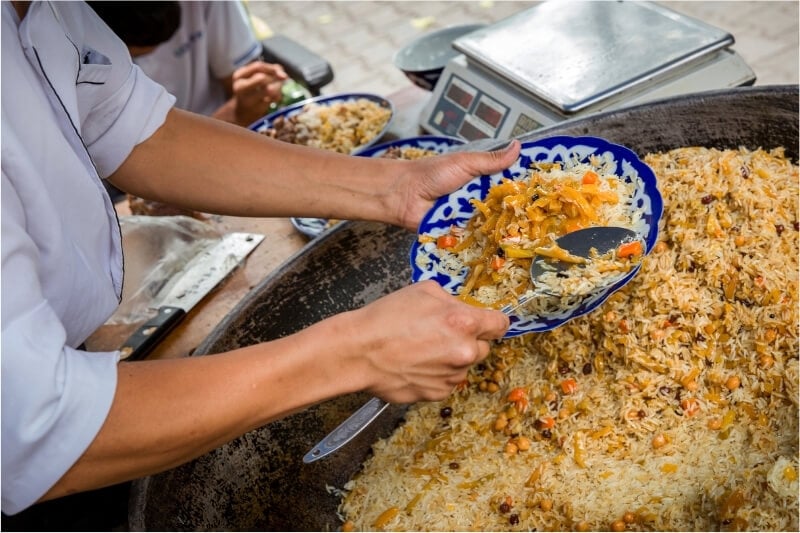
It’s hard to experience Central Asia without coming across the traditional delicacy of plov ( palov ). In Uzbekistan, plov is served at any and all occasions and is available in every city and every tiny village. The dish consists of pilau rice with spices, vegetables, meat and sometimes raisins and berries cooked in a large pan, sometimes big enough to feed hundreds of people at weddings or funerals.
No two plovs are the same. The delicate mix of ingredients used is unique to each cook – although they can start to feel quite similar after plov for breakfast, lunch and dinner during your time in Uzbekistan! But this is how it was intended.
The legend of plov says that Alexander the Great invented it himself as a way for his troops to cut back on meal times and eat the same thing three times a day!
Plov was given Heritage Status in 2016 when it was recognised for its significance to Uzbekistan culture . While it is specific to Uzbekistan, there are very similar variations available in neighbouring countries.
Try it for yourself: Undoubtedly the best place to experience plov is at the Plov Centre in Tashkent . The entrance to this large dining hall is flanked by huge pans. The quantity of plov is so vast, hundreds of people turn up every day to sit down for a meal or simply fill a pot to take home.
By Rohan & Max from Travels Of A Bookpacker
28. Oshi Palav in Tajikistan
Tajikistan’s oshi palav is closely related to Uzbekistan’s plov – in fact, both rice-based dishes were inscribed by UNESCO in the same year. In Tajikistan, oshi palav is known as a ‘dish of peace’ for the role it plays in bringing people from different backgrounds together.
Up to 200 varieties of oshi palav are thought to exist. The most basic rendition is made with lamb, rice, onions and carrots simmered in a broth. Prepared in vast quantities ahead of social gatherings, oshi palav is traditionally eaten at events that mark significant life milestones, such as weddings and funerals.
Whether it’s prepared in private homes or teahouses, cooking is usually accompanied by socialising and singing, which adds to the dish’s food culture. Eating oshi palav with one’s hands from a communal pot is similarly symbolic of kinship and community.
The techniques involved in making oshi palav are passed down through the generations. According to UNESCO, once an apprentice masters the art, he or she is given a special skimmer utensil, while the master who trained them is invited to don a ceremonial skullcap.
Tajik oshi palav and Uzbek plov share common attributes with Indian pilau , Persian polow, and even Spanish paella .
Try it for yourself: Home-style oshi palav is available in restaurants in Danshube. If you want a large serving for a group, you might have to order in advance.
For a traditional version, try Restaurant Sim-Sim or Toqi Restaurant, where oshi palav is served alongside other Tajik specialities including mantu (dumplings) and qurutob (bread and onions served in a yogurt sauce).
29. Airag in Mongolia

Airag (also known as kumis ) is a fermented dairy product made and consumed throughout the Central Asian steppes. In Mongolia, airag is made by churning fresh horse milk inside a khokhuur , a special vessel crafted from cowhide.
Besides serving as a critical source of nutrition for nomadic communities (it’s rich in vitamins and minerals, and has been shown to kill harmful bacteria and maintain gut health), airag is steeped in history and tradition.
When UNESCO formally added it to the list of Intangible Cultural Heritage in 2019, they also recognised the centuries-old knowledge that goes into preparing it correctly.
Making airag is a slow, energy intensive process that uses a range of tools, including a specially designed paddle known as a buluur. For it to work, the milk must be churned more than 500 times before yeast is added to kick-start the fermentation process.
The finished result is consumed as part of many families’ everyday diet. Airag is also used in religious rituals and cultural ceremonies, which further adds to its significance.
Try it for yourself: If you’re trekking in Mongolia or travelling overland and you wind up staying with local herders, there’s no doubt you’ll get a chance to try airag for yourself. You can sometimes find it for sale in ger (residential districts) as well, even in Ulaanbaatar.
30. Terere in Paraguay

Terere is a special ancestral drink found in the South American nation of Paraguay. It’s closely related to yerba mate , a popular beverage all across the continent.
Terere is prepared using a special blend of Poha Nana (medicinal herbs) crushed and combined with cold water. Each herb has unique healing properties, and the way they’re combined to brew different drinks is part of every family’s tradition in Paraguay.
UNESCO inscribed Terere in 2020 as a result, citing the knowledge about medicinal herbs that’s also shared through the process as particularly important.
Preparing Terere and drinking it through a special straw called a bombilla are Paraguayan traditions that have been part of the culture since at least the 16th century.
Try it for yourself: Sharing a glass of Terere with someone is seen as a sign of friendship, respect and solidarity. If you’re offered a try when travelling to Paraguay, you’d do well to accept! The drink is refreshing and delicious, so you’ll no doubt be seeking it out by the end of your stay.
Have you experienced any of the food culture rituals on this list? What are your favourite culinary traditions around the world?
Global food culture: Save it & share it on Pinterest

28 Comments
Why so many foods from Turkey but nothing from say Peru?
Hi Christian, this post is based on the UNESCO list. There is nothing listed from Peru by UNESCO at the moment.
Super late finding this article but it really is very informative. Awesome job!
I am surprised and sorry that nothing is mentioned about the diversity and richness of Indian food. From the traditional food culture of Kerala (steamed, cooked or roasted on embers without oils or spices) to the rich Panjabi, Kashmiri, north-east, Gujarati and Tamil food cultures, India has an incredible variety of nutritious and medicinal healthy food items, at least some of which should find a place in such a well researched paper on the world food cultures. Regards and Best Wishes to you, Emily
Definitely deserving of a place on the UNESCO List! Let’s hope there is a submission soon.
Agree! Especially Kerala which has its own harvest festival, Onam which is a huge part of their food culture.
also in Sulu Philippines the unique use of burned coconut copra as major ingredient of some foods, like black soap or “tiyulah sug or tiyulah itum”
Dear Emily Nice job, However, I haven’t find any traditional food from Pakistan and Afghanistan, although these countries have rich food culture diversity, specifically in the mountain regions lot of traditional cuisines are prepared by local inhabitants. Hope we can include these also,…
Yes, it would be great if UNESCO included entries for these countries. Let’s wait and see what gets listed in 2023!
where is Panjabi food? Panjabi food is amazing. we eat roti with variety of curries. we like milk and milk products and so many home made dishes are famous in our culture. mustered leafy dish (saag) with makki di roti(maize flour roti) is very delicious.
Kazakh cuisine is very diverse. We have a lot of dishes such as beshbarmaq (meat with jayma, potatoes, qazy, onions, sorpa), bauyrsaq (fried homemade bread)!!!
You are right. What is interesting, our meals are simple to prepare. You should put all ingredients to water and boil it , and that is all(for Beshbarmaq). Bauyrsaq it is just a dough without anything and we just fry it. Simple but very tasty
We also have delicious bauyrsaks. This is the best food in the world!!
This post was truly worthwhile to read. I wanted to say thank you for the key points you have pointed out as they are enlightening.
Would you consider including Irish Stew as of cultural importance?
Hi Donna, great suggestion! For now I am just covering the UNESCO List – let’s see if they add it!
Great list – thanks for sharing! Thinking aloud, India being home to 1/6 th of humanity and the oldest surviving culture in the world, seems most conspicuous in its absence.
Agreed – it would be great to see an entry from India on the list! Let’s hope there is a submission to UNESCO.
Great Post. I had no idea that UNESCO had an Intangible Cultural Heritage list. Thank you,
Best, Radhika Sule Baltimore, USA
HI EMILY, YOU WILL BE SURPRISED TO KNOW THAT I AM A SOCIAL SCIENCE TEACHER IN A SCHOOL IN INDIA AND HIGHLY BENEFITTED BY UR FINDINGS AS IT HELPED ME INCREDIBLY IN FRAMING MY ASSIGNMENTS REGARDING FOOD AND CLOTHING.
That’s great to hear, so glad I could help!
Learnt a lot from this post! Cheers.
Dolma is not Azerbaijani. Dolma exists in other countries in the middle east. Armenia, for example, calls it Dolma and is a traditional cuisine. Armenia uses grape leaves and other vegetables as stuffing. Please don’t label a dish to one specific country since it is a traditional since it is also a dish in other countries. Armenians call it “Dolma” as well, and has been a cultural dish for thousands of years. Dolma is not Azerbaijani, you have written incorrect information.
Thank you for your comment. You’re absolutely right – but in this case, UNESCO attributes the dish ‘dolma’ to Azerbaijan in its list of Intangible Cultural Heritage elements. That’s not to say the dish isn’t eaten in other countries including Greece and Armenia (I’ve had it in Armenia many times!), only that UNESCO recognises the Azerbaijani version specifically. The same is true of lavash, which is considered shared heritage by multiple countries but recognised as part of Armenia’s Intangible Cultural Heritage.
The decision to label a dish specific to one country isn’t mine, it comes from UNESCO. Since this post is designed to explore the UNESCO listings specifically and not food in general, I made the decision to keep the descriptions true to their language.
You can find more information about the inscription process for that dish here: https://ich.unesco.org/en/RL/dolma-making-and-sharing-tradition-a-marker-of-cultural-identity-01188
Faltou a Culinária Brasileira, tão rica e colorida! 🥰
I don’t understnd why not a famous Kashmir Wazwan has not included in the list.
Hello! I’m a Chef in Zambia and i promote Zambian cuisine/culture as well as talk on Radio about Nutrition; Plant based Diets etc. How can I get one of our dishes onto the UNESCO Intangible Cultural Heritage list- we equally have Nshima like Malawi but the array of vegetables is immense and would like to share. Thank you
Hi Kujai! That’s terrific, I’d love to learn more about your national cuisine.
I’m not sure of the exact process, but there may be more information on the UNESCO website. Here is a link to the procedure process: https://ich.unesco.org/en/procedure-of-inscription-00809
Take care, Emily
Leave a Reply Cancel reply
Your email address will not be published. Required fields are marked *
- Subscribe to future posts
Money latest: JD Sports introducing tagging sprays in stores
JD Sports is introducing tagging sprays across its stores nationwide as part of a ramping up of security measures. Read this and all the latest consumer and personal finance news below, plus leave a comment in the box.
Tuesday 30 April 2024 21:02, UK
- State pensions 'could be in doubt for future generations'
- Average UK rents hit new high
- Higher food prices warning as new Brexit checks begin
- JD Sports introducing tagging sprays in stores
Essential reads
- Turns out supermarket boss was right about self-checkouts
- Swap rates are the reason mortgage rates are rising - what are they?
- Gameboys and 1950s furniture: Items in your attic that could be worth small fortune
- Money Problem : 'Builders won't repair dodgy work - what are my rights?'
- '£2,000 landed in my account' - The people who say they're manifesting riches
- Train strikes in May - everything you need to know
Ask a question or make a comment
Taxpayers will be forced to cover £85bn of losses made by the Bank of England on its quantitative easing programme, estimates suggest.
The £895bn bond-buying scheme was carried out between 2009 and 2021, and had aimed to support the UK during economic shocks - but it has been blamed by some for allowing inflation to take root.
Recent chancellors have agreed to indemnify the Bank against any losses on the scheme - meaning the taxpayer will be paying for them.
Greene King is moving from its 200-year-old brewery in Bury St Edmunds.
The pub chain will be opening a new £40m facility in a town that will produce more modern, fizzy craft beers alongside its traditional cask ales.
The majority of Greene King's brewing will be moved to the new site, as part of a wider shift away from traditional cask beers.
It will take about three years to complete.
Butlin's has launched legal action against its insurance company Aviva over who foots a £60m bill.
The holiday park operator's Minehead resort was forced to close in September 2023 because of flooding caused by heavy rainfall.
It has said the incident cost the business £60m and has filed a claim at the High Court against Aviva for not covering the entire bill.
In legal documents seen by The Telegraph , Butlins have questioned the definition of a "storm" and argued that a "named storm" had not been declared when the flooding happened.
Oil traders working for the US firm Exxon Mobil Corp in Brussels could lose their job if they refuse to move to London, according to reports.
Under the new proposal employees moving to the UK capital would be expected to be in the office five days a week.
But traders working for the oil giant said in an internal union-led survey they did not want to move to London due to "uncompetitive" pay and a "lack of flexibility", a union statement reads, according to Bloomberg .
Up to 37 trading employees now face having their contracts terminated as a result of this.
ExxonMobil has said it "remains open to resolving the situation".
The sports retailer is introducing tagging sprays across its stores nationwide as part of a ramping up of security measures.
It will start using SelectaDNA sprays, which can be misted on property and criminals.
The sprays work by leaving a synthetic DNA and UV marker which does not wash off and can be used to link assets to owners and criminals to crime scenes.
JD Sports said the measure was in response to a significant increase in shoplifting in UK.
In particular, it said it had seen a rise in "steaming" - where large gangs run into stores, threaten staff with violence and then run off with armfuls of stolen products.
The SelectaDNA spray reportedly does not cause any harm or damage to skin, clothing or property.
Lidl plans to open hundreds more supermarkets across Britain.
The German discount chain, which is now the UK's sixth biggest supermarket, is targeting thousands of new shoppers as it continues its expansion.
It currently has about 960 stores but is targeting more than 1,100 across England, Wales and Scotland.
In the coming months, the chain will welcome shoppers to new stores across the country, from Bristol, Birmingham and Berwick in Scotland.
In London, it will be opening new stores in Wandsworth, Fulham, Hoxton and Canning Town.
But it says it is eyeing growth in more locations. If it successfully finds a good location, it is willing to pay a finder's fee of 1.5% of the total freehold purchase price, or 10% of the first year's rent for leaseholds, which would equate to £22,500 for a completed £1.5m site purchase.
A finder's fee can be paid to any member of the public who identifies a suitable site for it to open a new store.
Richard Taylor, Lidl Great Britain's chief development officer, said the company was "continuing to invest in new locations whilst exploring innovative routes to expansion".
"As we look ahead, we're excited to welcome even more new shoppers to our existing stores, as well as those we're planning to open across the country in the coming months and years," he said.
Mortgage approvals rose to 61,300 in March - the highest number since September 2022.
They had been at 60,500 in February, according to the Bank of England.
While this is positive, industry experts are reporting that uncertainty over the direction of interest rates this year is prompting caution.
Mortgage rates have risen in the last few weeks as markets went from pricing in a base rate cut in June to thinking it may be August.
US inflation proving stubborn has led to concern here that the path to the 2% target may be bumpy - meaning the base rate may have to stay high in order to constrain spending and thus ease price rises.
Forecasts of three cuts this year from the current 5.25% have been scaled back to two.
Hina Bhudia, partner at Knight Frank Finance, said: "The sun is out and buyers are returning from their Easter break, so we'd usually expect these to be the busy weeks before the summer; however, the uncertain outlook for mortgage rates will undoubtedly weigh on activity.
"It's not just buyers that are frustrated. The lenders are eager to rebuild their businesses after a subdued 2023; however, they are constrained by stubborn inflation and the resulting impact on their cost of funding."
Following Sainsbury's boss Simon Roberts' claim that Britons like self-checkouts...
...we asked Money blog readers, and followers of our LinkedIn page , for their views.
While our inbox was filled with a lot of hate for self-checkouts, our poll of 2,613 people on LinkedIn shows that, overall, Mr Roberts was right...
We have rounded up some of your views here...
Self-checkout is the worst thing to ever happen. Standing like a child with your hand up, one person running up and down to deal with this, underpaid and understaffed. Janice Karaaziz, Money reader
I'll go out of my way to find a cashier, largely because my five-year-old will make a beeline for pressing the scales. I've noticed my local store having fewer and fewer cashiers on - and on many occasions there have been none. We need to think about inclusivity here. There will be some customers who will need a cashier for various reasons, so would expect there to always be at least one on, so stores are accessible for everyone. KaraS, LinkedIn
I try and limit my social interactions as much as possible, out of choice, so most of the time self-checkouts are convenient. Alasdair Corton, LinkedIn
They induce a level of irritation. Sometimes I can be heard answering them back. In general I choose to have my items flung at me by Lidl checkout staff. Siobhan W, LinkedIn
Self-checkout provides a great alternative to customers, especially those with smaller quantity purchases, but personally I think it's sad to see them dominate the front of Sainsbury's stores. In my opinion, it's the removal of one of the greatest ways to provide good customer service. Tom Tregay, LinkedIn
Self-checkouts are great, I will always choose to use one instead of a normal checkout. Some are easier to use than others, the Co-op and Tesco have easy-to-use interfaces whereas Morrisons is a bit more complicated. They'll evolve over time and there's always staff to help out. CG, LinkedIn
They're useful, but when they trigger a "basket check" on nearly every single shop, they begin to lose attractiveness Nicola Bradley, LinkedIn
I tend to argue with them lol. Especially when I can't get it to scan a particular item or you need approval for something so you have to wait for assistance anyway! Plus as a disabled customer I have to juggle my crutch, shopping, scanning and packing. With reduced staff in shops you can't always get the help you actually need. Elizabeth Graney, LinkedIn
Definitely not. So when I go to Sainsbury's I see a lot of older people and no way do they want to use self-checkouts. My mother lives in assisted living and all of them say they hate them. Get a grip, Simon - they are not faster, they are saving you employing more staff. I know my aunt has stood at an Asda til they put a staff member on there. Andrea Robinson, LinkedIn
Robots should never replace humans. Interaction is essential... if machines replace people no one will work, it's a crazy dangerous road. Nicola van Eerten, LinkedIn
The self-checkout is a money-saving exercise. They cut back everywhere. No staff on the shop floor to help. Paper bags in the veg section now cost 30p - for absolutely no reason. Mark, Money reader
Average advertised rents have hit a new high in the UK, according to Rightmove .
Across Britain, excluding London, the average monthly rent being asked for a property coming on the market in the first quarter of 2024 was £1,291, the property website found. This was 8.5% higher than a year earlier.
The average advertised rent in London also hit a fresh high in the first quarter of 2024 at £2,633 per month but this was just £2 higher than the average asking rent in the fourth quarter of 2023.
While average rents have climbed, the property website says there are signs that the pace of the increases is slowing.
There are also indications that more landlords are having to reduce their asking rents, particularly for bigger homes, to meet what tenants can afford.
Rightmove's director of property science, Tim Bannister, said the rental market was "no longer at peak boiling point" but it "remains at a very hot simmer".
By James Sillars , business reporter
The index rose by 0.3% to 8,174 points at the open.
Only real estate stocks were proving any kind of drag.
Among the companies leading the gainers was HSBC.
It climbed by more than 2.6% in London after the Asia-focused bank announced a rise in shareholder awards despite a slight drop in quarterly profits.
The share price reaction also reflected news that chief executive Noel Quinn is to retire - read the full story of that here ...
Among the other gainers in early dealing was Whitbread.
The Premier Inn owner's annual results revealed a sharp rise in annual profits but also a new focus on hotel investment at the expense of its restaurant brands.
That was placing 1,500 jobs at risk, it warned - read the full story here ...
By Jess Sharp , Money team
We first came across Tom McPhail when he posted this on X...
The pensions expert appeared to be suggesting state pensions were at risk of disappearing.
After speaking to him on the phone, he confirmed that was exactly his concern, warning something needed to be done sooner rather than later to avoid a "catastrophic" situation.
He described state pensions as a social contract – each generation pays taxes and national insurance, which funds the pensions of today's older people, and they hope the following generation will do the same for them.
But with population growth slowing, there's a worry there may simply not be enough people to keep the system afloat in the future.
"There's a significant demographic shift going on in the UK. It started before the Second World War, cohorts of people born in the 1930s have been experiencing significantly longer lives than was the case prior to that, so people now in their 80s are living quite a lot longer," he said.
"But at the same time, we've got fewer children coming through. And so this exacerbates the shift in the age of the population."
He said if he was 20 today, he would be "sceptical" about the promise of a state pension because he isn't sure how it's going to be paid for.
At the moment, the state pension system costs around £120bn a year and more than half of retired people rely on it to make up at least 50% of their income, he added.
Over the next 50 years, Tom predicts the proportion of GDP the state spends on older people will increase from around 16% to 25%.
"I hesitate to use the word unsustainable, but it will certainly start to look challenging," he said.
"If we suddenly switched off the state pension or significantly reduced it, people would be in trouble, so the government can’t do that.
"You can't keep on progressively ratcheting up a more and more generous state pension. The costs of state pensions is going to become increasingly difficult for the younger cohorts to bear."
He pointed to a few ways to potentially salvage the state pension – policy change, more babies being born or people working until they are in their 70s.
"Politicians are going to have to make decisions about how to get out of this kind of political bind," Tom added.
"Time and time again it's just kick the can down the road on the pension question, just put a sticking plaster on it and let the next government deal with the problem.
"You can't keep doing that. So I would really like to see, on the other side of this forthcoming general election... whoever's in power, in collaboration with whoever's in opposition, to just really open it up to some honest conversations about where the demographics are going to take us."
He does note there is one piece of good news: "This happens quite slowly, so we do have time on our side."
Basically, swap rates dictate the pricing of fixed-rate mortgages.
Lenders, such as banks and building societies, borrow in order to lend.
They borrow from financial markets and often these transactions are made using Sterling Overnight Index Average (SONIA) swap rates, which can move around.
By contrast, most domestic mortgages are set on what is known as a "term" rate – in other words, the borrower knows how much interest they will be paying for a set period of time.
To avoid a situation where the SONIA rate goes above the rate it is charging borrowers, which would leave the bank or building society lending at a loss, the lender will seek to enter a "swap" arrangement which protects them from such a situation.
Under such agreements, two parties exchange cash flows with each other. The lending bank will swap the variable payments it may make to service a mortgage (which is fixed to the SONIA rate) for payments at a fixed rate. This insulates the lending bank from unexpected increases in the SONIA rate.
Once a deal is struck based on the swap rate, mortgage providers set their fixed deals for customers, with their own profit margin priced in.
How are swap rates decided?
Swap rates are based on what the markets think will happen to interest rates in the future.
When they go up, so do the rates being offered on the high street, as we have seen in the last week or two amid uncertainty over whether forecasts for a summer base rate cut are accurate.
Read other entries in our Basically... series:
Be the first to get Breaking News
Install the Sky News app for free


IMAGES
VIDEO
COMMENTS
Food tourism is a vitally important component of the travel and tourism industry as a whole. When booking a trip, people tend to consider a variety of factors - and food is high on the list of priorities. The World Food Travel Association says that money spent on food and drink while travelling accounts for 15-35% of all tourism spending.
This type of tourism is known as food tourism. It's also called culinary tourism or gastronomy tourism. Food tourism can take many different forms. It can be as simple as trying a new dish while on vacation, or it can involve planning an entire trip around visiting different restaurants and food festivals (8).
Famous cultural tourism places are:-. India - Durga puja in Kolkata, Temples at Banaras, Jaipur, known as the pink city Palace in Rajasthan. Forts and monuments in Delhi, Agra, UP. UK - Tower of London, The British Museum, Big Ben, London Durga puja, etc. Kenya - The main attraction is the dance of the Maasai tribe.
In the beginning, we defined food tourism as "The pursuit and enjoyment of unique and memorable food and drink experiences, both far and near." (Erik Wolf, Executive Director, Culinary Tourism: A Tasty Economic Proposition, 2001). This was our industry's first white paper that explained what food tourism is and how it can benefit industry ...
It is related to all activities that use food as a means of connection between people, places, and time. Food tourism is composed of activities that provide experiences of consumption and appreciation of food and beverages, presented in such a way that values the history, the culture, and the environment of a particular region. Food'n Road.
The compound annual growth rate for food tourism is expected to increase by 9% between the years 2019-2023 according to a recent report by Technavio, a market research company in the United Kingdom. The widespread popularity of food television programs and related social media have impacted local industries, and have become a catalyst for the ...
Definition and Scope. Culinary tourism, also known as food tourism or gastronomy tourism, taps into the desire to explore a culture through its flavors. Your culinary adventures can range from local cooking courses to winery tours, encompassing any travel experience where the primary goal is to discover new tastes and food traditions.
As food tourism includes learning from different cultures, the food tourist seeks experiences on local identity and authenticity. Food tourism has a physical presence. From a cultural perspective it is the behaviour, knowledge and customs of location that combined and thus it creates a sense of place and identity.
Culinary tourism. Culinary tourism or food tourism or gastronomy tourism is the exploration of food as the purpose of tourism. [1] It is considered a vital component of the tourism experience. [2] Dining out is common among tourists and "food is believed to rank alongside climate, accommodation, and scenery " in importance to tourists.
Gastronomy is about much more than food. It reflects the culture, heritage, traditions and sense of community of different peoples. It is a way of promoting understanding among different cultures, and of bringing people and traditions closer together. Gastronomy tourism is also emerging as an important protector of cultural heritage, and the ...
In the foods model, there are four types of food: (1) core foods; (2) complementary foods; (3) secondary foods; and (4) peripheral foods. ... The report reveals the new trend in food tourism and movements from different types of entities, namely destination management organizations, business organizations, and education organizations.
The kinds of food and beverage based activities food tourists are most likely to participate in ... Variations in data on food tourism can often be due to different definitions and scopes used for the research. Later in this report, we will provide data on these three ways of counting food tourism.
This company offers different food experiences, including three-and-a-half-hour food tours, which promote "a unique, immersive and authentic experience of fascinating Lisbon" (Taste of Lisboa Food Tours, 2021). This study analyses visitors' discourses regarding these food tour experiences as well as the tour organizer's view of this ...
People are seeking different kinds of food consumption experiences, from ingredients to service delivery, while traveling locally and internationally. Besides technology, sustainability is also a central issue in food tourism. Today, alternative food products such as plant-based proteins can be found much more easily in the market.
Introduction. Food is increasingly becoming a central aspect in staging memorable experiences within the tourism and hospitality sector (Kunasegaran et al., 2019; de Albuquerque Meneguel et al., 2019; Cetin et al., 2019), and it is a major motivation for traveling (Okumus et al., 2021; Chang et al., 2020).Food is therefore important for at least three different sets of reasons.
Food tourism, like other segments of the sharing economy, will need to pivot to survive the travel restrictions and economic downturn related to the coronavirus pandemic.
4. Cherry Blossom Festival - Japan: While not exclusively a food festival, the Cherry Blossom Festival, also known as Hanami, is a significant event in Japan, celebrating the blooming of cherry blossoms in spring. During this time, people gather under cherry blossom trees to have picnics and enjoy various traditional Japanese foods and snacks. 5.
The food tourism industry is creative and aware of the interests of travellers. Best of all, it is a democratic and flexible way of travelling. Nowadays, you can easily explore a gastronomic culture in different ways: in the countryside or in the city, individually or in groups, with luxury, with adventure.
Visit Fairs and Local Markets. A classic example of a food tourism activity. Visiting markets and fairs are an excellent way to try ingredients and learn about the region's biodiversity while interacting with producers and the local community. Visits can be made independently or guided.
A Different Kind of Food Tourism. Between-meal diversions in Paris, New York, Hong Kong, and more Culture; Features; Personal Essays; By Allie Wist. Published on March 5, 2015. ADVERTISEMENT AD. AD.
Different Types of Food Tourism. While there are different types of food tourism, the most common activities include the following: Cooking Classes - Taking cooking classes is a growing trend in food tourism. This involves taking short lessons that can last a few hours or an entire day. In some cases, culinary schools offer courses that run ...
30 examples of food culture: Culinary traditions recognised by UNESCO. 1. Ukrainian Borscht (Inscribed in 2022) 2. Baguette bread culture in France (Inscribed in 2022) 3. Al-Mansaf in Jordan (Inscribed in 2022) 4.
Uji produces three different types of green tea - matcha, sencha, and gyokuro. Matcha is ground tea powder that is used for traditional tea ceremonies. Currently, it's popular in foods such as soba, ramen, and desserts, for added flavor and vibrant green color. Sencha and gyokuro are chopped up tea leaves and consumed in tea.
The National Tourism Debate Finals || April 29, 2024 Sectoral Debate • Opening of Sectoral Debate - Hon. Edmund Bartlett, CD, MP, Minister of Tourism...
Only real estate stocks were proving any kind of drag. ... Members of Aslef union at 16 rail companies will walk out on different days from 7 to 9 May. ... such as its BBQ food offering, or type ...